











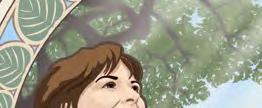



































































































































































































HSA Board of Directors
Susan Liechty President
Rae McKimm Vice President
R ie Sluder Secretary
Linda Lange Treasurer/Finance
Pat Greathead Central District Membership Delegate
B onnie Great Lakes District Porterfield Membership Delegate
Cindy Meier Mid-Atlantic District Membership Delegate
J en Munson Northeast District Membership Delegate
S ara Holland South Central District Membership Delegate
P.J. Stamps- Southeast District
K itchen Membership Delegate
J ody Lacey West District Membership Delegate
Jackie Johnson Publications Chair
K aren O’Brien B otany & Horticulture Chair
C arol Schmidt D evelopment Chair
Dava Stravinsky Education Chair
Pat Sweetman M embership Chair
D ebbie Boutelier Nominating Chair/Past President
D ebra Knapke Ho norary President
K atrinka Morgan E xecutive Director
Administrative Staff
K atrinka Morgan E xecutive Director
L aurie Alexander M embership Coordinator
Christina Wilkinson Librarian/Archivist
K aren Kennedy Ed ucation Coordinator
Amy Rogers O ffice Administrator
K aren Frandanisa Accountant
Brent DeWitt Editor/Designer
The Herbarist
Brent DeWitt Editor/Designer
SP Mount Printing Printer
The Herbarist Committee
Jackie Johnson Publications Chair
Lois Sutton, Ph.D. Chair
Jean Berry
Shirley Hercules
Pat Larson
G ayle Southerland
B arbara Williams
The opinions expressed by contributors are not


This issue of The Herbarist celebrates The Society’s gardens, gardeners, educational programs, and especially, The National Herb Garden. Herbs enrich and enhance our lives. An herb garden intertwines the worlds of cooking, gardening, healing, and history. The lives of The Society’s members have all been touched in one way or another by herbs.
We celebrate the 35th anniversary of the National Herb Garden with the history, a photographic tour of the seasons, and an interview with three past curators. Learn about the living collections policy and how it affects the National Arboretum’s past, present and future of plant materials.
Gardens hold the power to captivate our attention no matter the size. The Gardens of The Herb Society of America is a recent signature program to emphasize the value we place on one of our most important community outreach efforts, HSA’s unit herb gardens. The many gardens featured in this issue will take you on a journey across the country.
If you are looking for ways to make your own garden more earthfriendly, read about the native herb conservation program, GreenBridges. This program brings awareness to native plants and demonstrates how to create spaces for pollinators to live and thrive.
There is something reassuring about herbs. They are predictable, reliable and timeless. Anne Abbott shares her many years of experience with the plant collections held by HSA members around the country. See why we are so proud of our collections, and how you can continue to help support these wonderful botanical gems.
A garden can be a state of mind as well as a place to be — those of us who love the garden somehow manage never to forget that. Beth Haebel shares her experience of visiting an herb garden early in her life. We find such wonderful people and experiences in a garden.
If you think your treasured herbs can educate only in their garden settings, read “Get Ready, Get Set and Show” Elizabeth Kennel covers all the aspects of flower and herb judging, giving you tips for winning that blue ribbon.
The Herbarist 2015 demonstrates to all of us, especially the next generation of gardeners, how one’s actions today can positively affect the future. Who would have thought over 35 years ago that an idea planted in the minds of several dedicated and passionate Society members would become the National Herb Garden that we know and love. The Herb Society of America will remain a leader in the herb world as long as we keep our roots firmly planted and continue the time-honored tradition of herb gardening.
Susan Liechty HSA President, 2014–2016
3 Issue 81 2015
necessarily those of The Society. Manuscripts, advertisements, comments and letters to the editor may be sent to: T he Herbarist, The Herb Society of America 9019 Kirtland-Chardon Rd. Kirtland, Ohio 44094 440.256.0514 www.herbsociety.org T he Herbarist, No. 81 History of NHG . . . . . . . . 4 By Sandy Salkeld de Holl Value in the Genes . . . . . . . . 8 By Scott Aker NHG Photo Gallery . . . . . . . . 13 By Pat Kenny Integrity and Outreach: Building a Strong Foundation for the National Herb Garden . . . . 18 By Chrissy Moore A Conversation With Past NHG Curators . . . . 26 By Holly Shimizu, Jim Adams, Janet Walker Under the Arbor: An NHG Educational Series . . . 30 By Billi Parus, Chrissy Moore Plant Collections of The Herb Society of America –2015 . . 33 By Anne Abbott GreenBridges: A Way of Life . . . . . . 40 By Lorraine Grochowski-Kiefer Promising Plants –Where Are They Now? . . . . 44 By Karen Kennedy Learn, Explore, Grow –Visit the Units’ Gardens! . . . 47 By Lois Sutton Ph.D. Pharmacy Garden . . . . . . . . 54 By Henry Flowers Herb Gardening in Large Public Venues . . . . 58 By The Herbarist Committee A Lesson in Taxonomy in a Public Herb Garden . . . 64 By Barbara J. Williams Get Ready, Get Set, Show! Going For The Blue At A Flower Show . 71 By Elizabeth Kennel On the cover: Back to the Garden by Brent DeWitt, Editor Digital Illustration Welcome toThe Herbarist! It is the policy of The Herb Society of America not to advise or recommend herbs for medicinal or health use. This information is intended for educational purposes only and should not be considered as a recommendation or an endorsement of any particular medical or health treatment.
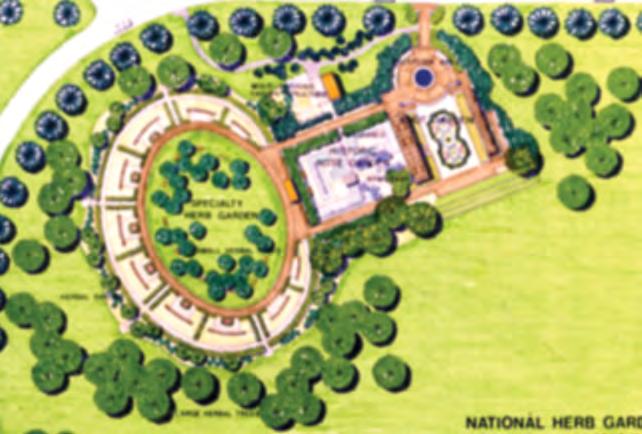
very special seed was sown in 1957, when Mrs. Foster Stearns, then editor of The Herbarist, wrote “My dream for the future is that some day we can have a national demonstration of some sort, in some central spot, and
garden. She had chaired the Western Reserve Unit while they were establishing a garden at the Garden Center of Greater Cleveland, now the Cleveland Botanical Garden. This experience served her well as she held many consultations with lawyers

The National Herb Garden–Years and Still Growing!
Sandy Salkeld de Holl
It is the largest designed herb garden in North America . It has been called a jewel in the crown of the United States National Arboretum in Washington, D .C . It is a true national treasure
It is the National Herb Garden, and it was given by The Herb Society of America to our nation to celebrate the Bicentennial
As we celebrate its 35th Anniversary, we should reflect on how it all began .
bring our many varied gifts of specialized knowledge and talent to bear. With everyone contributing we may really surprise t he world.” Many did contribute in countless ways, but the seed lay dormant for almost ten years.
In 1966, HSA president Edna Cashmore said, “It has long been a dream of mine to establish an herb garden at the United Nations.” She continued to pursue this as chairman of a specially formed HSA garden committee. Later that year the committee learned that there were plans to develop demonstration gardens at the U.S. National Arboretum. The arboretum director, Dr. Henry Skinner, informed the garden committee that they could proceed with plans and designs for about one acre, on any of several sites. The HSA board accepted the project at their April 1967 meeting. Our special little seed had begun to germinate albeit very slowly. The committee developed a garden plan that included planting advice. It soon became clear, however, that The Society would have to provide the funds for construction.
Genevieve Jyurovat, HSA President from 1974-1976, was very knowledgeable about legal arrangements for a large public
United States.”
Our little seed again began to stir. The Society was fully committed to the National Herb Garden project and to all the many pieces involved in putting it together. Mrs. Jyurovat stated in the April 1976
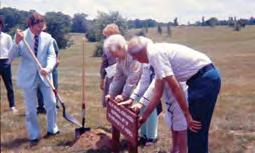
and federal officials during her frequent trips to Washington on behalf of the herb garden. Mrs. Jyurovat was recognized for her huge contribution to this project when she was awarded a Certificate of Achievement in 1987.
Ultimately, a bill was sent to Congress that, for the first time, would permit the United States Department of Agriculture (USDA) to accept fully tax-deductible gifts on behalf of the National Arboretum. The Senate passed it on July 25, 1975 and the House followed on November 4. Meetings resulted in an agreement between The Society and the Agricultural Research Service (ARS).
Society President Genevieve Jyurovat and the First Vice-President Elizabeth 'Betty' Neavill signed the agreement January 21, 1976. It was approved by leaders of USDA and ARS in February 1976. The agreement states in part, “The parties to this agreement desire to make arrangements of the design, construction, development, maintenance and preservation of a National Herb Garden on the grounds of the United States National Arboretum located in Washington, D.C. for their mutual benefit and the benefit of the people of the
Department of Agriculture’s newsletter, Research News, “It is particularly appropriate to initiate such a Garden in connection with America’s Bicentennial. An Herb Garden at the Arboretum will sum up the long contribution herbs have made to America’s well-being, pleasure and commerce and serve as an introduction to their new role in science. It will be a teaching garden, an historic garden and a garden of the finest in design and planting. Above all, it will be a garden of inspiration and continuity and affection. Each ethnic group will discover something of its heritage here, and just as America brought a diversity of people together and enriched their lives by their being together, so will the National Herb Garden.”
The ARS chose a site next to the administration building at the arboretum. Because of this location, the designated garden site was a little more than two acres. The ARS agreed to provide utilities for construction and maintenance, to provide background plants as available, to arrange for the construction and supervision of these to assure completion of the garden, and to provide labor and other services for the maintenance of the garden. The Society
4 5 The Herbarist issue 81 2015
Lef T L–R 'Skip' March (Supervisory Horticulturist for the U.S. National Arboretum), Betty Rea, Dr. John Creech (Director of the Arboretum) and Tom Wirth (Landscape Architect for Sasaki Assoc) review the site plans for the National Herb Garden. A B O ve: HSA group placing the initial site location sign for the National Herb Garden (including edna Cashmore center)

shouldered the responsibilities for contributing funds for the construction and development of the garden; for consulting in the design, planting and construction of the garden (along with the ARS); and for selecting and paying a landscape architect. The architect’s charge was to prepare detailed plans, specifications, cost estimates, and a timetable for the completion of each stage of construction. A concept plan had been prepared for the garden by Elsetta Barnes, an HSA member and a landscape architect, who had designed the Western Reserve Garden. Unfortunately, she could not continue the project and The Society selected Thomas Wirth of Sasaki Associates in Watertown, Massachusetts.
Katharine T. Patch., another member of Western Reserve Unit, chaired the committee to raise initial funds. Genevieve Jyurovat, Edna Cashmore and others attended a ground-breaking ceremony in June 1976. A job sign now identified the site as the future National Herb Garden, noting that this garden was a Bicentennial gift from The Herb Society of America to the nation. Our special seed had found its garden home.
At this time The Society presented a check for almost $18,000 to the Director of the Arboretum, Dr. John Creech. The initial proposed fund drive to raise $200,000, with a matching amount to be provided by the government, soon became woefully inadequate due to ever-rising costs. The Society agreed that fund raising should be organized by its members, avoiding paying large consulting fees to professional fundraisers. Booker and Mary Worthen became treasurers of the National Herb Garden Fund while Roland and Ruth Remmel assumed the task of raising $400,000. When nearly half this amount
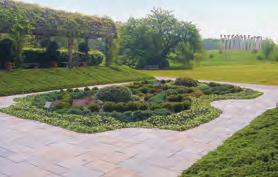

Herb Garden fund.
The garden plan is key-shaped— with specialty gardens forming the head, a historic rose garden the shank, and the knot garden with the reception area above, the bit. The key symbolically opens the door to education, beauty and the sharing of herbal knowledge.
had been raised, HSA went outside the organization and published articles in many newspapers and magazines throughout the country, raising more funds. HSA president Betty Rea met with the Secretary of Agriculture and, in March 1978, appeared before the Appropriations Subc ommittee of Agriculture, Rural and Related Agencies. This committee was chaired by Jamie L. Whitten, Congressman from Mississippi. The Society requested a government appropriation of $200,000 to match our contribution to the National Herb Garden. We had already raised nearly that amount. While the federal funds were a lready in the Agricultural Appropria-tions, they had been dropped due to President Jimmy Carter’s demands for economy and budget cutbacks. Enter the intrepid Mrs. Rea who regularly visited congressmen
a nd lobbied to have the funds restored. Armed with her basket of tussie-mussies (freely distributed), her ready smile and her charming gift of persuasion, she became known to the guards and was even given a temporary parking place at the Capitol.
At last, in October 1978, the appropriations bill was signed by President Carter, including the restored funds for the garden. A bulldozer, with a tussie-mussie attached to the mirror for luck and Mrs. Rea on board, broke ground for the garden. Our special seed had finally broken dormancy and was above ground!
As this was going on, the National Herb Garden committee met at the arboretum and decided on basic plantings and titles for the ten specialty gardens— Dioscorides, dye, colonial, Native American, medicinal, culinary, industrial, fragrance, oriental, and beverage. Using authoritative references, the plant lists give exact landscape descriptions and uses for the plants. The garden plan is key-shaped with specialty gardens forming the head, a historic rose garden the shank, and the knot garden with the reception area above, the bit. The key symbolically opens the door to education, beauty, and the sharing of herbal knowledge.
The National Herb Garden was dedicated on a lovely summer evening, June 12, 1980.
The U.S. Marine Band provided music, Dr. John Creech, Director of the Arboretum, greeted attendees, and Ann Burrage, one of the seven founders of The Herb Society of America, presented the National Herb Garden to the people of the United States.
Joan Mondale, wife of the Vice-President, accepted the garden for the American people. Mrs. Burrage said the occasion was “the Mt. Everest of my life.” Other speakers were two staunch supporters of the NHG,
The Honorable Bob Bergland, Secretary of Agriculture, and The Honorable Jamie L. Whitten, Congressman from Mississippi.
The final fund-raising report was submitted in 1982 after all pledges had been paid in full. The effort spearheaded by the Worthens and Remmels raised $419,361.69. What a monumental achievement under their leadership along with the support of many dedicated members and friends!
The Society has been so fortunate to work with the NHG Curators employed by the arboretum. There have been four— Holly Shimizu, Janet Walker, Jim Adams, and Chrissy Moore. Each has given their special expertise in caring for and planning the future of the garden. They have given lectures, workshops, answered countless questions from visitors, and corresponded with herb lovers around the world. They have visited many units and members at large making it possible for those who cannot visit the garden to still feel a part of it.
The curator cannot possibly maintain the garden alone. The HSA supports a garden fellow to assist the curator. This has been made possible through contributions to Friends of the National Arboretum (FONA) and to the HSA National
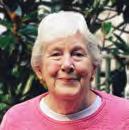
A fter partial contributions for some years the Fellow is now fully funded by contributions from members. Also key to keeping t he garden pristine at all times is a cadre o f volunteer s some from the local community, some HSA members at large, and some from the National Herb Garden committee composed of one member from each unit located within a day’s drive of the garden. Many members participate in “Under the Arbor” programs, given in good weather. These programs (described more fully elsewhere in this issue) may be demonstrations and/or hands-on herbal workshops. All are educational, very popular, and fun for visitors.
An article in The Herbarist of 1980 by Carolyn Cadwalader, then chairman of the National Herb Garden committee, states, “The National Herb Garden is the culmination of many years of cooperative effort from public and private sectors of the United
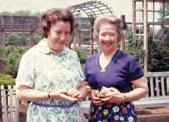
States. The Herb Society of America provided t he original drive, selected one of the top landscape designers in the country, raised most of the money from small contributions of interested individuals in The Society, and combined its collective knowledge in the growing and use of herbs, and in research and horticultural wisdom.” The previous year, HSA president Eleanor Gambee said, “To laud the few who initiated this project or those who struggled with its progress over the intervening years would be to discriminate against the hundreds of dedicated members who also have worked toward the achievement of establishing the finest herb garden in the world.”
Our special seed is now a flourishing herbal tree. Its branches are strong because of the dedication of our members; it is recognized around the world. Hopefully its seeds will germinate and develop into strong branches of herbal knowledge for generations to come.
In her 1983 garden chairman’s report, Henrietta Truitt summed up the feelings of HSA members for the National Herb Garden, “Our name, and our national and international image are represented in our Garden. We want to maintain it as we w ish it to be maintained and take pride in what it represents to the public. For, what is a garden? First, it is made of dreams and plans; second, it is the plants themselves, and last but not least, it is the one who loves and tends it.”
That would be the members of The Herb Society of America.
Happy 35th Birthday — From the HSA to the USA!
Sandy Salkeld de Holl has been an HSA member since 1981. She is a member of the Philadelphia Unit, where she served as chair, and the North Carolina Unit. Sandy was the first Mid-Atlantic District membership delegate and has chaired the National Herb Garden committee. To celebrate the NHG’s 25th anniversary she began a “25 for 25” campaign that, with the support of many units and members, raised over $25,000 for the National Herb Garden. for this effort she was honored with an HSA Certificate of Achievement. Sandy has been an active volunteer at The Philadelphia flower Show for over 40 years. She presently serves as Chair of Judges Activities. Her love of gardening follows her to North Carolina where she is a member of the Porters Neck Garden Club and the Cape fear Garden Club.
6 7 The Herbarist issue 81 2015
NHG circa 1979
NHG circa 2007
NHG today
Still Growing!
f om Left: Carolyn Cadwalader and Betty Rea
35 Years and
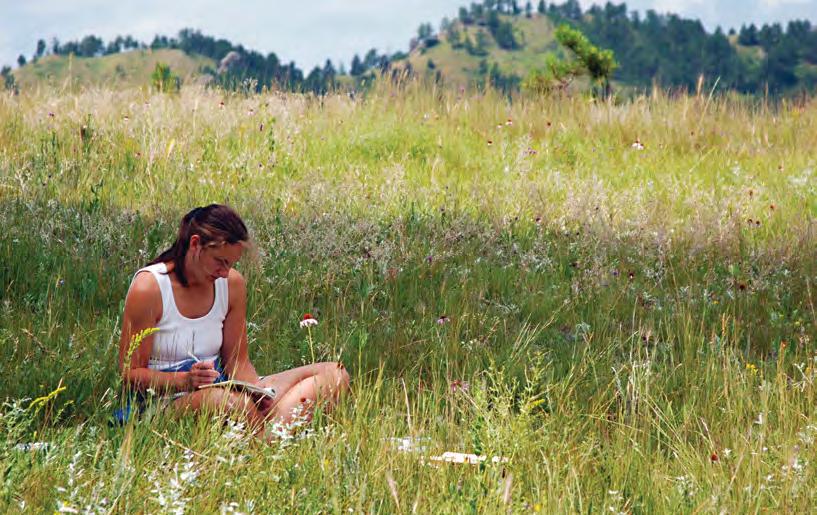
Value inthe Genes
Scott Aker
Most visitors to the U.S. National Arboretum come to see the beautiful gardens that we cultivate, to get some ideas for their own garden, or to enjoy a nice walk. Herb lovers might focus on the ways the plants we display are important sources of flavorings, medicines, beverages, and fragrances. Those with an environmental interest might visit to enjoy the birds and butterflies that live here. However, hidden in plain view among all of these things is the scientific value of the plant genetic resources in our gardens and collections.
both, providing a resource for education and plants that are valuable in research efforts.
The business of developing and maintaining the scientific resource in our gardens is not as straightforward as cultivating gardens for purely aesthetic or educational motives. To maintain plants with scientific integrity, we must carefully select our sources for plants and maintain detailed records relating to those plants.
Just a few years ago, the arboretum adopted a new Living Collections Policy to guide decisions relating to the plant collections at the arboretum. The Living Collections Policy is located at http://www. usna.usda.gov/Information/USNA CollectionsPolicy.pdf. It provides the broad parameters by which new plants will be incorporated in our gardens and collections. At the same time, it provides measures for evaluating existing plants in our collec-
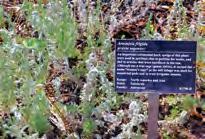
almost never the same throughout its range, this may mean collecting many different accessions of the same species over a broad geographic range. This does not mean that species may only be obtained through the collecting activities of arboretum staff. Seed or plants obtained from other collectors may be used as long as the necessary data were recorded when the collection was made. Generally, this consists of a precise description of the area wherein the plant was collected; a description of the elevation, topography, soil type, and associated plant species at the collection site; digital images of the plant growing in the site, including distance and close up shots; and a dried pressed herbarium specimen of the plant. With all this information, scientists can return to the site to collect from the same population of the plant if needed and they can view morphological details on digital images and on the pressed herbarium specimen to resolve any identity issues that arise and ensure that the seeds from a collection are similar to the original plant when they are germinated and grown into mature plants.
Genetic resources aren’t readily apparent since their essence lies at the cellular level in the DNA of the plants in our gardens and in the detailed records we keep behind the scenes. The U.S. National Arboretum is part of the Agricultural Research Service, an agency of the U.S. Department of Agriculture. As part of the nation’s premier plant research organization, we place great emphasis on the scientific value of the plants in our collections. When the arboretum was established by an act of Congress in 1927, it was created to provide education for the gardening public and conduct ornamental plant research and development. Our gardens do
t ions to ensure that what we already have provides the desired scientific value and for a deaccessioning process when they don’t. With new policy comes change, and the biggest change with the adoption of the Living Collections Policy has been the manner in which we obtain plants for our gardens and collections. The policy recognizes two broad categories of plants with regard to source requirements— species and cultivars.
The guidelines within the policy mandate that species to be added to the collection be collected from wild populations within the natural geographic range of the species. The goal here is to capture the true genetic resource of plants that have not been altered or selected in some way. Since the genetics of a given species are
In the National Herb Garden, a good example of a wild-collected plant is Artemisia frigida, collected in 2011 from a population growing in Thunder Basin National Grassland in Wyoming. It is growing in the Native American theme garden in the National Herb Garden, where it fits because of its use by the Lakota and other tribes as a medicinal plant.
Since cultivars are cultivated varieties of plants, it is not possible to obtain plants of cultivars from wild populations. Instead, the Living Collections Policy mandates that cultivars come from an originating source. This sounds simple enough when you consider some recent cultivars, such as Lavandula ×intermedia ‘Phenomenal’, introduced by Peace Tree Farms in 2012. It gets more difficult when you start talking about cultivars that have been around for decades. Lavandula angustifolia ‘Hidcote’ was introduced by Major Lawrence Johnston of Hidcote Manor in Gloucestershire, England around 1920. After the passage
8 9 The Herbarist issue 81 2015
in the
Our own Chrissy Moore (NHG curator) working in the field
Value
Genes
of all that time, it becomes progressively more unlikely that the original plant still exists. You might think that since cultivars are perpetuated through asexual means of propagation, such as rooted cuttings, that any ‘Hidcote’ would do if we need to add it to our collections. Unfortunately, there is the problem of cultivar drift. Nursery propagators tend to set aside the healthiest of the new plants that have been propagated for use as stock plants for next season’s cuttings, and with this, there is a tendency to select for more robust and vigorous mutations of the mother plant. The difference may be negligible at first, but after generations and generations of mother plants and cuttings, the progeny may be quite different from the original plant. In fact, there is now a cultivar known as ‘Hidcote Superior,’ introduced in 2001, that was selected from cuttings of ‘Hidcote.’ So, getting as close to the original source as possible is important if we are to maintain integrity in our collections.
Sometimes cultivars are nearly impossible to track down. A good example is the double form of tuberose, which is more common than the single form. Polianthes tuberosa ‘The Pearl’ dates back to 1870. It would be difficult to find information about the entity that introduced it, let alone locate the original plant.
Collecting plants in the wild comes with its own limitations. First, we must be able to locate and legally collect plants. Development throughout the world has placed pressure on plant species in the wild, and conversion of wild land into farm fields or homes erases the native flora of a given location. Climate change, invasive plants, diseases, and pests add to that pressure. In most instances, threatened and endangered plants may not be collected, and some may not be transported from point A to point B because of the threat of transporting diseases or pests that are known to be associated with that plant species.
The Convention on Biological Diversity established international regulations on conservation, sustainable use, and fair and equitable sharing of benefits arising from genetic resources. In short, plant and
animal genetic resources are the sovereign property of the country of origin, and access to them requires appropriate approvals and agreements on benefits sharing. Many signatory nations do not issue national permits, or make provisions for open access to collected plant material, and this has effectively ended plant collecting in some countries for us.
The arboretum has participated in collecting trips in China since 1980, as the principal botanical partner in the SinoAmerican Botanical Expedition, and later as part of the North America Chinese Plant Exploration Consortium (NACPEC) with other public gardens in the United States and Canada. The plants that were acquired gradually built up the holdings we have in the China Valley section of the Asian Collections at the U.S. National Arboretum. At last count, there are 366 wild collected accessions in China Valley. For the past ten years, we have not been able to participate in collecting trips to China because it hasn’t been possible to get the required permit, and we haven’t been able to add plants collected by other consortium members, since they have
Development throughout the world has placed pressure on plant species in the wild, and conversion of wild land into farm fields or homes erases the native flora of a given location. Climate change, invasive plants, diseases, and pests add to that pressure.
been collected with permission from local and regional officials, and not the appropriate national designates.
Even though we haven’t been able to do much plant collecting abroad, there is potential for collecting in our own country. Although we have some native herbs on display, primarily in the Native American theme garden, most of them are not wild-collected. Wild-collected plants can be used to replace species that come from unknown or nursery sources. It would also be good to grow a broader representation of native herbal plants that are native to parts of our country beyond the Mid-Atlantic region.
Why is it important to spend so much time and effort on our plant genetic resources? Having well documented plants is key to any breeding program, and knowing the details about the plants you consider using is key to deciding whether they may be useful in breeding efforts. Correctly identifying our plants is very helpful in studies to work out the genetic relationships between plants. Collecting efforts and careful source selection for cultivars will allow us to assemble a thoroughly documented genetic resource. Then we must preserve it to ensure that it will be alive and available when we need it, sometimes even for purposes we could never possibly anticipate. Our rosemary collection was used by one researcher investigating an antioxidant compound found in the plant to determine which varieties produce the highest amount of that compound. His research was part of a quest to find natural preservatives for meat that would not adversely affect flavor. Much later, in a visit to my local supermarket, I found rosemary extract listed as an additive on prepackaged meat, evidence that our collections played an important part in research that did benefit the general public.
Often we spend decades assembling and tending our plant genetic resources.
The National Boxwood Collection at the U.S. National Arboretum came about in the 1950s when Director Henry Skinner brought a great diversity of plants from his boxwood selection efforts at the Morris

Arboretum to the National Arboretum. It has been carefully added to and documented since then. The appearance of boxwood blight in recent years led to heightened interest in the collection, widely recognized as one of the most diverse boxwood collections in the world. Researchers now recognize it as a critical resource in efforts to breed resistant boxwood, and work is now underway at the arboretum’s Floral and Nursery Plants
Research unit to better understand the genetic relationship of different taxa as an aid to future breeding efforts.
The arboretum’s living collections, particularly wild collected material, are part of the Woody Landscape Plant Germplasm Repository (WLPGR) within the USDA’s National Plant Germplasm System (NPGS). Because of this, many of the arboretum’s plants appear in the Germplasm Resources Information Network
(GRIN), an online resource that anyone can use to find plants that the Agricultural Research Service maintains in its collections. Researchers, breeders, nursery professionals, and public gardens may request propagules through the internet. Quantities are limited, and distribution requests are reviewed by curators who make the ultimate decision as to availability. The plants listed in GRIN tend to be species collected in the wild or obscure cultivars plants that cannot be easily acquired from nurseries or seed dealers. There may be a long wait for seeds or cuttings, since seed may not be available or it may be the wrong season to take cuttings, and sometimes our holdings consist of a very small number of plants. The National Arboretum distributes material through the WLPGR to national and international cooperators, and this role will only increase as we strengthen our role in conserving plant genetic resources important to our nursery and landscape industries.
Who determines what kinds of plants we should have in our gardens and collections? One of the provisions of the Living Collections Policy is the formation of the Plant Collections Committee. Composed of various arboretum staff members, it provides oversight for the collections to ensure proper alignment with research, educational, and display priorities and the USNA Strategic Plan. Their work helps us to know which plants belong in which collections. One of their current initiatives has been writing C ollection Development Plans for each of the arboretum’s plant collections and gardens.
While the Living Collections Policy was written over a period of many months with many opportunities for thought, review, and editing, it is considered to be a living document. While its terms intentionally limit what may be planted in a collection, it was never intended to be a roadblock that would prevent the development and refinement of our gardens and collections at the arboretum. When we began the design phase of our current project to renovate the Friendship
10 11 The Herbarist issue 81 2015
Rosemary Collection
Value in theGenes


Garden, we quickly realized that the requirement for original source cultivar material or wild collected plants would cause replanting of perennials in the renovated garden to be problematic. The Plant Collections Committee examined the problem and determined that some of these requirements could be relaxed with regard to herbaceous perennials. They clarified that while we should still do everything that we can to obtain plants from an originating source or from w ild populations, it is not an absolute requirement. As a minimum, we do need to be sure that we obtain plants from highly reputable sources that are very careful about properly labeling the plants they grow and sell.
How will the Living Collections Policy shape our collections in the future? Their development will be much more deliberate and more carefully planned, marked by a commitment to continuously work to refine the plants we have in them.
Plants that do not have adequate records and plants that cannot be definitively identified as to species or cultivar might have to be replaced by known entities. This will not be a drastic change over a short period of time, but will rather be a very gradual and subtle change done plant by plant over many years. This g radual approach will allow us to maintain the beauty and educational value of our collections while we steadily improve their scientific value.
Scott Aker is Head of Horticulture and education at the U.S. National Arboretum (USNA) in Washington D.C. He manages curators, technicians, educators, and horticulturists and provides oversight for some of the most notable plant collections in North America. Prior to serving in management, Aker was the horticulturist in U.S. National Arboretum. He earned his Master’s Degree in Horticulture from the University of Maryland and his Bachelor’s Degree in Horticulture from the University of Minnesota.
A native of the Black Hills of western South Dakota, Aker served for a short time with the University of Maryland Cooperative ex tension Service in Howard County, Maryland after completing his master’s thesis. Aker wrote Digging In a weekly garden question and answer column in the Washington Post. He now writes Garden Solutions, a column in The American Gardener.
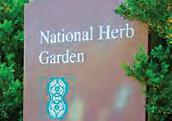
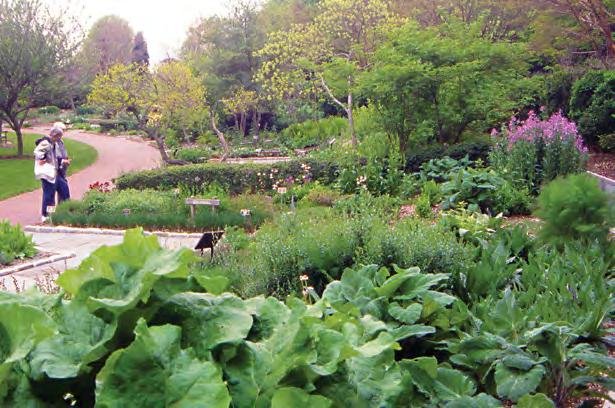
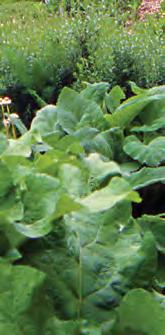
The National Arboretum website states that the National Herb Garden “is a captivating place to visit any time of the year.” This garden offers the resurgence of spring, the exuberance of summer, the colorful maturity of fall and the quiet dignity of winter. In these photographs we offer views of the nooks and crannies of the garden as well as garden activities across seasons, and across years. Stroll slowly through these images, whether this is your first visit or simply the most recent of many. Appreciate what this gift from The Herb Society of America is.
12 13 The Herbarist issue 81 2015
In FOCuS: THe nATionAl HerB gArDen
Value in theGenes Show me your garden, and I shall tell you what you are. — Alfred Austin Poet Laureate of the united Kingdom of Great Britain and Ireland 1896–1913
Wild-collected Glycyrrhiza glabra from Azerbaijan
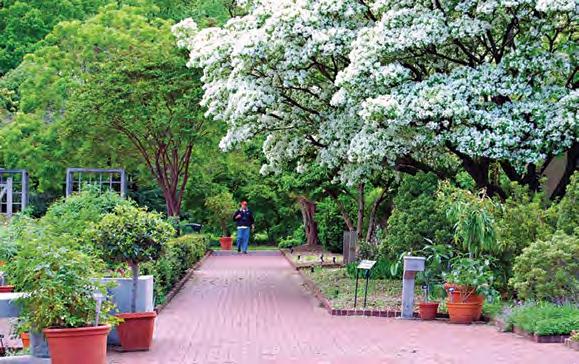

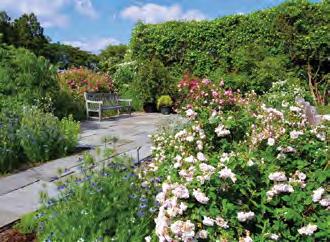

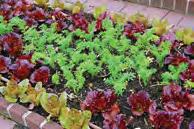
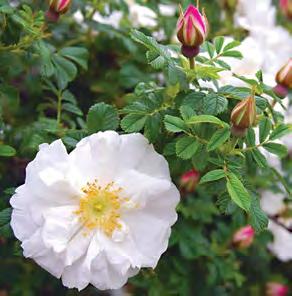
A BOv e L ef T Yellowwood (Cladrastus kentukea) in bloom in the entrance Garden (May 2010) A B Ove: White blooms of Rosa rugosa ‘Henry Hudson’ Be LOW L ef T Ornamental edibles display in the entrance Garden (Mar 2012) Be LOW C e NT e R early spring planting of tulips and strawberries in the entrance Garden (Mar 2012) B e LOW RIGHT: Wild-collected germander (Teucrium polium) from Azerbaijan (2009) BOTTOM L e f T: Rosmarinus officinalis ‘Logee Light Blue’ flowers (Mar 2012) BOTTOM RIGHT: Rosa ‘ v ck’s Caprice’ (Apr 2012)


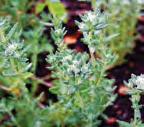

14 15 The Herbarist issue 81 2015 In FOCuS: T H e nAT i onAl Her B gAr D en
A B Ove: Brick walk to the Theme Gardens (7 May 2009) Lef T: NHG sign accented by tulip cultivars and Allium alfatunense cv. (22 Apr 2010) Be LOW Restful bench in the rose garden (30 May 2014)
Spring

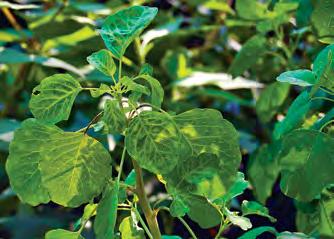
Lef T: ×Citrofortunella microcarpa (calamondin) in the entrance Garden (Apr 2012)
ABOve Papalo/yerba porosa (Porophyllum ruderale) in the Culinary Garden (July 2014) Be LOW: v ew of the Knot and entrance Gardens (July 2014)
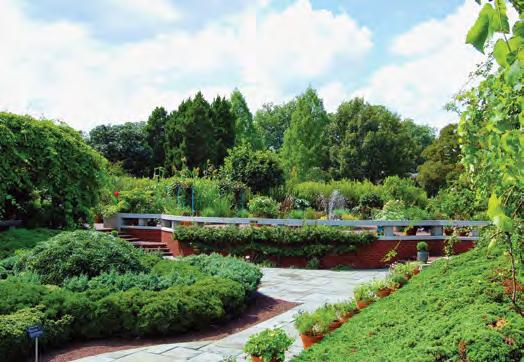
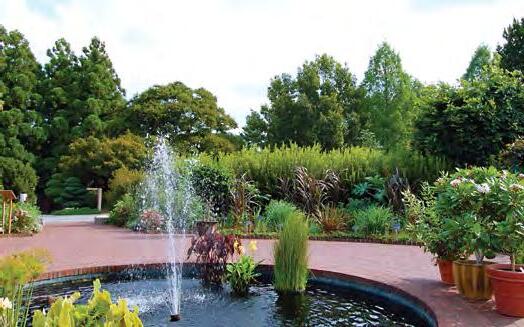
A B Ove: entrance Garden fountain and herbal grasses display (July 2014) RIGHT: entrance sign with the Herb of the Year, Artemisia, in foreground (May 2014)
BeLOW: Basil cultivars and purple sugar cane in the Culinary Garden (July 2014)

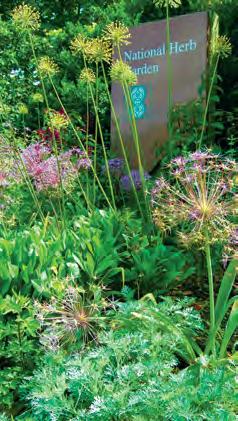
16 17 The Herbarist
In
T H e nAT i onAl Her B gAr D en
Issue 81 2015
FOCuS:
Summer

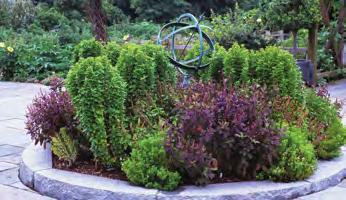

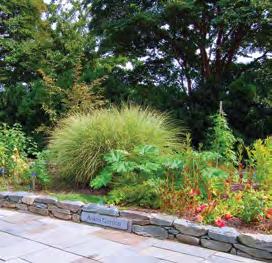
A B O v e: Stand of Salvia leucantha ‘Midnight’ (Mexican bush sage) in the entrance Garden (Nov 2014)
Lef T: Herb of the Year basil around the Armillary in the Rose Garden (Sept 2003) BeLOW Lef T: vetiver grass (Chrysopogon zizanioides) and lemongrass (Cymbopogon citratus) in the entrance Garden (Nov 2014)
A B Ov e: Asian Garden (Sept 2009) ABOve RI GHT: Pelargonium echinatum blossoms (Nov 2014) B e LOW L ef T: Asian Garden with Celosia argentea var. spicata flamingo feather’ in the foreground (Oct 2014)
B e LOW RIGHT: Purple amaranth (Amaranthus cruentus cvs.) and zinnias (Zinnia cvs.) in the Dye Garden (Sept 2009)
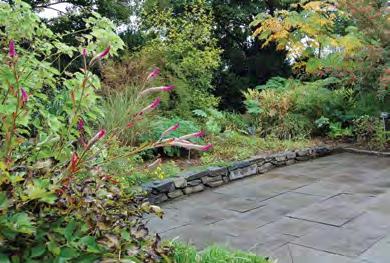


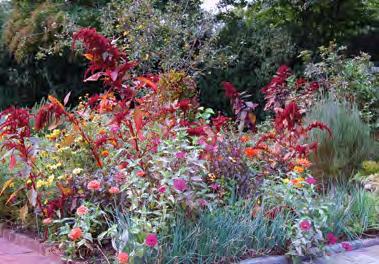
19 issue 81 2015
Fall
In FOCuS: T H e nAT i onAl Her B gAr D en
In FOCuS: T H e nAT i onAl Her B gAr D en Winter

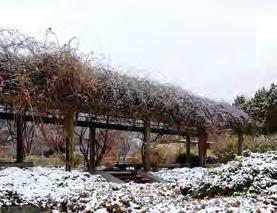
A B Ov e: A resident mockingbird overlooks the Knot Garden (Jan 2015) L e f T: West arbor, the site of many Under the Arbor educational programs conducted by HSA members (feb 1999) B e LOW: view from the Colonial Garden looking out over the neighboring Theme Gardens (Jan 2015)
BOTTOM: A winter walkabout provides views through the Atlas cedars to the NHG beyond (Jan 2015)

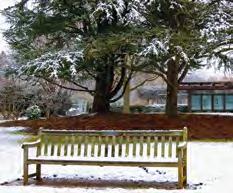
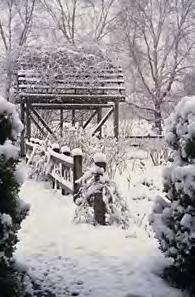
A B Ove: A view into the snow-covered Rose Garden (8 feb 1997) ABOve RI GHT: Lindera umbellata (kuro-moji) leaves provide winter beauty in the fragrance Garden (Jan 2015)
BOTTOM RIGHT: The Armillary stands sentinel in the wintry Rose Garden (Jan 2015) BOTTOM
L e f T: view of the rosemary (Rosmarinus cvs.) collection and the Capitol Columns through the dwarf river birches (Betula nigra ‘Little King’ fOX vALLe Y ) (Jan 2015)
The National Herb Garden with its specialty beds, changing entrance garden and extensive collections is a testament to “the glory of gardening.” We hope you have been nurtured by this fabulous garden.
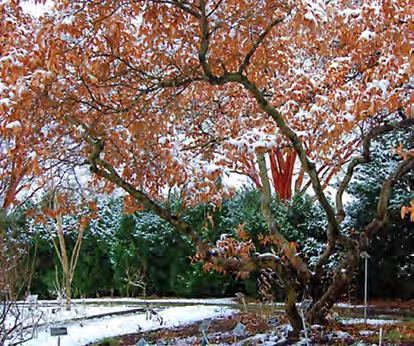
The glory of gardening: hands in the dirt, head in the sun, heart with nature. To nurture a garden is to feed not just on the body, but the soul.
— Alfred Austin Poet Laureate of the united Kingdom of Great Britain and Ireland 1896–1913
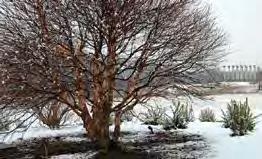

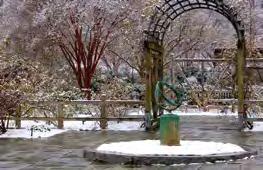
Pat Kenny, a member of the Potomac Unit, has been a member of The Herb Society of America since 1979. She has been very active on the National Herb Garden committee. Her career as a medical illustrator carried over to botanical illustration as well as nature photography. She received the Helen de Conway Little Medal of Honor, the highest award given by The Society, in 2015. An apt description of Pat stated: Her “adherence to plant nomenclature and accuracy in depicting in art are balanced by a gardener’s pragmatic instincts and a scholar’s tenacity in seeking out truth.”
20 21 The Herbarist issue 81 2015

i n T egri T y & o u T r e ACH:
Building A Strong Foundation For The National Herb Garden
Chrissy Moore
The National Herb Garden (NHG) resides on 2 ½ acres of prime real estate at the U S National Arboretum in Washington, DC Its high profile location puts it in the public eye and also invites professional scrutiny In such a situation, the pressure to maintain quality collections and educational opportunities guides many of our decisions . To assist staff in collections maintenance, the National Arboretum adopted a new Living Collection Policy in 2012 that delineates numerous parameters to which each garden or collection must conform to uphold its integrity and accuracy within the scientific plant community . (See Scott Aker’s corresponding article)
First Things First: Primary Source Challenge
The Arboretum’s Living Collection Policy strongly encourages— and in some cases, mandates— the acquisition of plant material from known primary (original) sources. For species, this means collecting them within their native range, and for cultivars, this means obtaining plants from whoever introduced or named it. This
can be a challenge in the NHG as many herbs currently in cultivation are so far removed from their native wild origin that tracking down an herb’s primary source is nearly impossible. Additionally, because so many herbs are easily propagated and passed along, finding the original source for any given cultivar can be difficult at
best. While identifying herbal progenitors is a key component of the primary source dilemma, an even more pressing concern is proper identification and deciphering correct nomenclature.
Throughout the herb world, accurate nomenclature is a problem made worse by the situations alluded to above. In order to
accurately source your plant material, you absolutely need to have a correct name; otherwise, we you have no idea whether we are talking about the same plant or what plant you are identifying. In the NHG, a plant without a correct name is of no use to us, and thus, is removed. Efforts are then made to reacquire the plant material with adequate documentation. In some cases, new cultivars or hybrids can be easily traced to their original sources if the breeder made a point of promoting it the introduction. Lavandula ×intermedia ‘Phenomenal’ introduced by Peace Tree Farm in 2012 is a recent example. Oftentimes, though, the information is not w idely disseminated or is published in limited print outlets. Perhaps a plant’s only mention was in a nursery’s catalog or on a website. Web searches can aid the process, but this means has only been a relatively recent addition to the botanist’s or taxonomist’s research toolbox. At times, our botanist in Plant Records has had to search documents from the 19th and 20th centuries just to find a plant’s first mention in the nursery trade. Frustratingly, this is not an unusual occurrence as legitimate documentation of nomenclature or provenance for an herb can be quite rare. Gene banks, such as those of the National Plant Germplasm System of the U.S. Department of Agriculture— which includes the U.S. National Arboretu m— collect, store, document, and distribute a broad spectrum of plant genetic resources, including some herbal material. This material, and associated information, is available through the Germplasm Resources Information Network (GRIN), making this database one of numerous good resources for nomenclature and provenance cross-checking, but it is by no means all-inclusive. Alternatively, there exist genera-specific registrars, which focus attention on key plants, also facilitating nomenclature checks. For popular landscape or garden genera such as Rosa or Acer, registrars exist to document the introduction of new cultivars or varieties, as well as wildcollected material. Unfortunately for herbs, there are no such registrars or other
official outlets documenting an herb introduction, which leaves the gardener, breeder, scientist, or curator at the whim of individual mental recall or even worse, the telephone game: “What was the name of that plant you gave me? I think I’m going to take cuttings of it to sell at next year’s plant sale. Did you say it was ‘Fabulous’ lavender? Okay, yeah, that’s close enough. No one will really notice. I’m sure it will be a hit because it really is a fabulous plant!”
Mm hmm… we know the rest of that story
This lack of a centralized database begs for the establishment of such an entity. And while HSA has the Plant Collections Committee, which collates information from various members’ holdings, it does not serve as a nomenclature clearinghouse. Given these challenges, the curator must do his or her best to locate original source material for those herbs where it is possible, and for the rest of the plants, a good faith effort is made using reliable sources for acquisitions. When new
the arboretum’s database system, as well as on the garden’s signs.
For the most part, due diligence is the best we can hope for. Unless the herbs are wild-collected or received directly from the introducer, primary-source material is often not obtainable. We have to put a lot of trust in the nurseries and seedsman we use to provide accurately identified material to us. Even with those measures in place, the NHG has, on occasion, received seed that was incorrectly labeled. The curator, therefore, must vigilantly root out such cases of mmistaken identity to maintain the integrity of the collection.
Cleaning House: Collection Integrity
The NHG’s main goal is to facilitate a richer understanding of herbal plants through aesthetically pleasing garden displays and signage. The language we use in the NHG to describe an herb is “any plant that enhances people’s lives through flavorings, fragrances, medicines, coloring agents, and additives in industrial pro-

material is brought in, the names are vetted through the arboretum’s Plant Records Office. Our botanists search the literature for documentation of names, as mentioned above, and if possible, the origination of the plant material. Due diligence is done wherever possible, but the appearance of new—and sometimes old—information may arise through continued literature searches or through subject matter experts. When corrections need to be made, changes are reflected in
ducts, with the exclusion of those plants used strictly for food.” The garden houses more than 800 taxa in ten theme gardens, a heritage rose garden, a knot garden, and other miscellaneous garden beds.
The curator of this garden is not merely a guardian or caretaker, but is also a researcher, interpreter, and manager of plant material, resources, time, and people. The first— plant materia l— is the foundation on which the other elements rest; without the plants, there is no garden. Since the
22 23 The Herbarist issue 81 2015
Interns are essential in conducting investigations and gathering data in the garden

plants in the garden have the aforementioned requirement of being useful to humans, this is the deciding factor by which any inclusion in the garden is measured. People often ask me how I come to decide what plants are grown in the garden, so I explain that I look for at least three reliable references for each plant’s use. If a plant seems to be questionable for any of a multitude of reasons, I will make the call as to whether it stays or goes.
A number of years ago, I asked the NHG Committee members if their respective units would be willing to engage in a project for the garden aimed at researching and updating each theme garden’s plant list. I felt strongly—and still do—that each theme garden should undergo periodic review to determine which plants should remain and which plants may need to be removed. Alternatively, there may be plants that have not been included previously that should be included based on new research. Things change over time, after all, thus abolishing the notion that what has been must always be. Even in an historic setting where management of an historic landscape is relatively static, change is sometimes inevitable.
The participating units were assigned one of the ten theme garden’s plant lists to research and review and then report back their findings to the NHG staff. We set up parameters by which plants were given priority status. Those plants that were deemed highly useful were given primary importance (first tier plants) and, thus, are always included in the garden unless there are overriding factors such as
availability of plant material or invasiveness. Plants of secondary importance (second tier plants) are also included in the garden but are not given as much weight or consideration as those in the first tier. Third tier plants have much weaker references for their use and may either be eliminated from the plant list altogether or may be included if there is space in the garden. Using this evaluation system frees the curator to make educated decisions regarding a plant’s status in the garden rather than feeling obligated to maintain a plant just because it’s always been there. An example where such a review was helpful appeared while reviewing the various trees planted throughout the garden. A Malus halliana ‘crabapple’ was growing in the garden for years even t hough it had no defensible herbal use. In 2014, this tree was removed from t he collection, making room for a new, truly herbal tree. In other cases, certain plants, such as Artemisia vulgaris ‘mugwort’, have become invasive in the g arden. Though the plant might be highly useful, its presence has become an environmental nuisance, which overrides any argument for its inclusion. In another scenario, some plants are just too challenging to keep alive because they cannot grow well in our climate or soils and, therefore, do not justify the expenditure of resources necessary to maintain them. Sometimes a suitable substitute is worth the effort. One such example is Taxus brevifolia ‘ Pacific yew’ , the original source of taxol, a chemotherapy drug. Pacific yew does not grow well in the Mid-Atlantic climate, but other species of Taxus do. These species contain variable quantities of the active chemical as well, so making the switch to a species more amenable to the NHG’s environmental conditions—with an explanation for the substitute in the signage—is a reasonable accommodation.
Curation isn’t all about purging, although sometimes it appears that way. Acquisition
of new plant material is also a major activity. After researching the various themes in the garden with the HSA units, we found that there are numerous plants that should be included in the garden, but for whatever reason, have not been or were lost over time. One example is Citrus bergamia ‘ bergamot’, whose fragrance and flavor gives Earl Gray tea its characteristic appeal. This plant was not included in the Fragrance Garden’s or Beverage Garden’s plant lists, so it was added to those gardens as a notable example of a plant used for both fragrance and flavor.
As gardeners know, things are always in flux, so periodic review of the plant material should always be on the curator’s priority list. Plants are not the only element in the garden that needs attention, though. The plants we grow in the garden also need to provide useful educational opportunities as well.
Get the Word Out:
Educating the Masses
One of The Herb Society’s key values— and by extension, the National Herb Garden’s—is providing opportunities for education about herbs (http://www. herbsociety.org/about/vision-missionstatements.html). While the NHG is part of the U.S. National Arboretum, which has its own educational mandates, the NHG also takes many of its cues from The Society. To that end, the garden is not merely a collection of pretty, or even tasty, plants but is a deliberate and thoughtful outreach vehicle for disseminating information about the usefulness of plants.
A few of the plants’ uses are known almost worldwide, but most are not. In an effort to provide information education to the public about a plant’s use, the NHG employs various modes of communication information. The first and most commonly encountered is signage. Basic signs include the scientific and common names, family name, and native range.
In the theme gardens more complex information labels add the habit of the plant (perennial, annual, etc.), a description of how the plant is used, and on newer versions, the plant’s accession number. The
inclusion of accession numbers on the sign allows visitors to access information using their mobile device about a particular plant via the Arboretum Botanical Explorer on the arboretum’s website.
The basic name labels are more straightforward to produce since they follow a standardized format. The information labels, on the other hand, require significantly more work. As mentioned earlier, each
to produce text no more than 150 words in length and be at an eigth grade reading level. This may seem like an easy task, but I can assure you, it is not! All labels are, again, vetted through the Plant Records Office to assure that the nomenclature is correct and to verify the text information. When all is deemed correct, the text is engraved on permanent labels and mounted on stakes for display in the garden.
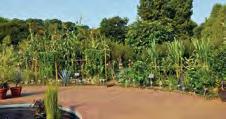

1. An accession number is a unique number assigned to individual plants to differentiate them from others. The metadata with each number may include, but is not limited to, correct taxonomic name, location of plant in the garden or collection, when the plant was received, and source.
plant’s use must be documented in at least three reliable references, which may require considerable research. Once the use is verified, the label’s author (the curator, assistant, or intern) must distill that information down to include the use(s) of greatest importance and that are ( hopefully) the most relevant and/or interesting to the general visitor. The information must then be whittled further still
Labels are one means of getting the message out, but the NHG also utilizes displays and programs to further expand the educational outreach. Displays may include seasonal plantings of a particular theme coupled with appropriate signage. A recent example was intern Seth DeNoble’s breakfast, lunch, and dinner beverages plant display in the Entrance Garden. Displays may also take the form of interpretive panels in the display case area of the garden that cover various topics of interest, such as chile peppers. Both of these displays require multiple levels of research, development, verification, and interpretation to meet our criteria for accuracy and relevance. An equally important avenue for information dissemination is through public pro grams, including tours of the garden led by docents or NHG staff, and the ever-popular Under the Arbor series. The Under the Arbor series is the main opportunity units—generally those within driving distance of the NHG—have to participate
i n educational outreach in the garden. The Society members have extensive herbal knowledge and expertise to share with the public, and I feel strongly that it is one of curator’s foremost jobs is to link such entities to our visitors whenever and however possible. Just as there are multiple learning styles for individuals, so too, are there multiple styles of educational outreach that can be utilized in the garden to expound on the usefulness of plants.
Over the past 35 years, each curator has contributed his or her own expertise to the development of the garden. Regardless of stylistic differences, two elements are constant for any NHG curator— collection integrity and educational outreach. In both of these areas, challenges present themselves regularly. But a capable curator takes them in stride utilizing his or her resources to work through the issues and ultimately present a garden of herbal excellence to the world.
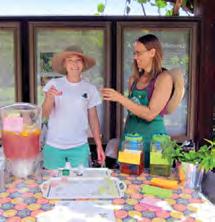

Chrissy Moore is the curator of the National Herb Garden. She is a member of The Herb Society of America, Potomac Unit. She is also a certified arborist with the International Society of Arboriculture. She attended St. Mary’s College of Maryland. Having completed two horticulture internships at the U.S. National Arboretum, she was hired by the education and v sitor Services Unit at the USNA in 1996. She served as the National Herb Gardener’s gardener from 1998 until 2007, when she accepted her position as curator.
24 25 The Herbarist issue 81 2015
i n T egri T y An D o u T re ACH: BuildingAStrongFoundation

Garden Design and Maintenance
A Conversation with Past Curators of the National Herb Garden
The Herb Society of America has been very fortunate in not only having extremely knowledgeable and personable curators for the National Herb Garden but also curators who had long tenures in the garden! We asked Holly Shimizu (1979–1988), Janet Walker (1988 –1997) and Jim Adams (1997–2008) to reminisce for us about their garden experiences.
Holly: Being selected as the first curator of the National Herb Garden was such an amazing opportunity and learning was a constant. During the planning stages, while the Garden was still under construction, we met often with Tom Wirth, the landscape architect employed by Sasaki Associates of Boston, Massachusetts. We had some major surprises — the soil was terrible, heavy clay and did not drain at all — not an ideal setting for herbs. We were able to arrange for some compost from the National Zoo, which was referred to as “zoo-doo.” Occasionally exotic and bizarre weeds would appear, which we attributed to some of the exotic animals at the National Zoo. We worked with many of the HSA units that had been tasked with designing the specialty gardens and then I set to work locating many of the plants listed — it proved to be rather tough. When the plants came in they were often tiny little rooted cuttings or seedlings. For some of the larger plants, such as the boxwood and herbal trees, we traveled to nurseries to handpick our selections. Of course we were committed to t rying to get the labels done correctly although the headaches of trying to figure out what the plants really were proved to be a never-ending challenge. We struggled to get the Knot Garden details exactly right and then setting

the Armillary Sphere proved to be more complicated than expected in order to get it set true north. The garden opened on schedule but the plantings were admittedly underwhelming—thank goodness, as gardeners, we all knew the plants would grow, fill in, and the Garden would be wonderful in a few years.
Janet: Ah, the Knot Garden! The biggest challenge I had to deal with was the chronic ill-health of the original Knot Garden, which just didn’t seem to be loving life and hence required more than its fair share of TLC and plant replacements. The plants exhibited

classic failure-to-thrive symptoms, as if they were standing with their feet in water, which I was assured just could not be the case. Eventually my boss gave the go-ahead to “check anyway.” We got my volunteering husband to dig a deep post-hole in each of the four corners of the garden, which promptly filled with water to within a foot or so of the surface grade and stayed that way, week upon week, even during one of our more severe summer droughts.
Problem diagnosed!
The remediation involved the complete


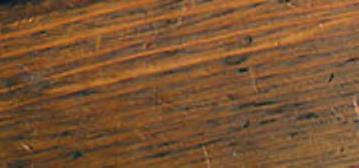
excavation, reconstruction and replanting of the Knot Garden. I learned t hat the original subsurface drainage tiles had been installed upside-down. They trapped irrigation water rather than draining it. Obviously the new tiles were reversed. Problem solved! Jim: Ah, irrigation in the garden! In November 1998, after more than a year of preparation, the Herb Garden was closed to visitors for its first major renovation since it was built. The renovation included a complete redesign of the irrigation system, removing the metal edging throughout the garden and replacing it with different edging solutions such as brick or block, adding night lighting to the garden, and most importantly, making the garden accessible by federal accessibility standards. This included removing the stone paths in the rose garden and in the theme gardens and replacing them with bluestone. It also meant grading the path along the rose garden to the knot garden so that it would have a more gradual slope. To prepare for the renovation, all of the plants within about two feet of the all the garden edges had to be removed. After making sure all of the plant records were up to date for those plants, when the garden closed, they were moved to a temporary holding nursery by the old M Street Entrance Gate. Because the holding nursery was in kind of an out of the way location at the Arboretum, we wanted to make sure the plants were protected. We installed a chain link fence around it with a locked gate. The nursery then was dubbed “the plant jail!”
The Herb Garden re-opened in the spring of 1999 with a big celebration called A Garden for All, calling attention to the fact that it was the first f ully accessible garden at the Arboretum. The event was co-sponsored by the Arboretum, The Herb Society of America, and the Friends of the National Arboretum. The event drew quite a crowd and was attended by
27 issue 81 2015
H olly Shimizu J anet Walker J im Adams
H E RBARIST
The Knot Garden at NHG
dignitaries from the U.S. Department of Agriculture, Ward 5 of Washington, DC, and The Herb Society of America.
Favorite Garden Sections
Holly: It’s hard for me to pick a favorite as we were installing all of them! I think the roses. For the Antique Rose Garden we worked with Charlie Bell, a heritage rose person who was a part of the Potomac Rose Society. The garden was all planted in excellent soil, the plants located from a variety of private and public gardens as well as nurseries. I worked with Dr. Frederick Meyer, the botanist for the U.S. National Arboretum, to be certain that our roses were all correctly labeled in preparation for a large rose convention that included a visit to the garden. Well, I remember that day well. One of their authoritative members came into the garden and, with her cane in the air, she declared “all of these roses are labeled incorrectly.” The group spent days (perhaps months or years) arguing about the origins and identities of the roses in the Garden. I suggested that once they were clear and confident about the answers to these questions they should let me know so I could take it back to Dr. Meyer for review.
Janet: I also especially loved the Rose Garden. During the long peak of its season, I think it was among the loveliest places on earth, particularly once we had established the companion plants: opium poppy, cardoon, larkspur, feverfew, columbine, and foxglove, to name a few. Early and late in the day, and even in the hazy heat while the sun was still high, you could stand there between the rail fences and imagine yourself in some ethereal countryside of fragrant cozy lanes, yet all encompassed within the space of a typical urban backyard.
Jim: I have two different parts of the garden that were my favorites. I love the theme garden area. I really like the diversity of plant material in the gardens. There are so many beautiful and interesting plants with fascinating histories and stories.
I also really loved the sage collection. It was always so colorful, texturally rich, and alive with insects. I used to enjoy being at work late in September and October, when
the sun was lower in the sky and the rays of sunlight would cut straight through the border, backlighting all of the flowers. It is a magical sight. One of my most favorite sights in the garden.
Special Visitors to the Garden
Janet: A few months into my job as National Herb Garden curator this would have been in early fall of 1988 I had my first uneasy encounter in the garden. I worked from 7:00am to 3:30pm each weekday, and I was alone in the garden at about 7:10am making my early-morning rounds. I always enjoyed this time because I had the garden all to myself. But on this one day there was a 60-ish man out in the Specialty Gardens whom I didn’t recognize. I was a bit alarmed since we didn’t open until 8:00am. I had my radio (and pruning shears if I needed them) so I could call for help and I think I said, “Can I help you?”

Without preamble or apology, the strange man launched immediately into an extended and focused discourse on herbs and their uses which was absolutely fascinating. It was quite a bit over my head as a horticulturist who was still largely ignorant of herbs, but I could feel the curtain lifting then and there on a hidden and marvelous stage. He illustrated his presentation by baring the insides of his forearms, both of which were impressively reddened and blistered with a poison ivy rash, but one conspicuously less so than the other. He eagerly shared proof that jewelweed did indeed have an ameliorative effect on self-inflicted ivy poisoning. A rather startling visual aid, but pungent and hard to argue with!
This was my introduction to the “mad scientist” of herbs—the legendary ethno-
botanist Dr. James A. "Jim" Duke, who had purposely arrived early that day for a meeting in the Administration Building so he could spend some quality time beforehand in one of his favorite places. I quickly “got it” that this was an extraordinary person, and he became one of my mentors, always willing to impart his vast knowledge which seemed to pour out of him like a fountain.
Jim: There were many famous people who came to the Herb Garden for the Friends of the National Arboretum Cookout every June. Some that come to mind are Paul McIllhenny, Sandra Day O’Conner, and Christine Todd Whitman, Governor of New Jersey. Not famous, but worked for famous, was a crew from Martha Stewart Living magazine who came to photograph all of the different mints in the garden for a story about the genus. They came in June 1999 and it was the same day we started a renovation of the Colonial theme garden. We worked very hard that very hot day digging and dividing plants in the garden. At the end of the day, the gals from “MSL” said they were astounded at how hard the volunteers worked on such a hot day and how much they got done.
Holly: I remember that whenever we were going to have special visitors, Betty Rea would let me know. We would make tussie-mussies and picnics for our guests — this became our habit and proved to be an excellent way to introduce the Garden to potential donors and friends.
Rewarding Days in the Garden
Janet: What can I say about the most rewarding day in the Garden? There were so many! The day of the annual Friends of the National Arboretum al fresco fundraising event was a recurring high point in early June. We always got a spectacular turnout of staff and volunteer help beforehand to groom the Garden to perfection. For one day, and one day only, there wasn’t a hair out of place.
Holly: That sounds so familiar! After three years the Garden really began to look quite beautiful, plants had settled in to their spaces and as long as we had enough rain, the garden was quite enchanting as

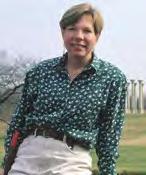
well as highly educational. Having classes, tours, and herbal programs that were always well attended and popular helped us get out the word about this amazing new Herb Garden.
Jim: What I found most rewarding was working with the volunteers, the HSA units, and the National Herb Garden committee. Working with all of those folks was the hardest thing to leave. Working with such a dedicated group of people who freely gave their time and talents was the
most rewarding part of the job.
“What have you never been asked?”
Jim: What’s my favorite time of year in the garden? It’s autumn! Autumn is the most awesome time in National Herb Garden. All the plants are so big and have so much to offer. The colors are richer that time of year too. It was no coincidence that my most favorite program in the garden was the Bewitching Tour held at
Halloween time. It was so much fun to put on and the people on the tour seemed to really enjoy it.
Janet: I changed the garden, but how did the garden change me? My eight years as curator were a personal journey and evolution, something I would not have predicted. Herbs took a hold on me and the more I learned about them, the more I wanted to learn. I could grow them, sure, but knowing about their history, uses, powers and lore made them magical. The connection felt with everyone throughout time who has used a plant for a reason is thrilling, and very real. This must be what binds us all together.
Holly: I think the question would be “has the garden grown in the way you expected? Absolutely! The garden was a leader then and continues to be an inspiration in the ever-expanding interest in herbs across America. The National Herb Garden has played a big role encouraging further herbal study and use in both public and private gardens.



Holly Shimizu, after studying horticulture at Pennsylvania State University, worked in a number of gardens in europe before being selected as the first curator of the National Herb Garden from 1980–1988. She went on the work at the U.S. Botanic Garden in Washington, D.C. and the Lewis Ginter Botanical Garden in Richmond, virginia. Most recently, she was the e xecutive Director of the U.S. Botanic Garden. She is a lecturer, writer, and the recipient of many awards, including the Nancy Putnam Howard from The Herb Society of America. Currently, she serves on the advisory board of the Las Cruces Biological Station in Costa Rica, the board of directors of the American Horticultural Society and the board of the friends of the National Arboretum.
Janet Walker had the good fortune to grow up surrounded by gardeners in Washington, and knew a good thing when she saw it. After working for years as a landscape contractor, she took over as curator of the National Herb Garden from 1988–1996 and, thereafter, as the Head of education and visitor Services at the U.S. National Arboretum. She later worked as Director of Horticulture for the American Horticultural Society’s River farm, followed by a second stint as a director of education and visitor services, this time for Bok Tower Gardens in Lake Wales, f orida. She currently is visitor Services Manager for the Smithsonian American Art Museum and National Portrait Gallery. When she’s not at work, she can usually be found outdoors.
Jim Adams began his career with internships at Michigan State Horticulture Gardens, Chicago Botanic Garden, Longwood Gardens and the Scott Arboretum of Swarthmore College. He has worked at the U.S. National Arboretum where he was assistant to the curator of fern valley Native Plant Collections and then curator of the National Herb Garden for nine years. He was Head Horticulturist for the British Ambassador to the U.S. before obtaining his current position with the U.S. National Park Service as Supervisory Horticulturist.
28 29 The Herbarist issue 81 2015
Carolyn Cadwalader and Holly Shimzu in the NHG circa 1979
A Conversation with Past Curators of the NHG
Left: Janet Walker in 1990 Above: (L) Intern Amy forsberg and Jim Adams
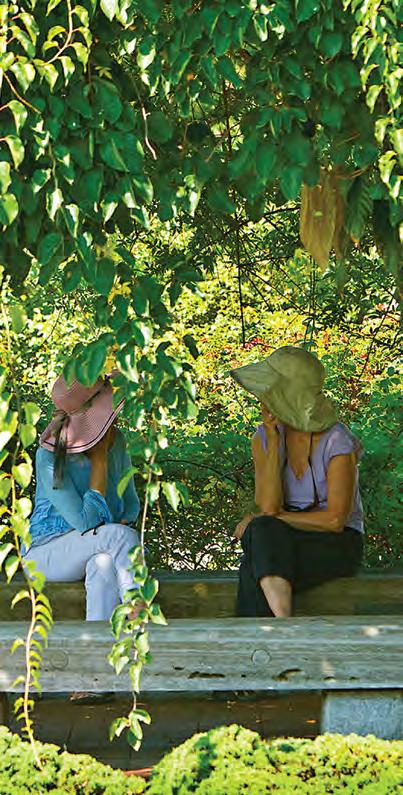
Under theArbor An Educational Series at the National Herb Garden
At an HSA board meeting in 1966, President Edna Cashmore announced her idea for a national garden of herbs that all Americans could see, admire and learn from.
— The Herb Companion, October/November 1993, p. 44
The Herb Society of America in fact did give our nation an herb garden fourteen years later. Local, national, and international visitors to the National Herb Garden (NHG) have been able to do those very things; “see, admire and learn”. The garden has been the site of many educational programs or events over the years. In more recent years the annual Under the Arbor (UTA) series has enthusiastically continued to educate. Janet Walker, second curator of the National Herb Garden, started an educational program called Discovery Carts. There were different cart themes based on six of the theme gardens: dye, medicinal, fragrance, culinary, beverage, and Native American. Trained volunteer docents from the National Arboretum worked on Saturday and Sunday afternoons, talking with the public about the topic of the day. Each topic had a discovery kit that included items or props displayed on the cart. These props became the talking points for the docents to engage visitors. Some of the kits included hands-on
activities that visitors could participate in (e.g., identifying different mints by scent), while other kits required the docents to demonstrate something, such as the dye kit where the docents actually dyed yarn or fabric with plant material.
The Discovery Carts program took place from May through October. Over time, it became increasingly difficult to staff the carts with arboretum volunteers, especially for both weekend days for many months. Eventually the program ceased altogether. Some years later the National Herb Garden committee members discussed the re-introduction of educational programming in the garden. It was clear that asking arboretum volunteers to staff such a program for so many days was not feasible in the long run, but we didn’t want to completely abandon the concept of an educational program in the garden. Chrissy Moore, current NHG curator, had an additional concern that many of the units were not as involved in the garden as hoped. She wanted all units to feel part of the garden, but knew that the more distant units could not be actively involved. The geographically closer units would be more accessible to the garden and possibly have members more willing to come for a Saturday afternoon presentation. The NHG Committee brain-stormed the idea and came up with a spin-off of the Discovery Carts program, the Under the Arbor series. The title derives from the flourishing arbor that is a focal in the National Herb Garden. There are three differences between the Discovery Carts program and the Under the Arbor program. First, in the Under the Arbor program, we limit the events to just Saturdays during peak visitation months (May, June, September and October) and do not schedule every weekend. Second, instead of using arboretum volunteers, we use HSA unit members and members
at large as educational ambassadors. This is a great way for the members to stay connected and involved in the NHG, as well as to share with the garden’s visitors some aspect of their herbal expertise. Third, the presenters are not limited to just the overall topics of dye, medicinal, fragrance, etc. They can choose any herbal topic to discuss. We’ve had everything from the ‘Herb of Year’ to herbal butters and cheeses, herbal teas to colonial herbs. The choices are somewhat unlimited; it all depends on the creativity of the HSA volunteer presenters. Each year the ‘Herb of the Year’ is highlighted at some point. In 2011, the NHG committee and garden curator Chrissy Moore decided to expand at least one of the Under the Arbor events. Because the garden has such a magnificent chile pepper collection, the committee chose to schedule a Chile Pepper Celebration in October, when the peppers are at their best. This was an opportunity to show off the beautiful chile peppers and the fall herb garden at the same time. This year we will be enjoying our fifth year of this celebration, where the public can enjoy the various displays and food samplings. The demonstration tables abound with chile pepper tablecloths and chile pepper decorations. We have given away packets of chile pepper seeds and sampled different types of chiles.
Attendees have tasted chile pepper hot chocolate, hot chili, chile pepper soups, chile peppers in appetizers and desserts, and of course, chile pepper ice cream and sorbets! Each year, as the word gets out, we have had more and more people attend. Even rainy weather has not forced us to cancel we just move to the classroom trailers!
The original National Herb Day, developed by the International Herb Association, is scheduled in the fall. While the NHG staff and volunteers wanted to do something to honor the day, many of the presenters could not make themselves available at that time of year. The NHG Committee chose to celebrate Herb Day in June, the month of the NHG’s actual birthday. Members of a number of units from the Mid-Atlantic area come for a spring work day in the garden on Friday and stay through to Saturday to do the UTA. At the first few Herb Day events each unit did its own display. More recently all the displays have focused on the same herbs, roses and lavenders. In 2015 we celebrated the actual birthdate of the NHG, June 12, with herbal cakes. All of the Herb Day celebrations have been very popular, with about two hundred people usually coming by to peruse the demonstration tables.
Elizabeth Kennel, a long-standing
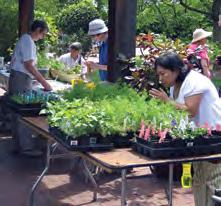
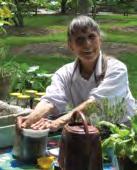
31
Issue 81 2015
1. References to the ‘Herb of the Year’ and ‘National Herb Day’ are often included in articles in The Herbarist Both are public awareness campaigns initiated by the International Herb Association (International Herb Marketers and Growers Association). for more information visit: www.iherb.org
H E RBARIST
Billi Parus and Chrissy Moore
Pat Kenny P H OTO Lois Sutton
fresh herbs to touch and smell, thanks to Potomac Unit volunteers P H OTO Lois Sutton

Some of the themes participating units have presented during Under the Arbor programs
Potomac Unit The Potomac Unit has presented a wide variety of topics over the years, ranging from growing herbs in pots to edible flowers, lavender, crafts, and ‘Herb of the Year’. This year their topic is soap making.
South Jersey Unit Though this unit has done colonial herb presentations, their topic usually relates to lemon herbs. Their display always includes a vase of assorted fresh lemon herb samples, lemon herb infused liqueurs and waters, cookies, and candied lemon peel. Their handout includes the recipes. Usually four to six unit members attend and make a weekend trip of it, stopping to shop, tour, and check out great restaurants along the way. They love talking to people about the lemon herbs!
Tidewater Unit Billi Parus often represents the Tidewater Unit and her topic is always herbal culinary uses. each year the Tidewater Unit asks the curator for suggestions of a particular culinary topic she would like presented based on questions received from visitors. The resulting topics/ presentations have included herbal liqueurs, herbal beverages, herbal butters and cheeses, chile peppers, herbal cakes and cookies, and herbal shrubs. Billi shares her expertise and loves seeing and hearing the reaction of people’s first taste
of herb enhanced food. People are amazed at the flavor the herbs instill! The highlight each year are the chile pepper ice creams and sorbets that Billi makes for the Chile Pepper Celebration at the October Under the Arbor.
Philadelphia Unit Many different members of the Philadelphia Unit have participated since the start of UTA. Their topics ad displays often feature fragrance. Some of their presentations have included lavender, roses, tussie mussies, potpourri, scented pelargoniums and elderberry. When they talk about herbal teas, they have empty tea bags ready allowing visitors to make their own herbal blends to take home.
Connecticut Unit Members of the Connecticut Unit participate each year, driving down to spend time in the garden and visit family. They always have an exciting display for the Herb Day event and they have enthusiastically recruited family members to help at the Chile Pepper Celebration in the fall. Their chile pepper tasting table is one of the most popular during the Celebration and entertaining when visitors MUST taste the hottest pepper!
Mason Dixon Unit This unit keeps visitors up to date with educational information about each ‘Herb of the Year’.


member of the National Herb Garden committee, best described why we do the Under the Arbor programs: “It has always been the aim of the National Herb Garden to educate the public about herbs. There is a long tradition of HSA members providing those educational opportunities. It gives those of us doing the UTA a chance to interact with the public and get them interested in herbs.”
Under the Arbor has been going on for several years now and has been an extremely successful program, both for the National Arboretum and The Herb Society of America. Members who participate interact enthusiastically with the public, providing visitors with a personal herbal experience.

Billi Parus is a member of The Herb Society of America, the Herb Society of Great Britain, a Master food Preserver/ volunteer, and a Master Gardener. She has served on HSA’s National Herb Garden committee for many years. In 2009, Billi received a HSA certificate of achievement, partially in recognition for her activities in restoring the lavender collection at the National Herb Garden in Washington, D.C. She lectures and teaches all over the country, on a wide variety of herbal topics, preferring the culinary lectures. She is the owner of Lavender House & Community Kitchen, producing herbal cakes, jellies, blends, vinegars, chutneys and non-culinary herbal gift items. Additionally, she recently was named an adjunct professor for culinary arts at Stratford University in falls Church, virginia.
Chrissy Moore is the curator of the National Herb Garden. She is a member of The Herb Society of America, Potomac Unit. She is also a certified arborist with the International Society of Arboriculture. She attended St. Mary’s College of Maryland. Having completed two horticulture internships at the U.S. National Arboretum, she was hired by the education and visitor Services Unit at the USNA in 1996. She served as the National Herb Gardener’s gardener from 1998 until 2007, when she accepted her current position as curator.
Plant Collections

have national collections. In the United States we have the North American Plant Collection Consortium (NAPCC), through the American Public Gardens Association (APGA), in cooperation with the USDA–Agriculture Research Service (USDA–ARS) and the United States National Arboretum (USNA).
32 The Herbarist
of T H e H er B So C i e T y of Ameri CA 2 015
Abbott
Anne
Plant collections are held in several ways across the world. Some countries have official collections; France, England, Australia and Germany, for example, all
Salvia guaranitica 'Black and Blue' in front of the entrance to the National Herb Garden. Photo: Anne Abbott
Herb collections and a discovery cart await NHG visitors
33 Issue 81 2015
collection
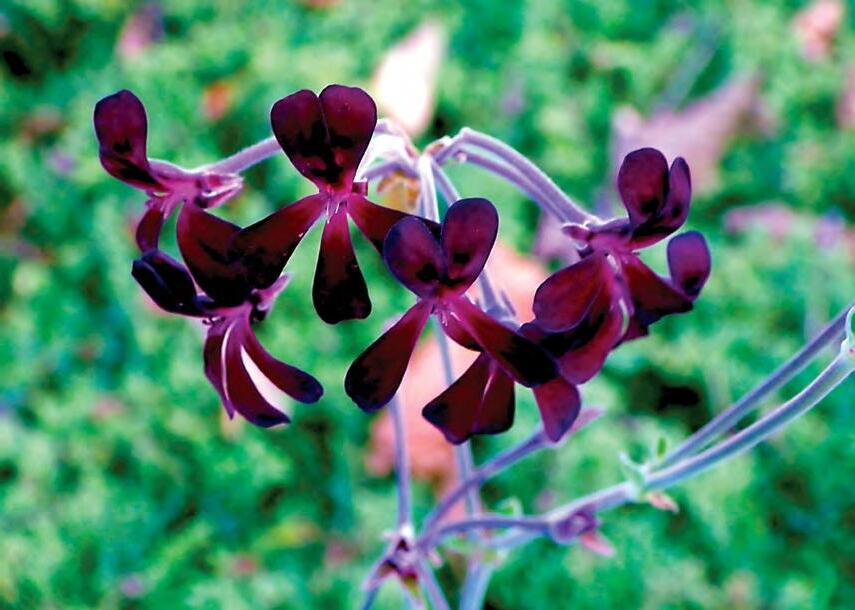
unavailable herbs through The Herb Society of America Seed Exchange and ommercial sources
Conservation–by encouraging the cultivation, reintroduction, and preservation f uncommon herbs for posterity and by serving as a repository for authentically labeled taxa.”
Collections in the project are in public and private gardens, and are not inspected by HSA for identification or nomenclature verification. Suggested websites or checking nomenclature include the USDA database and Germplasm Resources Information Network (ARS GRIN).
Although the HSA is not an officially ecognized authority on nomenclature, its membership includes experts in the field, e.g. Arthur Tucker, Ph.D., Professor Emeritus of Botany at Delaware State niversity, and Rex Talbert, a well-known expert in the area of herb nomenclature. Art and Rex have reviewed most of the nomenclature in the HSA collections.
Having the same plants growing in different climates is one way to understand t he limits of where plants will grow. Many serious gardeners like to document their plants by keeping a garden journal or monthly log on how they grow, when they bloom, and when they should be divided or pruned. Others just like to surround themselves with pleasing plants. Within HSA we have many collectors, not all of whom are listed with the Plant Collections Project. Most members enjoy sharing their information and their plants with other members.
: a group of interesting or beautiful objects brought together in order to show, compare or exhibit; or as a hobby.
a re very rigorous and involve site visits, authoritative plant identification, and nomenclature verification. Strict rules pertain to record keeping and monitoring collections. The NAPCC requires a “long term commitment to plant collections preservation and high curatorial standards.”
The NAPCC collections include maples, boxwood, camellia, citrus, cycads, magnolia, orchids, oaks, and rhododendron, a mong other plants. The USNA has a regis-
ington, D.C., in November 2014. Visiting t he vast greenhouses of the Smithsonian and the U.S. Botanic Garden was a real t reat. The Smithsonian greenhouses span 14,000 square feet. The U.S. Botanic Garden greenhouses not only hold their extensive orchid collection but also their collection of medicinal plants.
The Smithsonian orchid collection (8,000 orchids representing 2,400 species) is the benchmark ideal for how a collec-
its plant collections. The labels are detailed, with a bar code for easy scanning for inventory purposes. The rare plants are especially marked with orange reflector tags for quick removal from the greenhouse in case of a disaster.
The Herb Society of America’s Plant Collections Project is a program for HSA members, who may be amateur or professional gardeners, botanists, enviromentalists, or just happy plant people. In
and therefore encourages the cultivation and preservation of the living germplasm of herbs. The HSA’s collections of herbs serve a role in the following important areas: Education–through exposing our members and the general public to a wide variety of herbs
Research–by making the collections available for study Exchange–by sharing a limited number of cuttings, seeds, or plants of otherwise
Unfortunately, having the nomenclature correct does not guarantee the plant s what the label says. New cultivars, new hybrids, and “new” plants from nurseries are added all the time. Many plants come islabeled from growers and nurseries, sometimes from carelessness in the greenhouse, sometimes deliberately giving the plant a “new” name.
Among the HSA’s collections the NationHerb Garden (NHG) is our standard source for correctly identified plants. Observing the plants and learning their stories is fascinating for plant lovers. If you are lucky enough to own The National Herb Garden Guidebook, you have the stories right at hand. Each of the ten themed gardens is a collection, with the plants listed for each garden. Many of the plants appear in multiple gardens. A source of stories about plants in the culinary garden is The Herb Society of America’s Essential Guide to Growing and Cooking with Herbs. HSA is very proud of the National Herb Garden and the role we played in bringing it about and in continuing to be part of this “jewel.”
Another important purpose of collections is to preserve germplasm. The loss of t he Salvia collection of the New Orleans Unit in the New Orleans Botanical Garden is a tragic example of a preservation project faced with a natural disaster. In 2005 the Botanical Garden was inundated with salt water resulting from the levee breach during Hurricane Katrina. The collection had been carefully held in three separate locations, as suggested by HSA. All three were destroyed with no hope of retrieving any of the original taxa. However, the beneficial result was that holders of other collections within HSA came forward and donated plants from their collections (Pioneer, NHG, North Carolina, Potomac). An excellent collection resulted but with totally different taxa.
Another tragic example of the loss of a carefully preserved and monitored collection is the Rosmarinus collection of the North Carolina Unit. In early 2015 bacteria in the soil (Phythopthera) spread and caused the whole collection to be lost. The plants had been carefully assembled from other collectors, for example, the Pioneer Unit, NHG, Scott Kresge, and Art Tucker. Some unit members have cuttings/plants they obtained before the bacteria attacked. As Rosalind Pope, who was chairman of the rosemary collection for five years said, “The unit benefitted from the establishment of this collection not only in knowledge, but in the camaraderie between members. Its demise should in no way be a reason for not pursuing the es-
34 35 The Herbarist issue 81 2015
Plant Colle C T ion S
Pelargonium sidoides at the NHG Photo: Anne Abbott
noun | col·lec·tion | \k -'lek-sh n\
tablishment of further collections in the future; indeed, this emphasizes the importance of retaining collections where plants are positively identified so that when such disasters occur, there remain duplicate plants available elsewhere.” The excellent records that Ros kept will always be important.
The following are some popular genera included in multiple HSA plant collections:
Pelargonium: Collections are listed in the NHG and in gardens in Virginia, Pennsylvania, Ohio, and Texas. In all of these locations, plants must be moved inside or into a greenhouse for protection f rom cold. Several species that are found in all collections are P. crispum, P. graveolens, a nd P. capitatum Hybrids and cultivars that abound in the other collections i nclude P. ‘Attar of Roses,’ P. ‘Joy Lucille,’ and P. ‘Nutmeg.’
Two plants highlighted in the collection held by Caroline Amidon and Joyce Brobst (in Pennsylvania) are P. sidoides and P. citronellum. P. sidoides a native of Southern Africa, has small, dark, black/ burgundy flowers that rise above the plant on long peduncles. The two collectors say that the “leaves are slightly aromatic. The flower is night fragrant. A decoction of the root was used by various ethnic groups for intestinal problems. This is an easy plant to grow, and it rewards the gardener with almost constant blooms.” There is confusion about the name of this plant. Some suggest that the plant sold in this country is a cultivar and should be

called Pelargonium ‘Burgundy.’ P. sidoides is also held in the NHG collection.
P. citronellum is perhaps better known and is a very interesting plant. Plants may be found in the trade as ‘Mabel Grey.’
From Amidon/Brobst, “the name citronellum refers to citronellol, a substance t hat contributes to the lemon scent of the leaf. It will grow into a large woody plant, up to eight feet tall.” This one is difficult to propagate and is best done from cuttings. The strong lemon scent makes it useful in cooking as a “flavoring for chicken or fish; or for making cakes, and tea. It can also be used to make a delicious herbal liqueur.”
HSA recognizes that living herb plants are the very reason for our existence and therefore encourages the cultivation and preservation of the living germplasm of herbs.
Rosa: HSA has two listed collections of roses, though the NHG also has an excellent collection. Judith Kutina of Western Reserve Herb Society in Cleveland, Ohio, says that the committee that tends their collection of 50 roses researches the history and provides education to the community. She also mentions that “The blooms in late May of all the historic roses are such a rewarding sight. We cherish their history.”
Rosmarinus: In addition to the NHG, HSA has listings of collections in Texas and Virginia. Two collections, one in North Carolina and one in Ohio, have been lost to Phytopthera bacteria in the soil. Since other species of Rosmarinus are not generally grown in the United States, all our listings are cultivars of R. officinalis Popular cultivars are ‘Tuscan Blue,’ ‘Madalene Hill,’ ‘Nancy Howard,’ ‘Blue Boy,’ and ‘Rexford.’ (Note the ones named for iconic members of HSA!) Henry Flowers reports that several years ago at Festival Hill a large planting of R officinalis ‘Hill Hardy’ began to die. It was in a location where rain water flowed off a copper roof. Henry suspected copper toxicity as the cause for the plant’s demise but perhaps too much water contributed to the problem as well. The same plant in other locations had suffered no problem. Stefan Lura (Plant Records, USNA) comments t hat the rosemary plants at the NHG are propagated annually and rooted cuttings are overwintered in the greenhouse. Even mild winters damage some cultivars that remain outdoors, particularly the prostrate ones. Harsh winters such as those of 2014
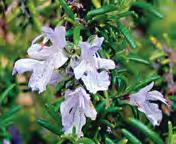
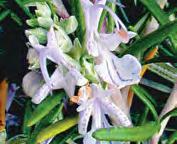

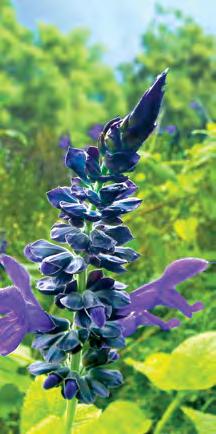
and 2015, will kill most of these plants. Rosalind Pope, of the North Carolina Unit, reports that the prostrate cultivars are the first to suffer in a harsh winter.
HSA collections held in public gardens include:
Lavandula
festival Institute, Round Top, Texas; Ashland, Oregon; National Herb Garden, Washington, D.C.
Mentha
festival Institute, Round Top, Texas
Origanum
festival Institute, Round Top, Texas
Olea
festival Institute, Round Top, Texas
Pelargonium
festival Institute, Round Top, Texas; National Herb Garden, Washington, D.C.
Rosa
Cleveland Botanic Garden, Cleveland, Ohio
Rosmarinus
festival Institute, Round Top, Texas; National Herb Garden, Washington, D.C.
Salvia
festival Institute, Round Top, Texas; Heathcote Botanical Garden, ft Pierce, florida; New Orleans Botanical Garden, New Orleans, Louisiana; National Herb Garden, Washington, D.C.
Billi Parus, (of the Tidewater area of Virginia), keeps all her rosemary plants outdoors all year. They survive the winters, in temperatures generally no lower t han 30 degrees, with an occasional dip into the 20s. Billi says, “I gave up on prostrates about four years ago because I never knew if they would survive…I think t he summer humidity bothered them and most didn’t like the winters.” Her best growers are ‘Hill Hardy,’ ‘Gorizia,’ ’Salem,’ ‘Arp,’ and ‘Mrs. Reed’s Dark Blue.’ Salvia: There are collection listings in Florida, Louisiana (3), Texas (2), Virginia and the NHG. Most of these collections are grown outdoors all year. Some species listed in all locations are: S officinalis (several cultivars), S. blepharophylla, S. coccinea, S. discolor, S. elegans, S. greggii (multiple cultivars), S . uliginosa, S. guaranitica (several cultivars), and S. leucantha. Perhaps one of the most unusual ones is S. discolor, with its almost black flowers. A popular cultivar of S. guaranitica is ‘Black & Blue.’ It occurs in the NHG and all three collections in New Orleans. This cultivar is very distinctive with its deep blue flowers and black calyces . S divinorum with its hallucinogenic properties is one of the most controversial and is rarely found in public gardens. It is a bit difficult to grow (its native habitat is mountainsides with low hanging moist clouds) and seems to “disappear” from the garden. It is also a very dangerous plant to ingest. (See Preston Miller’s article, Salvia divinorum, in the December 2008 issue of the HSA newsletter.)
The diversity of Salvias demonstrate how the same plant may grow in different parts of the country, in differing conditions and climates. S . dorisiana is difficult for some to grow requiring a warm climate, it will not tolerate cold but is lovely when grown in the proper conditions. It is named after Doris Zemurray Stone. Doris was the daughter of entrepreneur Sam Z emurray of New Orleans, who founded
the United Fruit Company. Its fuchsia flowers are hard to miss. S. oxyphora has fuchsia flowers as well and is easy to grow in the right conditions (part sun, southern climate). Many cultivars of S. greggii w ill flourish in different areas, while the species and cultivars of S. officinalis may not. The opposite is true farther north where S. officinalis cultivars are easy to grow, but those of S. greggii are difficult and must be grown as annuals.
Stefan Lura describes the Salvia collection at the NHG as a “small though representative” collection. It has about 54 plants representing 30 genera. On the other hand, collector Anne Barnes in New Orleans has about 70 plants, representing 36 genera. Of her collection, re-established since Hurricane Katrina, Anne says, “Of all the plants I had before Katrina, none survived… we had over three feet of slightly brackish water we were at the edge of the flood.”
The water stayed for about two weeks. “Salvia coccinea returned from seed and showed her pretty red flowers in the brown debris.” She also says, “Every winter I am so glad for S. greggii and S. microphylla. They rarely have any freeze damage in our climate. This is especially true for S. microphylla ‘Hot Lips.’ S. uliginosa also laughs at freezes.”
In all, HSA has eight listed collections of Salvia. One might think the NHG would have the largest collection, but it is third largest at 30 genera. Anne Barnes’ collection of 36 genera is second. Sara Holland in Texas has 26 genera, and the Pioneer Unit at Festival Hill at last count had 86 genera! That was, of course, thanks to Madalene Hill; she knew every one of the many cultivars and hybrids intimately. Further, the climate in her area of Texas is very friendly for Salvia.
Other genera with fewer collections include:
Lavandula: The only collection HSA has in the Northwest United States is in southern Oregon. Initiated by Ellen Scannell and now maintained by Rosenelle Florencechild, the Lavandula collection thrives. Ellen says that an unusual one is L.
36 37 The Herbarist issue 81 2015
Plant Colle C T ion S
Salvia guaranitica 'Black and Blue' Photo: Anne Abbott
Be LOW L ef T Rose Walk at the Cleveland Botanic Garden, Western Reserve Rose collection
Photo: Judith Kutina
Be L OW Rosmarinus officinalis 'Madalene Hill' Be L OW R GHT Rosmarinus officinalis 'Blue Boy'
P H OTOS: Anne Abbott
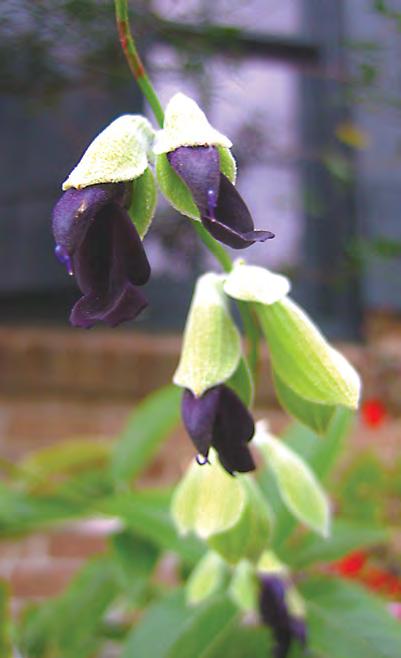
stoechas ‘Ivory Crown,’ obtained from Andy Van Hevelingen. “It has deep blue flower heads with ivory bracts.” The “desert conditions in the summer require irrigation. Most of our soil is decomposed granite.”
Origanum: The two Origanum collections, one in Texas and one in Ohio, remain in the ground all winter. Barbara Varland of Cincinnati says, “What survives is hardy here.” She waits each spring to see what has survived.
Viola: Rita Sillivan-Smith of Pennsylvania comments that most Viola are hardy outdoors. Only a few cultivars must be moved into the sunroom when weather cools. As one would suspect, all V. odorata i n the listing are fragrant. Of her 40 or so taxa, 18 genera are represented.
Citrus: Past HSA president, Dr. Arlene Kestner, who has had a Citrus collection for a number of years, was one of the first to participate in the plant collections program. She says, “the past three winters have taken their toll on the 20 mature containerized trees we moved 5 years ago. One of the specimens, Rangpur lime (C. xlimonia), amazes me for its ability to withstand multiple nights below freezing temperatures—it loses all its foliage, but by early May the tree produces a flush of leaves and flowers followed by productive harvest of fruit in late fall.” About the fruit Arlene says, “The fruit does not resemble true limes in any way. The rind’s appearance is pitted as opposed to smooth. The flavor of the fruit is highly acid—makes a great garnish with a Bloody Mary.”
A very popular citrus, now found in many grocery stores and much sought after, is C. meyeri, a strong lemon, with excellent flavor. It grows well in the New Orleans area, and gardeners delight in sharing a big crop. Hosts of dinner parties or meetings may have a basket of fruit at the front door for guests to take home. Trees do not produce well every year, but when it does, the amount can be overwhelming.
Native Plants: There is only one listed native plant collection, that held by Katherine Schlosser in Greensboro, North Carolina. Kathy says, “A bonus of working with
local native plants is that they are equally well adapted to our native pollinators, providing the food and shelter that evolved alongside them a natural fit that makes for healthy ecosystems, even gardensized ecosytems.” Dr. Doug Tallamy, a featured speaker at HSA’s 2015 Educational Conference in Williamsburg, encouraged planting for the wildlife. Participants in the HSA GreenBridges program would be good candidates for collection listings! Two of Kathy’s favorite natives are Cunila origanoides and Solidago odora Cunila origanoides (Maryland dittany or frost-mint) is found “on a forest floor of dappled shade—a delicate plant with a punch of unexpected flavor. That flavor comes in part from thymol and carvacrol— it has been used to make a hot beverage, and as a flavoring in foods. It also had medicinal uses for a number of Native American tribes.”
The dried leaves and fully open flowers of Solidago odora (anise-scented goldenrod) have been used to make beverages. Also from Kathy, “it has a pleasant tarragon-like fragrance and taste due primarily to the estragole and myrcene content—it grows well in sun or a little shade, and even tolerates dry soil once established. It also had many medicinal uses.”
National Herb Garden Collections: Lavandula, Pelargonium, Salvia and Rosmarinus. According to Stefan Lura, in Plant Records at the USNA, the first three are in good shape from a nomenclature and identification standpoint, though the Rosmarinus needs further study. The Pelargonium collection is all in containers a nd is moved to a greenhouse each year to avoid the winter cold. The Lavandula are propagated regularly because of frequent disease problems. The Rosmarinus that
stay outside have major freeze damage or are killed by the cold, so cuttings are taken each year to assure survival of the collection. Garden curator Chrissy Moore reports that they won’t know which plants have survived the winter until spring allows a chance for them to come back. For record keeping the USNA uses BG Base, used by many botanical gardens and arboreta around the world, and recommended by the NAPCC. This allows easy exchange of plant information.
Plant Collections Committee Acknowledgments
Dr. Arthur Tucker and Rexford Talbert have been most influential in the plant collection committee work, giving moral support and helping unravel the mystery of nomenclature! Madalene Hill was on the committee as well and spent much time shepherding me around her collections, particularly the Rosmarinus and Salvia.
References
• APGA. American Public Garden Association. http://www.publicgardens.org Accessed June 17, 2015
• ARS-GRIN. National Genetic Resources Program. http://www.ars-grin.cov Accessed June 17, 2015
• NAPCC. North American Plant Collections Consortium. http://www.publicgardens.org/napcc Accessed June 17, 2015
• Ober, Richard, ed. 1996. The National Herb Garden guidebook. Springfield, VA: Potomac Unit of The Herb Society of America.
• Schlosser, Katherine, ed. 2007. The Herb Society of America’s essential guide to growing and cooking with herbs. Baton Rouge: Louisiana State University Press.
• USDA-ARS. USDA Agricultural Research Service. http://www.usda.ars.gov Accessed June 17, 2015
• USDA Plants Database. http://plants.usda.gov Accessed June 17, 2015
• USNA. United States National Arboretum. http://www.usna.usda.gov Accessed June 17, 2007

Anne Abbott has been a member of The Herb Society of America since 1990, joining the Rosemary Circle at the 2015 conference in Williamsburg. She has been associated with the Plant Collections Project since 2001. Anne is a Master Gardener and a Master Naturalist in New Orleans. She was president of HSA from 2006–2008 and is the immediate past president of the New Orleans Botanical Garden foundation. She is plant collections chairman for the New Orleans Botanical Garden and in 2010 wrote the plant collections policy for the garden. She is a member of American Public Gardens Association (APGA), in their plant collections and nomenclature sections. Her passion for plants, particularly Salvia and native plants, and her involvement in HSA began with her sister, Jamie Barrow, HSA president 1992–94. She is also the founding chairman of the New Orleans Unit, remains active in that unit, and is a non-resident member of the Potomac and North Carolina units.
38 39 The Herbarist issue 81 2015 Plant Colle C T ion S
Salvia discolor taken at the New Orleans Botanical Garden Photo: Anne Abbott
GreenBridges:
Lorraine Grochowski-Kiefer
Forty years ago the National Wildlife Federation (NWF) created a backyard habitat program to encourage people to make their gardens wildlife friendly. My family was one of the first 100 families to qualify and create a certified wildlife habitat by providing food, water and cover, and my passion for natural gardens was born. The NWF reports that now gardeners have created nearly 200,000 certified wildlife habitats (National Wildlife Federation 2015).
More recently The Herb Society of America’s native herb conservation committee developed the GreenBridges program in 2008. Open to all people, GreenBridges is a program that guides gardeners to learn more about native herbs and plant them in their home landscape; to eliminate invasive plants that eventually smother and take the habitat of the natives and to provide food and shelter for wildlife. Members who participate become familiar with ecosystem function and find reputable sources for native herbs. Some members protect stands of wild flowers in their communities.
According to the HSA website, “GreenBridges guides individuals in assessing their personal gardens and encourages participants to consider small changes to benefit the environment.” The Society stresses that everyone needs to be concerned that highways, shopping centers, and manicured lawns create barriers for the butterflies, bees, and other insects on which we depend to pollinate the plants that feed and clothe us, and provide us with medicine, fragrance, and beautiful gardens. GreenBridges promotes a simple and interactive program to support gardeners in their attempt to provide places for pollinators to live and thrive.
The South Jersey Unit has always had an interest in native herbs and for several
years had a native plant study group. But after a very informative slide show presented by Katherine Schlosser, HSA member and first chair of the native herb conservation committee, we were ready to go one step further and encourage other members to plant native herbs in their landscape.
We first gleaned information on native herbs, pollinators, garden design, and alternatives to invasive plants. Everyone was asked to read the book The Harvester by Gene Stratton Porter. (Note: this is a romantic, old-time book, but it reinforced what we learned from our studies.) We met from fall to spring. After our monthly discussions and presentations many in the group were ready to plant. One night we studied the native persimmons that grow just outside my backdoor. I told the group that in fall many birds and animals enjoy the fruit. In winter, cedar waxwings visit the tree on their way back north to nest, and we often see possum, skunk, and raccoons eating the fruit as well. While we enjoyed some of these tender, sweet, apricot-like fruits at the meeting, I explained that more than forty years ago when we built our rustic home in the trees, my dad had encouraged us to save the persimmon, as well as the many hollies, cedars, and oaks. Today I really value these trees that represent a generation of growth. When we studied the native poison ivy antidote, jewel weed or touch me not, we collected it in my garden. We each made some of the poison ivy remedy potion. Everyone brought a clean glass quart jar with two cups of cider vinegar to which we added lots of jewelweed leaves. Besides having a live plant to take home, we pressed some samples of the plant for study guides.
We studied cedar, wintergreen, butterfly weed, native mountain mint, elderberry,

GreenBridges promotes a simple,interactive program to support gardenersintheir attempttoprovide placesforpollinators to live and thrive.
40 The Herbarist
Issue 81 2015 41
PHOTO Susan Betz
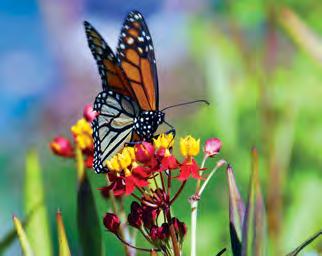
black cohosh, bloodroot, ginseng, and bearberry as well as several others. In an April session we went for a walk in the woods. The trailing arbutus was in bloom and many smelled it for the first time.
As we explored the botanical names and facts about the plants each month, we also used them.
Sumac and Cedar
We researched these two native plants last December. Both have been used in many ways since ancient times. In the1960s Euell Gibbons wrote about the pink lemonade he made from sumac berries. Birds love sumac berries and will even eat them from a Christmas wreath. Native cedars are very good trees that support wildlife, and the berries have long had many uses by ancient people. Cedar berry has been used in the past to treat cough, fever, rheumatism, diabetes, tuberculosis, scurvy, and toothache as well as to promote menstruation. We made natural cedar wreaths and then trimmed them with red sumac berries.
Bayberry
Bayberry was another of the native plants studied by the group. I picked berries from the plants that have naturalized at our farm. We heated the bayberries in melted beeswax and allowed them to simmer for
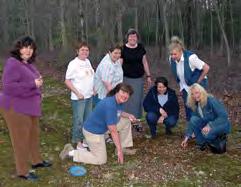
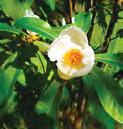
several hours until the wax was the color of bayberry candles. Each member poured a candle in a small paper cup to take home. Both native people and early colonists used these plants.
After we learned more about the local natives and were able to identify them, we discussed each member’s garden. Some were in the woods, some in a new sunny but bare development, and others in established yards. The challenge was to find places in each yard to plant butterfly plants, to make a garden for birds with berries, seeds and cover, and to plant for shade and privacy. I found it very important to stress that to be successful they must find plants that will thrive in their location. Always have soil tested if in doubt about its quality. If your garden appears to be all shade and you really want a butterfly garden, you can walk around the yard at noon and find the area that is sunniest. Sometimes you may have to prune a few trees limbs to let in more sun. An alternative is to plant pots and place them in sunny spots. Those with sun and well-drained soil can plant as much butterfly weed as they want and it will thrive. Most people planned to add a bird bath or fountain and some even considered a small garden pond. I have a great advantage in having the Maurice River head waters running through our property. Numerous
were waking up!
Another member, Lillian Bonser, said, “I have seen a wonderful change in the increase in wildlife, birds, bees and insects since I began my GreenBridges/native garden. I am in the process of changing my front yard, though it is small, into a native plant garden.”
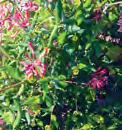
berry bushes such as elderberry, raspberry, blackberry, blueberry, currents, rugosa rose hips, spicebush, hollies, and pines all provide food for many kinds of birds. These in turn eat larvae of gypsy moths and other harmful insects.
Many of our members now have their gardens GreenBridges certified. One of our longtime active members, Mitzi Kowal, has a very special yard with a pond and borders containing both evergreens for shelter a nd trees for perching. She has added hundreds of perennials, berry shrubs, vegetables and annuals to her gardens. Now they abound with birds and other small critters as well as butterflies, moths, and other beneficial insects.
Mitzi says, “I enjoy the special features all year long. There is water for the animals to drink, but there are also frogs and fish in the water.” She especially likes the late bloom and color of the Franklinia in fall and the winterberry in winter. She says, “These berries are great for holiday decorations, and they bring color to the gray dreary days of winter. When the birds come to eat them there is color, movement, and song in the garden.” She recently sent me a photo of the red native honeysuckle. She had spotted the first hummingbird of the season on it and expressed her joy that spring had finally arrived and that her GreenBridges gardens
One of my GreenBridges projects was to plant more milkweed everywhere I could. I always loved the various milkweeds but noticed a few years ago that the railroad company was spraying all along the tracks on the other side of our swamp right where the butterfly weed grows. Then we saw the state highway people spraying the roadsides for the entire length of our long state highway. This really took a toll on all Asclepias species! We never mow it around our Christmas tree farm and I let it reseed all over the herb gardens. The monarchs come for it each fall.
The South Jersey Unit will continue to support GreenBridges and will have another study group this year. It is important for members to share information about the program with the general public and encourage everyone to make a GreenBridges garden. I will promote it the annual herb weekend at Triple Oaks Nursery and Herb Garden, part of the Kiefer family business.
I want to finish with these words from Katherine Schlosser as she described her philosophy of GreenBridges:
“GreenBridges is a vision a place of gurgling water, mossy rocks and lush vegetation. It is a metaphor for transition from one place to another, and connections between iso-
lated locations. It is a plan for taking a step toward the resolution of problems faced by plants and our environment. It is a gathering place for gardeners interested in native herbs.”
“Many of America’s native herbs are at risk from over-collection because of their economic and ornamental value. Some of these herbs, used for centuries to provide medicine and to flavor foods, are still collected from the wild at alarming rates. Others of our native herbs are at risk because of encroaching development and the resulting fragmentation of ecosystems.”
“Restoration of our varied ecosystems is possible, starting with the way we garden at home. A broadened view of the human needs addressed by a garden includes: 1) assessment of our habitat type; 2) garden design that meets our needs and complements our surroundings; 3) informed plant selection; 4) planning for pollinators; and 5) removal of invasive plants.”
“Our gardens should not only meet our personal needs, but also blend easily with nearby ecosystems, creating corridors that support biodiversity. Not all of the plants in our gardens have to be native plants to achieve a life-affirming approach to gardening, nor must we adopt a completely natural garden style. Finding a balance between our needs and the needs of the earth that supports us is the goal of the GreenBridges program initiated by The Herb Society of America.”

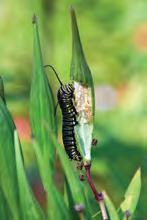
Literature Cited
National Wildlife federation: www.nwf.org/How-to-Help/Garden-for-Wildlife.aspx (Accessed May 25, 2015)
The Herb Society of America GreenBridges Initiatives: www.herbsociety.org/greenbridges/greenbridges-initiatives.html (Accessed May 25, 2015)

Lorraine Grochowski-Kiefer received The Society’s Helen De Conway Little Medal of Honor in 2013 for her active and long-time support of HSA programs and her ongoing herbal and horticultural educational activities through her writings and classes. She is a charter member of the South Jersey Unit and has been a member of HSA since 1982. She is a past contributor to The Herbarist and has provided many lectures for the HSA educational conferences. She has served on the National Herb Garden committee and currently is a member of the native herbal conservation committee, with a focus on the GreenBridges program. She and family own and operate Triple Oaks Nursery & Herb Garden in franklinville, New Jersey.
42 43 The Herbarist issue 81 2015
Study group on nature walk P H OTO : Lorraine Grochowski-Kiefer
Blooming milkweeds provide nectar for many butterflies P H OTO Andy MacPhillimy
Franklinia alatamaha P H OTO : Lorraine Grochowski-Kiefer
Lonicera sempervirens ‘Red honeysuckle’ P H OTO Mitzi Kowal
GreenBridges
GreenBridges supports many pollinators P H OTO Andy MacPhillimy
Milkweed serves as a larva host plant P H OTO Andy MacPhillimy
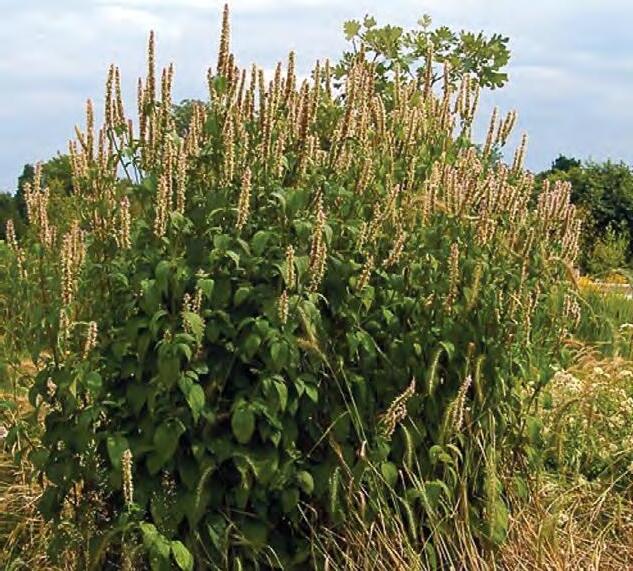
MSome form of the promising plant program has been part of the fabric of The Society since the days of the founders. At the first meetings, members brought and exchanged plants to encourage others to grow them. Later HSA board meetings included a presentation by the botany and horticulture chair showcasing new introductions or favorite herbs. A program of promising new or underutilized herbs became part of the annual educational conference with a few plants informally distributed to interested members. Clearly, sharing promising plants has been a hands-on opportunity for members to contribute to HSA’s mission of promoting the knowledge of herbs “for use and delight”. Over the years the program formalized a process of plant selection, plus mechanisms for recording and reporting plant growth. The promising plant committee nominates and then votes to select plants. An educational conference presentation both summarizes results from growing the previous year’s plants and introduces the selections for the current year. Often, seeds and/or plants are distributed to members who agree to report the results. Since 1999, 335 herbs have been selected for this program. The 2015 selections contained annual, perennial, and woody plant categories, plus HSA’s Notable
Native and the International Herb Association’s Herb of the Year for 2016.
Where Are They Now?
Origanum dictamnus, Dittany of Crete (fig 1.), was perhaps the first plant that HSA successfully introduced into the United States. Harriet Addams Brown issued a challenge to HSA members in the first issue of The Herbarist with this statement: “The restoration of this historic plant to common knowledge and its propagation on these alien shores would be an interesting and worthwhile project for those members of The Herb Society who ‘delight in looking backward.’” Anne Burrage then asked her friend, Mrs. Ellery Sedgewick, to bring the plant back from her visit to Greece. Mrs. Sedgewick went to a great deal of trouble to identify the plant, enlisting translators, the cruise director ,and a former cook to find the plant; she hand carried the first dittany back with her. While this plant may not be commonly grown today, it is readily available all over the country. (Anne Burrage’s story of this search appears in the second issue of The Herbarist, 1936, pp. 58 – 60.)
Satureja biflora, lemon savory appeared in the 1999 promising plant selections. Today that plant is known as Micromeria biflora (The Plant List). It is still not widely known in culinary circles. Lemon savory
has a distinct lemon flavor that makes it suitable for dessert dishes. This savory is even a possible substitute for lemon verbena or lemon thyme. Lemon savory is cultivated as an annual in most of the United States. With an average height of six to eight inches, it makes a nice container or border plant. Read more about savories in The Herb Society of America’s Essential Guide to Savory (The Herb Society).
Cymbopogon citratus, lemon grass (fig. 2), was named as a promising plant in 2003. Commercial cultivation of lemon grass in this country began in 1947 (Department of Export Agriculture). An under-used plant when presented at the educational conference, lemon grass is now widely available across the country in nurseries and even in the garden departments of “big box” stores. Reaching four to six feet in height, lemon grass makes a statement in the landscape or as a large container plant.
Salvia officinalis ‘Berggarten’ (fig. 3, next page) is a variety of sage selected for its compact habit, large silvery gray green leaves and pungent flavor. Selected as a promising plant in 2008, this variety has become increasingly popular for both ornamental and culinary qualities. The leaves of ‘Berggarten’ are larger and more round than the common sage, Salvia officinalis It is hardy in zones 5-8 and like other sages, prefers full sun and well-
ThePromise of Promising Plants
ost gardeners know there are always new plants to explore . Those who grow and adore herbs believe this is true not only for new introductions, but also for those plants that have been grown over the years Some remain known locally only to a few, have fallen out of favor or are newly rediscovered . Plants that are the subject of lore and legend need to be promoted to keep their heritage alive The sharing of this knowledge of both new and under-used plants is the focus of HSA’s Promising Plant Program .


44 45 The Herbarist issue 81 2015
Karen Kennedy
fig.1 Origanum dictamnus, Dittany of Crete fig. 2 Cymbopogon citratus, lemon grass
drained soil. Gloria McClure, then botany and horticulture chair, noted that S. officinalis ‘Berggarten’ was first introduced in the United States in the late 1960s.
The promising plant program serves to raise awareness of plants that are native, rather than introduced . Agastache scrophulariifolia (purple giant hyssop, fig. 4), presented in 2005, is an example (United States Department of Agriculture). Its native range extends as far south as Georgia and as far north as Ontario, Canada. According to the USDA, it is endangered in Connecticut and Massachusetts, threatened in Maryland and Vermont and of special concern in Kentucky and Tennessee. A root infusion of this hyssop was used by the Great Lake’s Native American tribe, the Meskwaki, as a diuretic. It is an excellent nectar plant for pollinators. Ironically, the flower is such a pale purple that it almost doesn’t appear purple unless viewed closely.
Belamcanda chinensis now known as Iris domestica, is a member of the Iridaceae family. Blackberry lily is attractive as a garden plant with its spotted orange flowers, fan shaped leaves, and low maintenance requirements. The plant makes a garden statement in the fall when the seed pods open to reveal blackberry-like fruit. It is hardy in zones 5–10 and prefers a sunny, well-drained location. Selected as promising in 2006, blackberry lily has a long herbal history in Chinese medicine. (fig. 5a & 5b) HSA’s promising plant program is an excellent way to highlight plants worthy of more exploration and, perhaps, inclusion in gardens. Members interested in past and present promising plants may view some of the lists and descriptions on HSA’s website. The excitement and interest generated by reading the descriptions is a way of sharing plants and knowledge, a tradition begun by our earliest members.
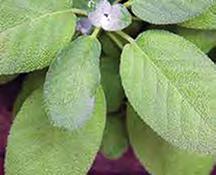
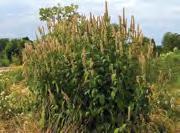
Visit the Units’ Gardens! Learn, Explore, Grow...
Literature Cited
Department of e xport Agriculture (Sri Lanka). Updated August 16, 2010. http://www.exportagridept.gov.lk/web/index. php?option=com_content&view=article&id=135&Itemid=159&lang=en (Accessed August 4, 2015)
The Herb Society of America. 2015. e ssential Guide to Savory. http://www.herbsociety.org/herbs/documents/2015_ e ssentialGuidetoSavory_Web_000.pdf (Accessed June 29, 2015)
The Plant List. World Checklist of Selected Plants. http://www.theplantlist.org/1.1/about/#wcs (Accessed August 8, 2015)
United States Department of Agriculture. Agastache scrophulariifolia http://plants.usda.gov/core/profile?symbol=AGSC (Accessed June 29, 2015)

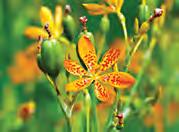
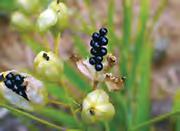
Karen L. Kennedy, HTR, as HSA’s education Coordinator since 2012, coordinates educational webinars, gives presentations and produces educational materials. In addition, she is a registered horticultural therapist (HT) with 30 years of HT and wellness programming experience in health care, social service organizations and public gardens. A faculty member since 2002, she teaches introduction and programming courses at the Horticultural Therapy Institute. She served on the board of The American Horticultural Therapy Association and contributed to textbooks in the field. Karen received the AHTA Rhea McCandliss Professional Service Award (1994) and the American Horticulture Society Horticultural Therapy Award (2009). She holds a Bachelors’ Degree in horticultural therapy from Kansas State University.
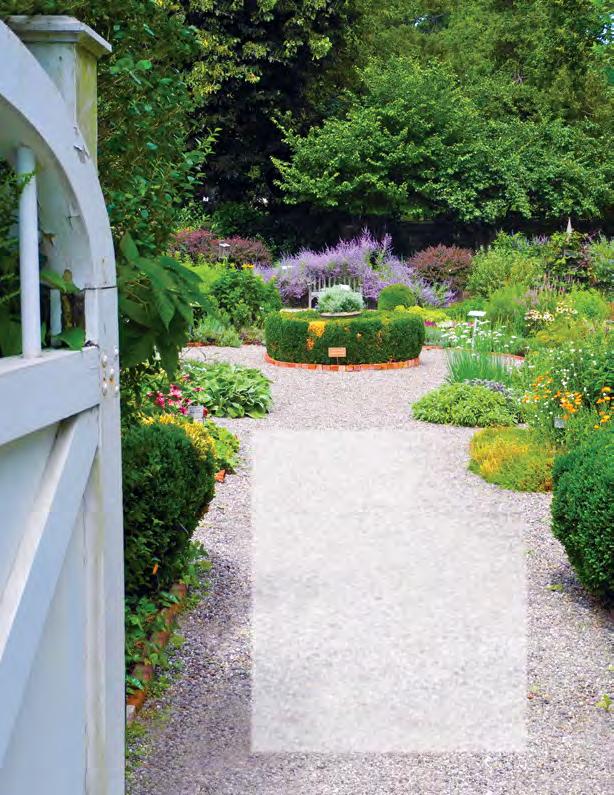 Lois Sutton Ph.D. Editor and Chair of The Herbarist Committee
Lois Sutton Ph.D. Editor and Chair of The Herbarist Committee
In 2014 the HSA board asked units about their gardens . The survey included a myriad of questions with several purposes:
1 To share and increase awareness of the gardens supported/maintained by our members
2 . To establish an ongoing database detailing these gardens
3 To gather management tips for establishing and maintaining a garden
4 To learn how the units matched their garden to the needs of the stakeholders the site ‘owners’, garden users and garden workers/volunteers
5 To hear the stories each responding unit had to tell about their garden
continued on next page
46 The Herbarist
Promise of Promising
The
Plants
fig. 3 Salvia officinalis ‘Berggarten’
fig.4 Agastache scrophulariifolia
fig.5b Belamcanda chinensis seeds
Issue 81 2015 47
fig.5a Belamcanda chinensis flower
By The Herbarist submission deadline, we had twenty-two surveys in hand from units diverse in size, location, and focus. Our herbal footprints appear in highly visible and highly utilized public botanical venues as well as guarded locations, not open to the public, but providing every bit as strong a service to the users. The Society’s tag line–Learn. Explore. Grow.–comes alive in these garden stories. This a rticle is one that introduces some of these gardens; other pieces will appear in future Society publications.
Note: A similar survey is planned to learn about the gardens supported, designed, planted, weeded, donated, and taught in by The Society’s many members at large.
Gardens at Historical Sites
“Political intrigue, tavern life and the 18th century culture are all available in a single visit to the corner of West Market Street and North Pershing Avenue in downtown York, Pennsylvania. Four buildings reflect both private and public lives in early York. The Pennsylvania German Golden Plough Tavern, built in 1741, demonstrates
the significant role a tavern played in a community as a hotel, restaurant, and source of news. The General Gates House reflects the year 1778 when General Horatio Gates occupied the house while the Continental Congress met in York. Just across t he street you can visit a reconstruction of the Colonial Court House where the second Continental Congress met during York’s nine months as the capital of the United States. The Barnett Bobb Log House, built with squared timbers in 1812, and relocated to the site, highlights an average Pennsylvania German home in the early 19th century” (York Heritage Trust). The Mason-Dixon Unit’s garden is the Colonial Kitchen Garden at the Golden Plough Tavern Courtyard.
The garden follows a traditional foursquare pattern “with smaller beds lining the perimeter. There are vegetables in two squares, medicinal plants in the third square, and household plants in the fourth square. Herbs grow in the outer beds. The garden, fenced with a front and back gate, has no other permanent structures inside the fence. The historical tavern and kitchen
provide a lovely backdrop. The Heritage Trust staff uses plants from the garden in their kitchen and squirrel oven for demonstrations” (Mason-Dixon Unit).
The nearby Agricultural and Industrial Museum has held an oyster festival for 40 years. Besides providing funding for the York Heritage Trust, the festival provides the oyster shells that form the paths and keep the weeds under control, “which is very appropriate since we have learned that oysters were brought up from the port of Baltimore for early settlers” (MasonDixon Unit).
Two units maintain gardens at sites associated with early Supreme Court Chief Justices: the New York Unit at the John Jay Homestead State Historic site in Ketonah, New York, and the Virginia Commonwealth Unit at the John Marshall House in R ichmond, Virginia.
After his term as the first Chief Justice (1789–1795) John Jay retired to his farm in 1801. Amazingly the farm “remained in the Jay family as a working farm until 1953, when it became a New York State Historic Site” (New York Unit). The unit describes
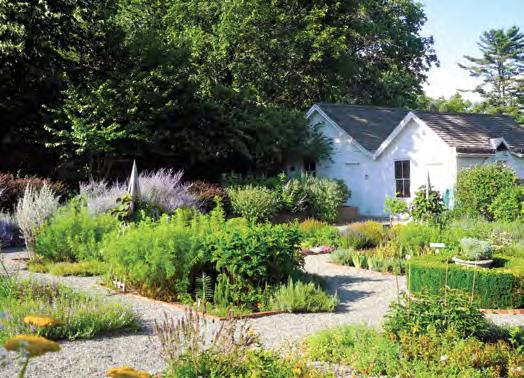
the garden, and rightly so, as “extremely large.” The 5,550-square-foot garden sits in the area that once included the cutting garden and greenhouses of the Jay family. Page Dickey, garden designer, writer, co-founder of the Garden Conservancy, and unit member, designed the garden. “Its layout is traditional and formal. Within the beds, the plantings tend to be more informal. From a central urn, the main paths radiate out, dividing the garden into four main sections of herbal plants according to use: medicinal, culinary, fragrance, and pest repellent. In addition, there is a special sage border and a border of Rosa rugosa The northern part of the garden contains a bed of dye plants and two long borders of shrubs and ground covers. For vertical interest, there are four tuteurs covered with lablab (hyacinth bean) vines, one in each of the main sections. There are also two historic potting sheds associated with the garden. An unusual and nice feature of the garden is the vantage point when one arrives. The parking area and the adjacent green space, elevated by a retaining wall, offer a bird’s eye view of the entire garden and its layout” (New York Unit).
The Virginia Commonwealth Unit “took on the project of restoring a garden on the grounds of the John Marshall House” in 1994. Marshall served as the Supreme Court Chief Justice from February 1801 until his death on July 6, 1835. The “lovely brick Federal style home…remained in the family until the early 1900s and is now the property of Preservation Virginia.”
The unit writes in its educational brochure about the garden, “After completing an extensive renovation of the house in 1976, the museum staff decided to install a small formal garden on the property By 1993, the garden had been simplified, and the only plants remaining were the Buxus sempervirens ‘American boxwood’ and Centaurea cineraria ‘dusty miller’. In March 1994, The Herb Society of America, Virginia Commonwealth Unit, began restoring the garden.”
While no records remained of garden plans at the house, the unit began its restoration by placing boxwood “rooted from those at Mount Vernon” in the
four corners of the garden. “The rest of the square is planted in herbs available during the Federal period along with some flowers and bulbs of that time” (Virginia Commonwealth Unit).
was begun in 1777 and completed in 1778. Called Washington Hall, it was the only hospital commissioned during the Revolutionary War, and the first military facility” (Philadelphia Unit).
Colonists
in Philadelphia visited Yellow Springs to use the iron-rich water for healing. By 1722 doctors were suggesting… that the mineral springs be used for drinking and bathing.
Medicinal Herbal Gardens
Many units indicated that part of their herbal plantings were those historically or currently used for health or medical management. The Medicinal Herb Garden at Historic Yellow Springs, installed and maintained by the Philadelphia Unit, epitomizes such a garden. “The Leni-Lenape people named Yellow Springs prior to any European settlement. Colonists in Philadelphia… v isited Yellow Springs to use the iron rich water for healing. By 1722 doctors were suggesting… that the mineral springs be used for drinking and bathing” (Philadelphia Unit).
“Dr. Samuel Kennedy bought the springs in 1774. General George Washington retreated to the Yellow Springs Inn after the Battle of Brandywine. Here he established temporary headquarters and later during the encampment at Valley Forge petitioned the Continental Congress to build a medical facility to improve the health of his army. Dr. Kennedy loaned a portion of his property to Congress for the construction of a hospital. The original building
The Philadelphia Unit planted their garden at the site of the hospital ruins in 1987 and recently finished a garden renovation. “The garden includes many of the plants for medicinal use available locally in the 18th century. The list of plants was taken from a lecture on herbs given by Dr. William Shippen in 1765 The doctors, nurses and assistants at Washington Hall would have been wholly familiar with the healing benefits of herbs and would have used them to nurse the soldiers.”
At the garden, the unit has educational pamphlets with the complete list of plants and their historic uses. To further encourage herbal/horticultural learning, another handout challenges visitors with such questions as the following:
• If you had a headache in 1777, name three herbs you might try. Can you find them in the garden?
• What plant makes you think of a clock?
• How many plants are women’s names? Can you find any of them?
The National Institutes of Health (NIH) sits on a large, rolling, and attractive site in Bethesda, Maryland. Unless you have had the privilege of attending a medical conference or doing research associated with the Institute, you might not know that this is the site of an herb garden. A mistake! Since the 1976 bicentennial celebration a medical herb garden has graced the front landscaping of the National Medical Library. “In 1986 the Potomac Unit was invited to take over the maintenance of the garden. We have been digging, planting, clipping and weeding ever since.”
The garden now is a 40x 44-foot rectangle. “The layout is traditional with four t riangles around a sun dial. Each triangle is divided by a hedge resulting in eight smaller units.” There are four corner beds and five large containers the unit uses for special plantings. Overall the unit provides around 800 volunteer garden hours, from April into November. Visitors to the
49 issue 81 2015
Visit the Units’ Gardens!
New York Unit gardens at the historic John Jay Homestead, in a view from above.
garden are NIH staff, the national and international visitors to NIH, as well as the “campus herd of deer and many rabbits” (Potomac Unit).
The Library’s garden has two unique elements. In conjunction with an exhibition exploring health and medicine “among contemporary American Indians, Alaska Natives, and Native Hawaiians” the Library installed a healing totem, carved by the Lummi Nation master carver, Jewell James. In 2014, a clone of the tree of Hippocrates (Platanus orientalis from Kos, Greece) was planted in the garden.
herb garden at the National Herb Garden in the National Arboretum, Washington, DC. However the Mill became a gathering place for the Stockton community, which needed our space. Thus, in 2001 the garden was moved south to Lambertville” (Delaware Valley Unit).
“The Holmstead-Jamison Farmstead trustees gave us an area between the 1711 house, the oldest house in Hunterdon County, and the museum’s print shop.
Because we were no longer next to a mill, we slowly developed the new focus of an international culinary herb garden repre-
Likewise the Northeast Seacoast Unit shares the story of changes in the medicinal herb gardens at Strawbery Banke Museum in Portsmouth, New Hampshire: “As the Museum’s mission changed overtime, the living collection in this garden was expanded to include the herbs used by all generations of immigrants to the region.“
In 2013, the garden was re-designed by John Forti to more clearly depict the plants of generations of immigrants who populated the area. “The garden is divided into six regions: the Americas, eastern Europe, western Europe, the Mediterranean area,

Gardens Reflecting the Herbal Traditions of Local Settlers
A garden may begin in one location with one theme and then mov e— or change themes. The Delaware Valley and Northeast Seacoast Unit gardens remind us that gardeners must be adaptable.
For many years the Delaware Valley Unit had an “industrial garden at the Prallsville Mill, Stockton, New Jersey. It was only the second industrial herb garden in the United States, the first being the industrial
senting herbs that have been brought here by people from all over the world who now call the Delaware Valley home. Although the garden seems small, a good number of international herbs are grown. These herbs are planted in seven sections of raised beds: Europe, Mexico, Central America, South America, Africa, India, and Asia. How nice it is to have a visitor recognize a particular plant that grew in her or his mother’s garden and then show us how they use it!”(Delaware Valley Unit)
Africa and Asia. Each section highlights culinary and medicinal herbs that either are native to this region or were brought here by early colonists, free and enslaved African populations, and other immigrants from around the world who settled in the Portsmouth area.”
“The center of the garden contains a knot garden displayed in a raised bed surrounded by a wattle fence woven from apple branches pruned in the museum’s heritage orchards. The entry arbor is a replica of
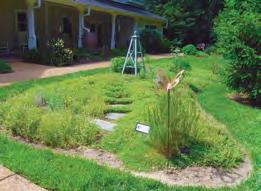


a 19th century Portsmouth design” (NorthEast Seacoast Unit).
Gardens Serving Special Populations
Many units support more than one herb garden but within these gardens there often is one that serves a special population or purpose. In 2006 The Herbarist carried Claudia Van Nes’ article, “Herbs Heal in Women’s Prison”. She wrote about the biblical herb garden flanking the entrance to the chapel at the York Correctional Institution and the adjoining four-square plot planted as a memorial to inmates who had died. Their survey noted that “by 2012 prison logistics restricted access to the chapel area for visitors.”
The Connecticut Unit further reported “another growing opportunity arose at that time with plans for a large vegetable plot to be developed within the maximum security section. Prison officials welcomed the unit’s proposal for an herb garden adjoining the vegetable plot. For more than three years it has been a privilege to watch restoration of a greenhouse now producing seedlings to propagate the 70x 100-foot vegetable plot and herb garden. Both gardens are maintained by a crew of dedicated inmates who water, weed, and harvest vegetables and herbs for the prion kitchens with a ny excess donated to local food banks.”
“The chef and students in the culinary training program regularly visit the garden to experience the herbs, consult with the volunteers, and harvest herbs for use in the
classroom.” In June 2014, three unit volunteers were invited to present a ‘Growing a nd Cooking with Herbs’ workshop. The class, with much interaction and a feast of herbal treats, has grown into plans for future seasonal workshops.
“Who benefits more inmates or volunteers? It’s anybody’s guess as we are all sisters working together, enjoying fresh air, a cool drink of water, companionship and
Support Care of Williamsburg. The gardens
“consist of a kidney-shaped fragrance garden, a free form culinary (kitchen) garden, a nd a circular silver-leafed garden. While there are no specific plant collections in any of the gardens, there is an obelisk in the fragrance garden and a metal butterfly with an engraved plaque. This butterfly sculpture serves as a memorial to Barbara Brouse, the unit’s founder.”
Who benefits more…?
It’s anybody’s guess as we are all sisters working together, enjoying fresh air, a cool drink of water, companionship and the joy of watching plants grow and thrive – a testament to hope.
Living butterflies are the focus of the gardens of the Hill Country Unit. At a community venue, the Emily Ann Theatre and Gardens, the gardens and two theaters have become a showplace in the Central Texas area and attract more than 10,000 people for two major annual events: Butterfly Day, with its release of 3,400 Monarch butterflies, and Christmas Trail of Lights. The original small Mediterranean herb garden is nestled in a limestone cliff.
the joy of watching plants grow and thrive – a testament to hope” (Connecticut Unit).
Gardens adjoining medical care centers offer glimpses of the hopeful or peaceful setting needed by visitors and patients alike. The Colonial Triangle Unit maintains three gardens at the site of Hospice
“In 2011 we were asked to develop a children’s herb garden located in the children’s activity area of this 15-acre natural setting. Our Children’s Sensory Garden is designed to attract and engage children, providing information about and appreciation of Texas native and adapted herbs for culinary, craft, ornamental, and medicinal uses. It also provides knowledge of the unique herbal environment found in the Texas Hill Country. Partnering with the local middle schools Science Department, we are developing hands-on activities to support the botany curriculum for the local middle school” (Hill Country Unit).
50 51 The Herbarist issue 81 2015
The Northeast Seacoast Unit volunteers at the Strawbery Banke Museum. Note the low wattle fence around the central bed.
Colonial Triangle Unit Garden 1
Visit the Units’ Gardens!
L. The Colonial Triangle Unit garden with a stepping-stone path through the fragrant garden. R. The Hill Country Unit participates in the annual release of over three thousand monarch butterflies.

Small Gardens with Big Impact –No Matter What Their Location(s)
The Ella Ruth Herb Garden, established in 2010 on the grounds of the historic 19th century Wynne Home Arts Center in Huntsville, Texas, has quickly become an integral part of the music and art festivals held at the mansion. “The garden is named after the two young girls who grew up in the Wynne Home in the early 1900s, Samuella and Ruth Wynne. The garden was designed by Texas Thyme Unit members. It is divided into sections for culinary, medicinal, and fragrant herbs. The focal point of the garden is a statue of a young girl, serenely looking over the garden. We call her Ella Ruth. Ella Ruth is surrounded by a ring of fragrant lavender. The garden is shaded by a stately, old pecan tree. Concrete table and benches surround the garden and invite visitors to sit and enjoy the views of the beautiful and peaceful garden” (Texas Thyme Unit).
The Shenandoah Herb Society demonstration garden, developed in 2010 as one of its first projects, is located at the Sunflower Cottage, a Middletown, Virginia, full-service garden center. “The garden exemplifies the challenges we face in organizing our gardens. The garden was originally divided into ‘rooms’: culinary, healing, scented, mints, and thymes, with an area for experimental plants. When teaching visitors about the herbs, it became confusing to explain why, for example, thyme was located in the ‘mints and thymes’ area and not in the culinary area due to its common use in foods, or
in the healing area because of its powerful antibacterial properties. Of course, it could be also added to the scented area because of its wonderful aroma! So though plants may still be grouped together loosely as culinary, healing, or scented, we no longer designate rooms by those categories” (Shenandoah Herb Society).
Dedicated in 1998, the Long Island Unit herb garden is located at the Post-Morrow Foundation in Brookhaven, New York. The 38’ diameter circular garden is planted with herbs recognized for their drought tolerance and deer resistance. “Our sandy Long Island soil is ideal for herbs that require good drainage and many varieties in the Lavandula, Origanum and Thymus genera flourish in our garden. We do not water this garden in summer, so the plants must withstand the heat and drought conditions of this open, sandy site”(Long Island Unit).
Like many Long Island communities, Brookhaven hamlet is home to a large deer population. It has been essential to use herbs in this garden that are not favored by deer.
“For the most part, we have been successful with our plantings and have succeeded in keeping the deer at bay. However, over the years, we have found some herbs that are said to be deer resistant do not prove be so. For instance, Echinacea or purple coneflower in our garden was heavily browsed. Once we realized this was more than an isolated incident, we removed all of the coneflower from the garden. It is important to deter deer as early as possible for once the deer establish their foraging route, it is very hard to intervene.”
“New York Unit member and well known garden designer Page Dickey advised us on the original garden design. She encouraged us to consider a hedge as a defining element. We were able to purchase the boxwood for the hedge with a generous donation from Charles Embree Rockwell in memory of his wife, Long Island Unit founding member Emma Lee Rockwell. Garden designer Kathy Fleming suggested that the garden be circular as it is a geometric shape that would be harmonious with this natural setting. The garden is divided into four quadrants with the opposite pair mirroring each other’s plant-
ings. In addition to Buxus sempervirens ‘Suffruticosa’, perennial herbs included are Lavandula ×intermedia ‘Grosso’ as well as several varieties of Santolina and Stachys. Annual plantings of scented pelargoniums prove to be reliably deer resistant and drought tolerant, weaving their way t hrough the plantings making a full display by mid-summer.”
“Our Long Island Unit has used the garden for a variety of herb study projects. Sages, artemisias, and savories have been planted and studied by the unit. We harvest many of the herbs for use at our annual Herb Fest. The garden has served as the focal point for a number of weddings and fundraisers on the Post-Morrow Foundation grounds. Plein air painters, local school groups and those walking the nature trail at Post-Morrow have all enjoyed our unit’s efforts.”
“By using herbs that are both drought tolerant and deer resistant in an aesthetically pleasing manner, we hope the garden serves as a source of inspiration for the local community and encourages them to plant these herbs for use and delight.”
The Heart of Our Gardens
“The Pennsylvania Heartland Unit has dedicated itself to sponsoring gardens that will inspire others to learn about and use herbs in their daily lives.” And this they have done, in not just one but a series of locations. When you read the story of their multiple gardens, you will not only understand why they have “a garden coordinator” but also nod in appreciation of the unit’s ability to respond to challenges and new opportunities.
First came the “small garden at the White Horse Tavern, a property listed with the Berks County Historic Preservation Trust. This garden in Morlatton Village, Douglasville, Pennsylvania, is designed on either side of a brick path that leads into the building… and is maintained by two of the unit members.”
Next came an herb garden at the site of the Janssen Conference Center on the Berks Campus of Pennsylvania State University.
“In this setting, where meetings and conferences are frequently held, the garden has a
great deal of public exposure and the goal of extending knowledge can be reached by both the university and the herb unit. This garden was divided into four main theme beds— culinary, fragrance, closed knot, and open knot, surrounded by two side beds— silver garden and native plants garden. The culinary garden holds a sundial placed there in memory of Paul Winter, whose wife taught at the Pennsylvania State Berks Campus. The fragrance garden holds a bee skep protected by a wonderful structure donated as a gift to the unit from outgoing Unit Chair Billie Beadle in the
under its sponsorship. Unit members were part of the planning and planting of this garden located near the campus center. One of its greatest features was that it could be easily viewed through the larger glass windows near the theater. Caring for this garden had many advantages. Because the unit held its Herbal Delights Symposium at the Albright Campus, it provided a perfect focal point for many symposium participants to learn about herbs and gardening. In addition, the many visitors to the campus were exposed to herbs, and the dining hall chef enjoyed the easy access
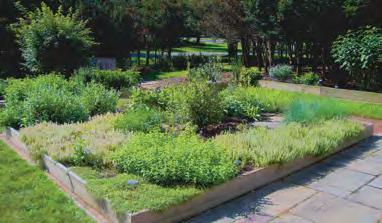
spring of 1996. Billie’s husband Bill actually built the skep holder in 2011 with the help of the garden staff at the Berks Campus, all six gardens and the lavender beds had the wood replaced around the beds.”
And next it was a herb garden on “the Albright College Campus as a public garden

format and location from Albright College to a high school campus, it was decided that “it was no longer feasible to continue the maintenance at the Albright Garden. The sundial at Albright in memory of Fuzzy Lord1 remains there due to the fact that the base, in which the bronze plaque is anchored, weighs 300 pounds. The College has hired a gardener to look after the Albright Herb Garden”(Pennsylvania Heartland Unit).
Not to be deterred, 2011 brought another herb garden to the unit one at Mouns Jones House in Morlatton Village. The garden coordinator for this unit knows no time for rest!
Conclusion

to the culinary herbs. It is in this garden that the unit placed a memorial sundial commemorating the work done by HSA member Priscilla Lord, formerly of the New England Unit.”
But times do change. When the annual Herbal Delights Symposium changed its
It is clear that this sampling of gardens designed, planted, watered, weeded and financially supported by units of The Herb Society of America are as varied as are the units themselves. They showcase herbs used by local historical and contemporary immigrants. They teach which herbs grow well in any particular area. They demonstrate the absolute commitment of The Society’s members to promoting the use and delight of herbs.
1. Among the many contributions made to The Society by Priscilla “fuzzy” Sawyer Lord, the one that most often comes to mind is her book, The History of The Herb Society of America 1933 – 1983
Literature Cited York Heritage Trust www.yorkheritage.org/page.asp?
id=5 (Accessed April 27, 2015)
Lois Sutton has been an active Society member for nearly 35 years, an active member of the South Texas and Pioneer Units. She has held various roles on the HSA board of directors including The Herbarist chair, symposia chair, education chair, vice-president and president (2008–2010). She was active in the Texas Master Gardener program for more than 25 years. A frequent lecturer, she also has been published in The Herbarist and The Houston Chronicle.
Prior to her retirement she was a director at The Methodist Hospital in Houston and served on the faculties of Baylor College of Medicine, the University of Houston and Lamar University. Reports of her research have appeared in medical and allied health journals.
52 53 The Herbarist issue 81 2015
Visit the Units’ Gardens!
Pennysylvania Heartland herb garden at Penn State
Small Herb Garden, PA Heartland Herb Society
The Madalene Hill Pharmacy Garden at Festival Hill
Henry Flowers
The Madalene Hill Pharmacy Garden is a unique garden that is on Festival Hill, the campus of the Round Top Festival [music] Institute in historic Round Top, Texas. The Institute, opened in 1976, has grown from the original 6-acres to over 200-acres. The Pharmacy Garden in particular is the product of the imagination, organization and loving labor of The Society’s own Madalene Hill. The Pioneer Unit, to which Madalene belonged, is very active in its maintenance and also in incorporating it into the educational mission of the Round Top Festival Institute through the Pioneer Unit Botany Study Group.
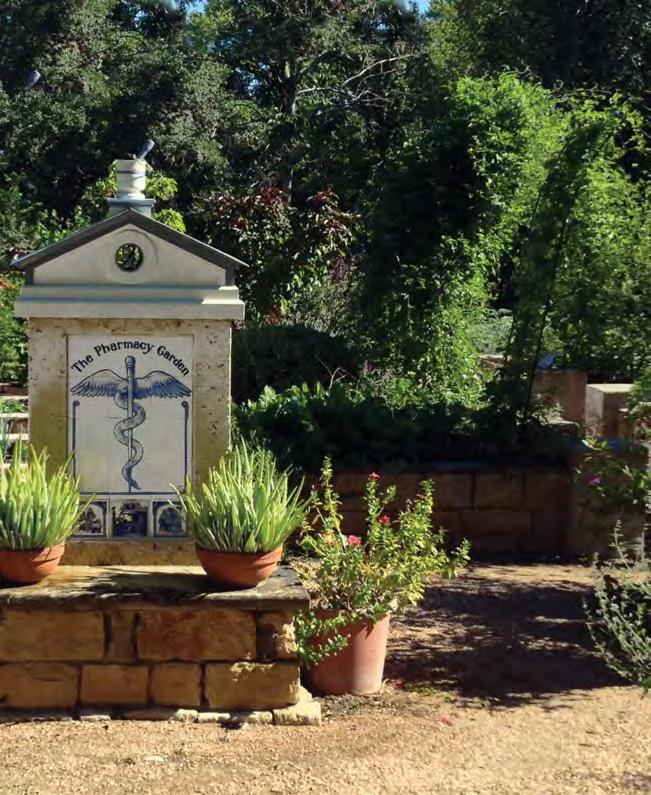
The Garden
Madalene Hill dreamed about creating a pharmacy garden of her own even before she came to live at Festival Hill. Madalene wanted to add this garden to others she had created at Festival Hill as a way of illustrating that the majority of the world’s population still relies on plant-based medications. Instead of grouping plants by their medicinal use, such as cardiovascular, carminative or antibiotic, she wanted the garden design to include plants by world region, to show how medicinal plants are important to all cultures. In 2001 the Madalene Hill Pharmacy Garden was finally completed, planted and dedicated. It has been a useful tool ever since for teaching about the variety and importance of medicinal plants.
Madalene Hill was president of The Herb Society of America from 19861988. She came to live at Festival Hill in 1994. She accompanied her daughter Gwen Barclay when Gwen was hired to manage the institute’s food services. Madalene always said that she came along as a full-time volunteer and in that capacity served the remainder of her life as Curator of the McAshan Herb and Festival Hill Gardens. There were very few planted gardens on the campus in 1994 and Madalene’s first order of business was to change that. The first area completed is known as the Susan McAshan Herb Gardens which has a backdrop of very creative stone work suggesting the ruins of medieval cloisters. It contains a wide array of herbs, many of which Madalene brought with her as large specimens.
Once these gardens were fully installed and there was little room left for planting, Madalene moved on to create many gardens. She needed to have space for her insatiable desire to grow more plants and to experiment. She sought to discover what would grow well in our central Texas climate with hot and humid summers and somewhat mild, but erratic, winters. Madalene chose what she deemed to be a good site for her envisioned pharmacy garden, at least it
would be once it was cleared, a task that required many hours of volunteer effort. It is at the north end of the garden’s greenhouse and surrounded by a pond on two other sides. The location was a gently sloping wooded area overgrown with native trees, shrubs, and vines, including much poison ivy.
With a potential site in mind, planning was started in 1998 to design the garden and to raise money for its implementation. This was just after Madalene’s 85th birthday. With a goal of completed fundraising by the millennial year of 2000, the effort was given the simple name of Project 2000 Pharmacy Garden. The goal was a bit optimistic, but not far off the mark as the garden was completed in 2001.
New Zealand, Africa, Asia, Southeast Asia, Middle East, South America, Central America, and Mexico. The final four L-shaped beds enclose the garden and are about three times as large as the inner beds. These four beds represent: India, China, North America, and the only non-geographically themed bed. That bed is filled on one side with herbal simples and on the other side with food plants used to promote good health.
She wanted the garden design to include plants by world region, to show how medicinal plants are important to all cultures.
The entrance to the garden features a caduceus column designed by ceramic artist and Festival Hill volunteer Pat Johnson. The front of the limestone column has blue and white tiles depicting a Texas-styled winged staff of Mercury wrapped by a rattlesnake. Tiles on the column’s back depict some major pharmaceutical plants including aloe, opium poppy and rosemary. Dr. Carl Driver, a professor of pharmacy at the University of Houston and garden consultant, donated Delft pharmacy tiles that depict scenes from ancient apothecary shops; these tiles are on the column’s side panels.
The design of the garden is fairly simple in its layout. The whole garden is a series of concrete raised beds with each bed representing a region of the world. There are eighteen beds in total with three each representing Europe and the Mediterranean regions, as many of the world’s best-known medicinal herbs originated in those areas. Fourteen of the raised beds run in four groups of three, horizontally across the garden with two near the front separated by the garden’s sign. One bed each represents: Australia/
At the outset of Project 2000 Pharmacy Garden Madalene recruited Tony Scanapico, a Pioneer Unit member, to help oversee the planning, funding, and implementation of the project. Once the plan was approved and fundraising efforts were underway, Tony worked with garden volunteers to clear the area for the garden. Local stone mason and concrete artist Jack Finke was hired to create all the concrete raised beds, which are stamped on the outside so that they appear to be stone blocks. Almost $36,000 was raised for the project with many hundreds of volunteer hours accrued in its implementation. The first presentation of the garden to the public was at the 2001 Herbal Forum, with more formal ribbon cutting later that year w ith Tony as Master of Ceremonies and American Botanical Council founder and director Mark Blumenthal as the keynote speaker.
This garden is definitely not static. The India bed looks fairly bleak in winter as that region of the world is subtropical. Most of the plants from that region
55 Issue 81 2015
The H E RBARIST 54
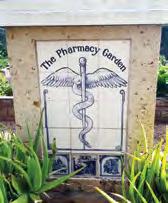
are either herbaceous or tender woody plants, many that have to be grown in pots and protected over the winter in the greenhouse. China, on the other hand, is mostly temperate and many of the plants in that garden remain fairly lush in appearance, even over the winter. This garden is now fourteen years old, and we have learned much about what plants will do well here, which ones won’t, and alas, much about those that do too well.
to direct Madalene in the selection of what they deemed to be the most important plants for inclusion. Many of those plants have succeeded and some have not, but I feel that this garden today is doing what Madalene wanted it to do show how plants, both common and fairly rare, continue to be an important part of life for a majority of the world’s population.


was necessary to accommodate a variety of levels of interest and ability.
Since that initial study of Indian medicinal plants the group has gone on to study the useful plants of Central America and Mexico as well as those of the American Southwest. Our last project has been a short study of plants that Pioneer Unit member Kay Scanapico incorporated into a program on herbs historically used for medicine in the Appalachian Mountains. Next we are heading further south to study the useful plants of South America, with our initial focus on the plants of Brazil. Such studies give us the chance not only to learn about plants, but to also learn about the culture, history, and cuisines of the various regions that we study.
The Pioneer Unit Botany Study Group
I came to work with Madalene and the Festival Hill gardens after the pharmacy garden’s completion in the summer of 2002. Madalene’s first order of business was to familiarize me with the gardens, putting the pharmacy garden at the top of the list. (Her second plan for me was to make sure that I became a member of The Herb Society of America and the Pioneer Unit as soon as possible.) Madalene was just beginning to experiment to see what plants would grow well in this garden and which ones would not. Because of the garden’s location all the plants would be in full sun for most of the day. This is fairly stressful on many plants in our climate. We investigated which plants would be potential representatives for each region, purchasing many plants and seeds from a variety of sources. Two friends in the field of pharmaceutical education at the University of Houston, Dr. Kenneth Euler and Dr. Carl Driver, and practicing Austin pharmacist and HSA member at large, Ann Wilson, helped in the planning stages
About five years ago I felt that it was time to start a new study group in the Pioneer Unit. This new Pioneer Unit Botany Study Group would have three aspects: to function as the main volunteer maintenance force for Madalene Hill’s pharmacy garden, to research plants in order to educate members of the group, and to enhance the garden as an educational and research tool by investigating possible new plants for inclusion in the garden.
Since the India bed is at the front of the garden and needed some “spiffing up” at the time, we began our research with the medicinal plants of that sub-continent. With such a wealth of interesting plants and history this turned out to be a great project. As leader of the group I did my own research and created an initial list of plants for study. An invitation to join the study group went to all Pioneer Unit members. We ask that study group members attend as many monthly meetings as possible (Apri l– February), work in the pharmacy garden to maintain the plant collection (mostly weeding, pruning, and planting as in any garden), and research and present a report on a selected plant every two or three meetings. Some members present a report at nearly every other meeting, but not all members are such highly dedicated researchers. It was decided that flexibility
recognized as safe” status; culinary usage; other uses; sources for the plant, seeds, or products; and a list of references. When a report is presented to the public beyond the botany study group, we always include HSA’s medical disclaimer and always stress the information in that disclaimer within the group as well.
at Round Top and will soon be presenting a program for the Pioneer Unit.
The Pioneer Unit Botany Study Group takes occasional field trips. We have twice gone to the Austin area to visit gardens,
For our monthly meeting days, we first work in the pharmacy garden to accomplish necessary seasonal tasks. The experience of many long-term members and the high group attendance enable us to finish the garden tasks within an hour or so. After a short break it’s time to meet in the garden if the weather is nice!
At a recent meeting we met outside under a nearby grape arbor and had four reports from three of our members. As we were still helping Kay with research on the plants for her program, we had reports on yarrow (Achillea millefolium), German chamomile (Matricaria recutita), lambsquarters (Chenopodium album) and horehound (Marrubium vulgare). All except lambsquarters grow in the pharmacy garden. Lambsquarter is not included because it grows wild here and is somewhat invasive. We sampled chamomile tea as well as horehound candy and tea. We all agreed that horehound candy is okay, but horehound tea is not pleasant. I find that such visuals and tastings help as memory stimuli; reports that include these sensory aspects are the easiest to remember.
We have created a form for members to use for their plant reports. That form includes the following topics: botanical name and its derivation; family name; common name(s); origin; history and folklore; growth habit; culture; propagation; parts used; time of harvest; medicinal usage; dosage (if known); GRAS “generally
In our research reports we try to include at least two or three references that are reputable books. With the increased information available on the internet we do use sources there as well, but always focus on sources known to provide reliable information. There have been occasional reports where the only information we could find is from the internet, but that is not usually the case. Members of the group are urged to take advantage of the library of plant reference books in my office at Festival Hill, many of which I inherited from Madalene’s own collection. It is rare that a public library would have such a selection of books, but groups who have access to botanical gardens that have libraries should definitely take advantage of those resources.
The members’ reports serve to enhance the knowledge of this study group. We usually publish at least one report in our unit’s monthly newsletter in order to share some of our work with more people. The group has prepared educational displays for presentation during the Herbal Forum
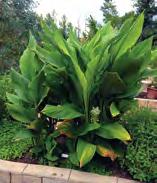
educational institutions such as the American B otanical Council, and businesses such as nurseries and retailers of plant-based materials like spice, herb and olive oil shops. We have visited restaurants that have something in common with what we are studying. Personally, I am really looking forward to going to a Brazilian restaurant during our upcoming study!
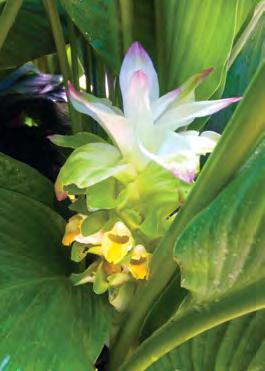
Since its creation the Madalene Hill Pharmacy Garden has proven itself to be a valuable teaching tool. It helps to educate those who come to Festival Hill
especially to visit the gardens, but also those who come to attend a variety of musical and educational events and just enjoy roaming around the gardens for a bit. The Pharmacy Garden continues to serve as a wonderfully interactive learning tool for the Pioneer Unit members in our botany study group who work to maintain the garden and who do research in order to keep further improving the garden.

Henry Flowers
was born in Texas and grew up in the Middle east. He graduated from Texas A&M University in 1991 with a Bachelor of Science degree in Horticulture and in 1993 with a Master of Agriculture degree in floriculture. Before graduation he began work with the Antique Rose emporium and continued working there for 12 years. He is currently the Garden Director at the Round Top festival Institute in Round Top, where with the help of many volunteers, he manages the gardens and collections of herbs. He is a member of The Herb Society of America, Pioneer Unit, and oversees the annual Herbal forum at Round Top, a joint production by the Pioneer Unit and the festival Institute. He was the 2009 recipient of The Herb Society of America’s Joanna McQuail Reed Award for the Artistic Use of Herbs.
56 57 The Herbarist issue 81 2015
Above: A closeup view of the flower. Left: A wide view of the turmeric in the India bed – Gotu Kola (Centella asiatica) on the left and Holy Basil (Ocimum tenuiflorum) on the right.
A variety of Delft tiles, depicting historical pharmacy scenes, were utilized in the creation of this beautiful and unique sign
The Madalene Hill Pharmacy Garden
Herb Gardening in Large Public Venues
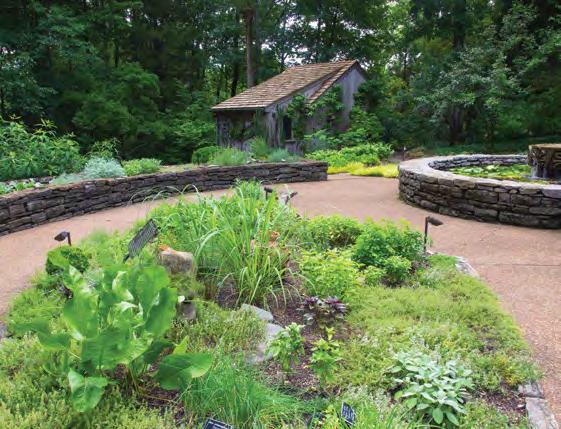
Several units of The Herb Society of America
m aintain gardens at what might be considered privileged sites: that is, they maintain gardens within highly visited parks, botanical gardens or nature centers Some of us have had the opportunity to visit these gardens during Society meetings Planning, installing and maintaining gardens at such sites offer unique challenges, as well as requiring the same basic programming as smaller gardens or sites We begin with the story of how a garden was started and the subsequent benefits to the unit and its members (garnered from their survey responses, we continue with the stories of other gardens you either know or will want to soon visit)
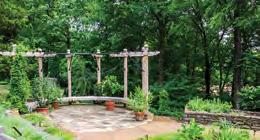
by our members and were frequently offered to interested outside groups.
The Centennial Herb Garden , located in a Metro park in downtown Nashville, and the Cheekwood Herb Study Garden have been maintained and cared for by the HSN for many years. It takes skill and knowledge to establish and maintain a relationship with any organization whose land is used for a garden.
for most members and has helped build an esprit de corps among the participants.
HSN has developed into a cohesive organization that has provided great pleasure a nd knowledge to its members. In the end, each of our gardens has provided joy, pain, toil, and a sense of accomplishment for members. People who walk through the gardens have a chance to learn, to experience, and to enjoy the smells and beauty of herbs in our southeastern region.
The Burr Garden at Cheekwood Botanical Garden and Fine Arts Center, Herb Society of Nashville
Sara Plummer and Pat Hampton
How is an herb garden started by an interest group? Who plans it, pays for it, maintains it? Where should it be located?
All of these questions had to be considered by the Herb Society of Nashville (HSN) in 1973 when one of the HSN founding members, Ruth Puryear, wanted to honor her mother Elizabeth Parkes Burr with a garden at Cheekwood Botanical Garden and Fine Arts Center in Nashville, Tennessee. The resulting Burr Garden was to become the first herb garden that HSN planned, maintained and partially funded. Early activities at the garden included tours for school children and teachers which included herbal refreshments. Periodically, the garden was used for classes in horticulture, cooking with herbs, and dyeing w ith herbs. These classes were con-ducted
The Herb Study Garden, installed in 1983, displays herbal plants that can be grown in Middle Tennessee. Expanded and redesigned in 200 0– 2001 with the guidance of landscape designers Holly and Osama Shimizu of Washington, D.C. and landscape architect Stephen Wells of Nashville, the plan includes eight distinct gardens. These include a yearly display garden plus areas that focus on culinary plants, herbs with blue flowers and gray/ silver foliage, herbs chosen for texture and fragrance, herbs used by Native Americans in middle Tennessee, herbs cultivated by early colonists, native shrubs and trees valued for medicinal or culinary use, as well as a relic garden featuring herbs typical of the Mediterranean region.
Hardscape features in the relic garden are columns and segments of limestone from the original Tennessee State Capitol. “These architectural elements capture Tennessee history with the spirit of ancient Greece and reflect Nashville’s past nickname as the Athens of the South.”
Now the Herb Society of Nashville puts on an annual Herb Day that has become part of our community outreach, with paid speakers, garden tours, and an herbal luncheon. The membership came up with creative ways to fund the garden by producing herbal cookbooks, herbal salts, and herb butter recipes as well as organizing herb plant sales. The shared focus of maintaining and funding the Cheekwood Garden Herb Study Garden has contributed to the growth of the HSN from the original fifteen founding members to the present membership of one hundred twenty.
A number of evaluations of the gardens pointed out that the difficulties, pleasures, needs, and, most of all, the flexibility of all shareholders must be considered. Changes have been made as we have grown; records of what has proven successful and unsuccessful have been kept and are communicated to the membership at our unit meetings (six per year) and through articles in the Herbary that is sent to all members every two months.
Perhaps the biggest challenge with the gardens has been their maintenance. In order to be an active member of HSN, each individual must work at both the garden at Cheekwood and at Centennial garden. Each member is also encouraged to participate in fund raisers and educational programs. This has proven to be a mixture of fun and work
The White River Gardens of the Indianapolis Zoo, Herb Society of Central Indiana
While much smaller than other gardens described later in this article, the herb garden of the Herb Society of Central Indiana offers an unusual style and location. There are eleven design gardens within the White River Gardens, one of which is maintained by this unit. The unit describes their garden, and its location with the following: “Partnering with the White River Gardens of the Indianapolis Zoo, we are the only garden club to design, plant and maintain a garden [on the site]. Since 2000, our volunteers primarily maintain the herbal plants and shrubs of a Sunken Herb Garden, while the zoo’s staff
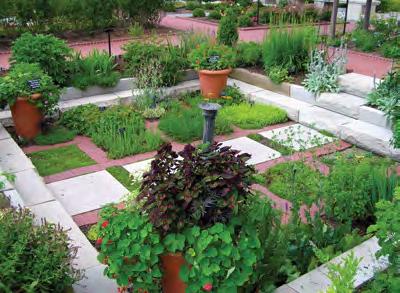
58 59 The Herbarist issue 81 2015
The sunken herb garden at the White River Gardens (Central Indiana Unit)
Another view of Cheekwood Botanical Garden
The Burr Garden at Cheekwood Botanical Garden in Nashville, Tennessee
The Herbarist Committee, eds,
gardeners provide support and maintain the non-herbal plants that are a part of the overall design circle. Our four design pots, one in each corner of the garden, are maintained by our unit’s members and feature HSA's Herb of the Year. These individual herb gardens in pots provide alternative design ideas for those with less garden space. We enjoy sharing our herb knowledge with zoo visitors, who can experience t he scents of lemon balm, mints or thymes that we offer. We provide a list (including botanical and common names) of our over 125 plants, and use temporary signage to point out featured blooms or plants.”
Fernwood Botanical Garden and Nature Reserve, Michiana Unit
Fernwood, originally a country estate of just over 12-acres, has grown to a landscape of 105-acres of cultivated and natural areas in the valley along the scenic St. Joseph River in southwestern Michigan. The Michiana Unit volunteers in the Stan Beikmann Herb and Sensory Garden on the site, designed by and named for former Fernwood director, Stan Beikmann. “The garden was designed to accommodate and teach visitors of all ages and capabilities, allowing visitors to sit in the center, a nd pass around herbs for smelling and tasting. The garden is used for educational purposes and is the most popular location for weddings at Fernwood.”

The illustration (inset below) shows the circular garden plan with separate beds in concentric rings for plants such as edible herbs for teas, salads, soups, and s easonings; vermifuge herbs for repelling insects or strewing as was done on medieval floors; herbs for dyeing, and other uses. The raised sensory beds along the back of the garden allow handicapped accessibility.
The centerpiece of the garden is a stone dovecote, modeled after one at Tryon Palace, a plantation in Virginia. It is surrounded by circular benches and tuteurs (trellises). The sensory garden along the back contains built-in planting boxes that a wheelchair can fit under and is framed with wattle fencing along the very back border.
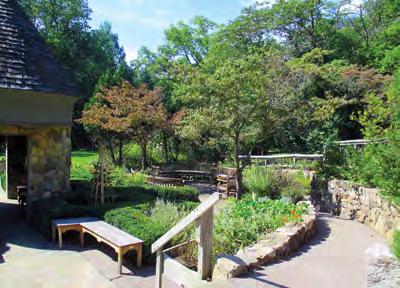

Boerner Botanical Gardens, Wisconsin Unit
Members joining The Herb Society of America in the early 1980s may have begun their herbal studies with the book, Boerner Botanical Gardens’ Herb Information Handbook, compiled by Ruth Wrensch. The Boerner Gardens of the book, located in Hales Corner, Wisconsin, are the very gardens that have been supported by the Wisconsin Unit since the garden’s beginning in 1974.
The unit makes an annual grant to the herb garden, which is used for plants and seeds. In addition, the unit sponsored two weeks of study at the National Herb Garden for the horticulturist in charge of the herb garden. The unit has provided funding for concrete planters, the recasting of an historic Boerner birdbath, signage for all of the herbs, and a decorative tree. Funding for the herb garden comes from an annual Herb Fair that is held at Boerner Botanical Garden each May.
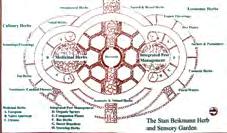
Route 16 and the Charles R iver which winds around it on three sides. Surrounding Mass Hort are woods, lawns, and a separate lawn with soccer fields. On the property are buildings from the former Cheney-Baltzell estate, and the build ings, greenhouses, and gardens of Mass Hort.
square feet. Areas are devoted to a fragrance garden, dooryard garden, edible garden, medieval garden, Native American garden, sage garden, dye garden, ecumenical garden, allium garden, rose garden, herbal perennial garden, and two groundcover gardens.
The herb garden is designed in the tradition of an old English garden. Each bed has a different theme including herbs used in a knot design, fragrant herbs, herbs for insect control, biblical herbs, culinary herbs, medicinal herbs, herbs for dyeing, and native herbs. One additional bed has a unique theme each year.
The unit gives classes on herbs and informative walks through the herb gardens, which are open to the public, April through November, sunrise to sunset.
The Teaching Herb Garden at the Massachusetts Horticultural Society, New England Unit
The Teaching Herb Garden of the New England Unit (NEU) is located on the grounds of the Massachusetts Horticultural Society, known as “Mass Hort”, at the Elm Bank Reservation, adjacent to
As of 2015, there are ten gardens on The Society’s 36-acre Massachusetts property. S ix are theme gardens created and maintained by Mass Hort. The Teaching Herb Garden is one of four NEU gardens on the north side of the property and was the first to be installed. (The other society gardens include those of the Rhododendron Society, the Hemerocallis Society, a nd the Noanett Garden Club.) Admission to herb garden comes with admission to Mass Hort.
Marie Stella, noted garden designer and landscape historian and NEU member, designed the garden. Mass Hort undertook the initial work of site preparation, including coordinating irrigation and utilities. Construction began in 2000. The New England Unit turned out and continued laboring for four years. The structures include benches and window boxes on the south side, and a pergola on the north side. An inkberry hedge connects the structures. The garden measures 8,000
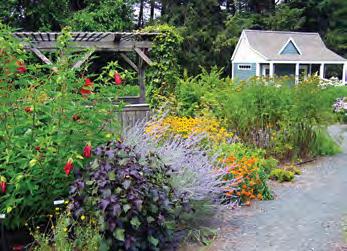
A spring plant sale is the chief way the unit raises funds for maintaining the Teaching Herb Garden. Members sell commercially grown plants, members’ plants, and plants that have multiplied in the Teaching Herb Garden. Additional ways of raising money include speakers and other programs, for which admission is charged. In 2014, the NEU received a one-time garden grant from the Andover Massachusetts unit that was disbanding.
Spring work in the garden begins with a clean-up day in late April. From then until early November, the garden requires, on average, approximately 15–20 volunteer hours per week. An energetic and knowledgeable chapter of the Master Gardeners of Massachusetts volunteers many hours at Mass Hort. The NEU unit has been the beneficiary of their time and skills, working together in the Teaching Garden. Virtually all of the Master Gardeners have enjoyed learning about herbs, and several have joined the New England Unit.
Cleveland Botanical Garden, the Western Reserve Herb Society
The herb garden of the Western Reserve Herb Society is located at the Cleveland Botanical Garden. The garden is open to the public through admission to the botanical garden and is subject to the general hours of the botanical garden.
Dedicated on September 5, 1969, the herb garden was designed by member, Elsetta Gilchrist Barnes, A.S.L.A., a practicing landscape architect, in consultation with other members of the unit. The Herman Losely and Son landscape firm from Perry, Ohio constructed the garden, installing the stonework, pavers and more than 3,500 plants in the spring and summer of 1969. Dr. Harry E. Ritchie kept a complete record of the construction of the garden with his camera. The collection of his slides, titled The Building of an Herb Garden, is now the property of The Herb Society of America.
61
Lef T A glimpse of the dovecote and accessible sensory gardens at fernwood Botanic Garden (Michiana Unit) A B O ve: The original plan for the Stan Beikmann Herb and Sensory Garden at the fernwood Botanical Garden.
Garlic installation at Boerner Botanical Gardens
Herb Gardening in Large Public Venues
Issue 81 2015
Container and Long Bed Garden, Boerner Botanical Gardens (Wisconsin Unit)
60 The H E RBARIST
A late-summer view of the dye garden at The Teaching Herb Garden, Mass Hort
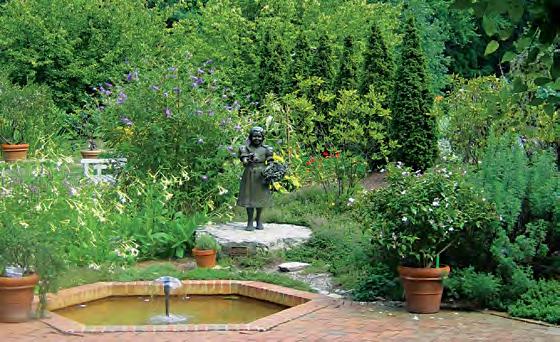

Mrs. Barnes provided the old millstones for the design. She also located the foundation stones from two old barns in Twinsburg, Ohio. The stones were hauled in a special tractor and lowered into place directly from the tractor. Other structures included in the garden are stone mounting blocks, a stone trough and an armillary mounted on an old upended roller stone.
The formal design of the garden currently includes nine sections: knot, terrace, trial and cutting, fragrance, dye, historic roses, culinary, medicinal, and edible plants. The knot is the centerpiece of the garden. Its design is based on medieval formal gardens, providing an intricate ribbon of gray and green plants winding around five millstones. The trial and cutting section is a less formal space, which provides plant materials used in Herb Fair products. The intent of the culinary area is to draw gardeners to discover new practices and plants for their own use. Collections of sages and lavenders highlight the fragrance gardens. Another noteworthy bed is the collection of antique roses featured on each side of the walk at the western edge of the garden. In 2012 this collection was designated by The Herb Society of America as a “Registered Collection of Historic Roses.”
The Western Reserve Herb Society herb garden is maintained by members who volunteer in the garden Tuesdays and Thursdays from the beginning of April until the end of October. Volunteer hours usually total about 2000 each season. The unit pays the botanical garden for the assistance of one of their horticulturists on workdays.
Inniswood Botanical Gardens and Nature Preserve, Central Ohio Unit
lnniswood Metro Gardens, in the Columbus, Ohio area, is affiliated with the Franklin Country Metro Parks. Included within the 121 park acres are streams and woodlands filled with wildflowers, wildlife, and beautifully landscaped flower bed and lawns. Members of the Central Ohio Unit and Metro Parks shared a vision of a public herb garden and with joint planning and fund raising the garden opened in 1987. The unit has provided perpetual maintenance of the herb garden since that time.
The thyme collection is the focus of the herb garden, and you will discover many thymes planted throughout the garden. This collection is a result of a taxonomic study by H.B. Flannery at Cornell University in 1982. Upon completion of her project, the Central Ohio Unit rescued the study collection from destruction and nurtured the plants until the herb garden was created. This collection continues to serve as a resource for identification and classification.
Herb gardens traditionally are laid out in formal geometric patterns and shapes. In contrast, this garden combines both formal and informal hardscapes and planting schemes. A variety of construction materials has been incorporated into the garden. Brick walks, stone retaining walls, and the winding flagstone path lead to arched pergolas, an herb cottage, and a gazebo.
As you walk through the herb garden, you will discover distinct “rooms”, each room displaying herbs grouped by their uses and other common features. Major rooms of the garden are the blue/gray garden, the thyme collection, the culinary garden, the knot garden, the medicinal garden, the
fragrance garden, the bee garden, the Bible garden, the west entrance garden, the thyme lawn garden, the herb cottage and display garden, and the main walkway garden. As an example of the herbal education offered within each bed, the west entrance garden gathers perennial and woody herbs together to illustrate how elegantly herbs enhance a landscape design.
The thyme collection is arranged along the curving walls of the blue/gray garden. The plants continue behind the thyme lawn garden with more than fifty different t hymes represented. The thyme lawn garden demonstrates that thymes have landscape value as ground covers. They can be found creeping along the edge of walks and covering the outer banks of the garden. A thyme seat in the medicinal gardens represents a traditional English garden feature.
The culinary garden has herbs for flavoring food ranging from leaves of a single plant such as basil to complex garnis. Edible flowers and plants used as natural sweeteners are also featured in the garden. A sundial by artist Andrew Kachilla is in the center of the bed among culinary herbs.
The bee garden is a combination of annual, biennial, and perennial herbs, as well as flowering vines, and shrubs that provide a variety of nectar for bees. The pottery bee skep, handcrafted by potters and unit members Jane and Joe Cooper, is a garden ornament that symbolizes the history of cultivating bees for crop pollination, wax, and honey production.
The Bible garden features plants mentioned in the book, Plants of the Bible by H.N. and A.I. Moldenke (1952). A sandstone watering trough, hand hewn in the 1880’s, was a gift from the F. F. Lyon family farm. A hops pergola arches over the stone path at the east end of this Bible garden. Many of the Bible garden plants are from the Mediterranean and are displayed in pots and brought into the greenhouse for the winter.
“Plants selected for use in the herb garden must meet several criteria. Herbs are defined as plants valued for their
potential, present, or historical use as flavoring agents; because they contain fragrance, dye or medicinal ingredients; and for economic purposes. Most of the plants displayed in the garden are historically documented herbs. However, in some cases a more ornamental variety has been substituted for the documented herb. All of the woody plants featured in the herb garden also
possess herbal uses.” The garden is open to the public daily from 7am to dark. The Central Ohio Unit meets quarterly to present free educational herb programs and workshops for the public. Tours of tile herb garden are available upon request. Additionally, “Sunny Sundays” garden tours, conducted by unit members, are held every Sunday from April to November.
Additional Resources
Boerner Botanical Gardens herb garden. Milwaukee County Parks: www.county.milwaukee.gov/HerbGarden10505.htm (Accessed May 29, 2015)
Cheekwood Botanical Garden and Museum of Art, Nashville TN: www.cheekwood.org (Accessed April 27, 2015)
Cleveland Botanical Garden. Western Reserve Unit Herb Garden: www.cbgarden.org/come-visit/collection-gardens/westernreserve-herb-society-garden.aspx (Accessed May 29, 2015)
fernwood Botanical Garden and Nature reserve, Niles, MI.: www.fernwoodbotanical.org/about.html (Accessed April 27, 2015)
Herb Society of Central Indiana: www.herbsocietyofcentralindiana.org/what-we-do/white-river-gardens (Accessed May 29, 2015)
Herb Society of Nashville: www.herbsocietynashville.org (Accessed May 29, 2015)
Inniswood Metro Gardens. Westerville Ohio: www.inniswood.org (Accessed May 29, 2015)
Massachusetts Horticultural Society: www.masshort.org (Accessed May 29, 2015)
New england Unit of the Herb Society of America: www.neuhsa.org (Accessed May 29, 2015)
Western Reserve Unit. Cleveland, Ohio: www.westernreserveherbsociety.org (Accessed May 29, 2015)

62 The Herbarist
Lef T Garden entrance at Inniswood Botanical Gardens A B O ve: A view of the fragrance garden from the herb cottage, Inniswood Botanical Garden
A summer collection of basils, Inniswood Botanical Garden (Central Ohio Unit) P H OTO Lois Sutton
63 Issue 81 2015
Herb Gardening in Large Public Venues

Garden Planning
The 40-acre Gantz family farm, including a brick farmhouse built in the 1840s, was donated to Grove City, Ohio, for use as park land. The park is now an arboretum that includes tennis courts, a gazebo, picnic shelters, a preschool in the remodeled barn, and hiking trails through the woods. The gardens in the park were conceived from the beginning as herb gardens at the urging of a city councilman who was an avid herb grower. Planning for the Gardens at Gantz Farm began in summer 1988, and we dedicated the gardens in July 1991.
As planning continued over those three years it became obvious that we were creating not only a place, but also the need for an educational program. I became director of gardens, with the charge of designing the gardens, and joined another educator to develop programming.
It was relatively easy to plan the garden as three major areas. The Garden of Yesterday is a recreated kitchen garden of the era when the house was built, including heirloom vegetables, old fruit varieties,
and herbs known to be grown in central Ohio in the 1840s. The Garden of Today includes culinary, fragrance, dye, medicinal, cutting, and knot gardens, as do many today. The Garden of Tomorrow is an enclosed garden with contemporary fences, a deck, a patio, many large planter boxes, and an overhead trellis, all to demonstrate container gardening with herbs and ways you might use herbs to landscape your home.
Local conditions drove plant choice. Grove City is in USDA plant hardiness zone 6a. Some plants that are not winter hardy here were eliminated. Other plants that could be container grown and over-wintered in the greenhouse are included. Many plants that are perennial farther south are grown as annuals. A small pond allowed us to include water plants. Woody herbal plants were incorporated throughout the gardens as part of the design rather than being grouped with any botanical family. We decided early in the planning that signage was critical to horticultural education within the garden. If you see a plant in a public garden and don’t know
what it is, you will have difficulty finding it to plant in your garden. We label all plants with common name, botanical name and family name. Another common problem in herb gardens is that plants are grouped together without an explanation that they are, for example, all dye plants or all culinary plants. All our garden areas include large signs describing the reasons plants are grouped together. An example is the Medicinal Garden sign which explains that some plants we grow contain compounds that have medicinal use, while many more were considered to have medicinal use in the past but now are no longer used. We recognized an additional teaching opportunity. A large area of the Garden of Today is one that is less often found in public herb gardens; a taxonomic garden. The idea for this garden grew out of my interests in plant taxonomy and botanical Latin. Plants are grouped by botanical family. Families are represented in relation to the numbers of plants in that family that have herbal use. Monocots are grouped together as are dicots.
Teaching Plant Taxonomy in a Public Garden
The planning committee saw this taxonomic garden as an outdoor botany lab to be used by school groups and others. Grove City is a Columbus suburb with hundreds of high schools and ten colleges and universities within 25 miles.
Visitors can see the likenesses and differences within and between botanical families. Another idea was to make this a resource to teach the meanings of Latin botanical names by creating educational materials listing plants with name definitions, particularly of specific epithets.
The taxonomic garden plant list includes 151 species in thirty-eight botanical families. The largest family is the mint family, the Lamiaceae, with forty-five different species represented. Next largest is the Asteraceae (formerly the Compositae), with sixteen species (Panero 2002), followed by the Apiaceae (formerly the Umbelliferae), with ten different species. Seventeen families are represented by one plant only. Plant choices within the Lamiaceae are guided by what is
easier to grow here. There are many Salvias and few Lavandulas.
Some of our educational materials include only the plants in the taxonomic garden listed together by family. However, an expanded list that includes the 350 plant species in the entire gardens at Gantz Farm can make study of all plants in a family a kind of scavenger hunt that teaches the ability to observe common characteristics within a family.
Teaching materials for students with no botanical background describe what they should look for and provide illustrations. These guides emphasize that flower anatomy is the major tool of plant classification. Students might consider a visit at different
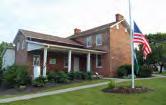
times during the growing season to see even just the few plants illustrated here. The images accompanying this article show examples of different things visitors might see and study.
Materials about the Asteraceae family describe disk and ray flowers and how those form the inflorescence that is typical of most flowers of this family. The distinction is made between those family members that have a daisy-type inflorescence, with both disk and ray flowers, and those family members that have a thistle-type inflorescence with tubular disk flowers seated on a receptacle. These terms are explained and defined.
Lamiaceae, the mint family, is the largest represented in the garden because it includes the most plants with herbal use. The tubular flowers with two lips are easy to describe and to illustrate. Just one genus, Salvia, is represented by ten different species. Students are encouraged to notice both t he commonalities and the differences of flower forms among the Salvias. The following a re genera from the mint family in the taxonomic garden: Agastache (giant hys-
sop), Elsholtzia (mint shrub), Hyssopus (hyssop), Lavandula (lavender) Melissa (balm), Mentha (mint), Monarda (beebalm), Nepeta (catmint), Ocimum (basil), Origanum (oregano), Perilla (perilla), Perovskia (Russian sage), Phlomis (Jerusalem sage), Poliomintha (Mexican bush sage), Pycnanthemum (mountain mint), Rosmarinus (rosemary), Satureja (savory), Scuellaria (skullcap), Stachys (betony), Teucrium (germander), Thymus (thyme). All have the same basic anatomical characteristics and all help to teach the basics of plant classification.
Keeping the Taxonomic Garden Up-to-date
Plant taxonomy is in constant flux. Authorities continually review and debate (Judd et al. 2007). That doesn’t mean you can’t go with the best thinking at the time and label plants as accurately as you are able. Basic principles can still be taught even though we may sometimes be a bit behind with plant labels.
During installation of the garden twenty-four years ago we labeled northern bayberry with its historic name, Myrica pensylvanica Mirb Last year I wrote about woody herbal plants in The Herbarist. The name I gave this plant in 2013 is Morella pensylvanica (Mirb.) Kartesz, which is the name now accepted by the United States Department of Agriculture Agricultural Research Service (USDA-ARS). This is the authority HSA uses for plant nomenclature (USDA ARS-GRIN [Germplasm Resource Information Network]).
You may know black cohosh as Cimicifuga racemosa. The accepted name is now Actaea racemosa var racemosa Even family names can change. Many of us had a hard time accepting the name changes resulting from converting all family names to end with ‘aceae’. Other family name changes occur as well. The Angiosperm Phylogeny Group published a reclassification of the family Asclepiadaceae to family Apocynaceae in 2009 (Angiosperm). This is the family that includes milkweeds. The ICN now says that both Compsitae and Asteraceae are accepted names for the same family. I have used Asteraceae because it is used by USDA
64 65 The Herbarist issue 81 2015
Original Distribution of Taxonomic Garden Plants at Gantz Farm Botanical o mmon enera in Family amily G arden Poacaea Grass 1 Alliaceae O nion 7 Asparagaceae A sparagus 1 Iridaceae Iris 2 Acoraceae Acorus 1 Aquifoliaceae Holly 1 Ranunculaceae Buttercup 4 L auraceae aurel 1 Aristolochiaceae Birthwort 1 B erberidaceae Barberry 1 Papaveraceae Poppy 2 Resedaceae Mignonette 1 Brassicaceae Mustard 3 Malvaceae otton 1 Buxaceae B oxwood 1 Linaceae Flax 1 Tropaeolaceae Nasturtium 1 Geraniaceae Geranium 6 Rutaceae itrus 1 Polygonaceae Buckwheat 1 Chenopodiaceae Goosefoot 2 Amar anthaceae Amaranth 3 C aryophyllaceae Pink 2 S olanaceae Nightshade 5 Boraginaceae B orage 3 Ap ocynaceae Milkweed 2 Verbenaceae Verbena 3 L amiaceae Mint 45 Plantaginaceae Plantain 2 S crophulariaceae Figwort 1 Pedialiaceae Sesame 1 Fabaceae B ean & Pea 5 Rosaceae Rose 5 Myrtaceae Myrtle 4 Apiaceae Parsley 10 Rubiaceae andalwood 3 Valerianaceae Valerian 1 A steraceae Daisy & Thistle 16
Barbara J. Williams
The Gantz family farmhouse
ARS-GRIN and is becoming widely used.
Note that while botanical names are italicized in text, it is usual not to italicize family names and those above family in the botanical
Literature cited
naming hierarchy. Abbreviations such as var. and sp. within botanical names also are not italicized. Also notice that when “x” is used in a name to indicate the plant is a cross
between plant-parents, it should be typeset as a multiplication sign (×), not an uppercase or lowercase x. There is no space between the multiplication sign and the specific epithet.
Angiosperm Phylogeny Group (2009), “An update of the Angiosperm Phylogeny Group classification for the orders and families of flowering plants: APG III”, Botanical Journal of the Linnean Society 161 (2): 105–121, doi:10.1111/j.1095-8339.2009.00996.x.
ICN. International Code of Nomenclature for algae, fungi and plants: www.iapt-taxon.org/nomen/main.php
ICNCP. International Code of Nomenclature for Cultivated Plants: www.ishs.org/sci/icracpco.htm
Judd, W.S., C.S. Campbell, e A. Kellogg, P.f Stevens, M.J. Donoghue. 2007. Plant Systematics: A Phylogenetic Approach, 3rd edition. Sunderland, MA: Sinauer Associates.
Panero, J.L. and v A. funk. 2002. Toward a phylogenetic subfamilial classification for the Compositae (Asteraceae). Proc. Biol. Soc. Wash. 115: 909 – 922.
The Plant List database: www.theplantlist.org
USDA ARS-GRIN. United State Department of Agriculture, Agricultural Research Service. Germplasm Resource Information Network: www.arsgrin.gov/cgi-bin/npgs/html/taxgenform.pl.
USDA NRCS. United States Department of Agriculture, Natural Resources Conservation Service. Plants database: www.plants.usda.gov
Educational Program Teaching Points
Importance of Flower Anatomy
Materials for students emphasize that flower anatomy is the main tool of plant classification. They explain that the Asteraceae family is divided into four subfamilies. One of these contains about 70% of the family. Those plants have daisy-type flowers, and

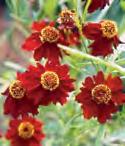
are represented here by Echinacea purpurea, purple coneflower and Coreopsis tinctoria, dyer’s tickseed. About 11% have thistletype flowers such as cardoon, Cynara cardunculus and safflower, Carthamus tinctoria.

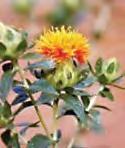
Credit: Barbara J. Williams
Credit: Barbara J. Williams
Meaning of Botanical Name
Teaching materials include information about the meanings of botanical names and relates that information to plants visitors can see. Both of these plants bloom at about the same time in spring making this visual comparison possible. Yellow flag, Iris pseudacorus (left) can be grown in water and in moist soil as can sweet flag, Acorus calamus (right). Note the word acorus in both botanical names. The word acorus means ‘pupil’ in Greek and refers to its past use as a treatment for inflammation of the eye. The word pseudacorus means false acorus. While the foliage looks similar, flower anatomy is completely different and these plants are not in the same botanical family.
Credit: Barbara J. Williams

2,000
Credit: Rüdiger Kratz
Descriptive Terms
Students learn important terms such as inflorescence which is a group or cluster of individual flowers arranged on a stem. They should notice how these different members of the genus Monarda have flowers arranged differently. They are (left to right) Monarda
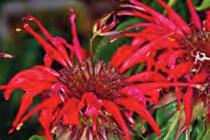
Credit: Hedwig Storch
The International Code of Botanical Nomenclature (ICBN) was renamed at the International Botanical Congress in 2011 and is now the International Code of Nomenclature for algae, fungi and plants, or simply the ICN. It is the set of rules and recommendations dealing with formal botanical names (ICN).
Detail in Floral Anatomy
Credit: Barbara J. Williams
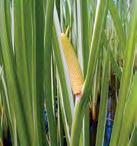
600 × 800
Credit: J.f Gaffard
punctata, M. didyma, and M. citriodora. The showy pink parts of the M. punctata inflorescence are bracts. The flowers are in the center, the yellow parts with burgundy spots.
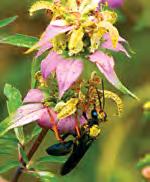
Monarda
http://en.wikipedia.org/wiki/file: Monarda_pollination_2012.jpg
1,200 × 1,355 pixels, (1.73 MB)
Credit: Wikipedia
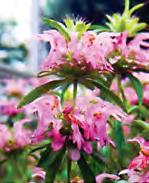
Credit: Barbara J. Williams
The International Code of Nomenclature for Cultivated Plants (ICNCP, Cultivated Plant Code) regulates the names of cultigens (plants whose origin or selection is primarily due to intentional human activity). For the most part, these are plants with names in the classification categories of cultivars (ICNCP).
Here is another demonstration of the importance of flower anatomy in classifying plants. Students are encouraged to closely examine these plants. Flowers of the mint family have an upper and a lower lip. These members of the just one genus, Salvia,
show there can be great variety on that theme. Salvia argentea, S. coccinea, S. elegans
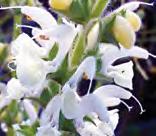
Salvia argentea, silver sage http://commons.wikimedia.org/wiki/ file:Salvia_argentea_14May2009_ f owersCloseup_ CampoCalatrava.jpg
3,200 × 2,400 pixels (1.36 MB)
Credit: Javier Martin

Salvia coccinea, scarlet sage http://commons.wikimedia.org/wiki/f le:Texas_ sage_%281570119815%29.jpg
1,201 × 1,201 pixels (532 KB)
Credit: Carl e Lewis

Salvia elegans, pineapple sage http://commons.wikimedia.org/wiki/f le:Salvia_elegans.jpg 2,300 × 1,533 pixels (1.76 MB)
Credit: eric Hunt
Salvia farinacea, mealycup sage
66 67 The Herbarist issue 81 2015
punctata, horsemint
Monarda citriodora, lemon bergamot 524 x 658 pixels (1010 KB)
Echinacea purpurea, purple coneflower 525 x 780 pixels (1.18 MB)
Coreopsis tinctoria, dyer’s tickseed 776 x 524 pixels (1.16 MB)
Cynara cardunculus, cardoon 510 x 663 pixels (990.6 KB)
Carthmus tinctoria, safflower 362 x 471 pixels (499.5 KB)
Iris pseudacorus, yellow flag: http://commons. wikimedia.org/wiki/file:Iris-pseudocorus_0039.jpg
× 3,008 pixels (2.45 MB)
Acorus calamus, sweet flag: http://commons. wikimedia.org/wiki/f le:Acorus_calamus1.jpg
pixels (55 KB)
Monarda didyma ‘Cambridge Scarlet’, scarlet beebalm http://commons.wikimedia.org/wiki/file:Goldmelisse_7148.jpg
5,184 × 3,456 pixels, (5.01 MB)
(left to right, above) S. farinacea, S. leucantha, and S. sclarea (left to right, below)
Detail in Floral Anatomy cont'd…
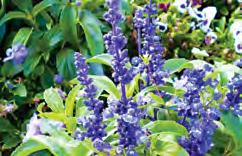
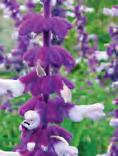
Salvia leucantha, Mexican bush sage
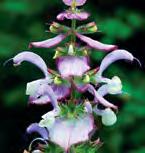
Salvia sclarea, clary sage
3,072 × 2,304 pixels (1.72 MB)
Credit: Rob Hille
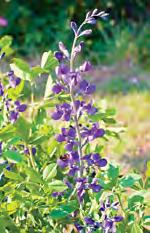
Baptisia australis, false indigo http://commons.wikimedia.org/wiki/f le:Baptisia_ australis_-_f eurs-2.jpg
3,168 × 4,435 pixels (9.63 MB)
Credit: Denis Prévôt
http://commons.wikimedia.org/wiki/ f le:Salvia_leucantha_closeup.jpg
2,448 × 3,264 pixels (1.79 MB)
credit: Michael
Flower Similarities within a Family
http://commons.wikimedia.org/wiki/ f le:Salvia_sclarea_infloresc.jpg
3,058 × 2,592 pixels (420 KB)
Credit: Pancrat
Many students may have seen bean plants in flower. They see a flower picture and are encouraged to look for the similarities between these members of the Fabaceae, the bean family, represented by (below, from left) Baptisia australis, false indigo; Galega officinalis, goat’s rue; (below, from left) Genista tinctoria, dyer’s broom; and Glycyrrhiza glabra, licorice.
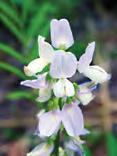
Galega officinalis, goat’s rue http://commons.wikimedia.org/wiki/ f le:Galega_officinalis_flos.jpg
1,704 × 2,272 pixels (996 KB)
Credit: Nicola Cocchia
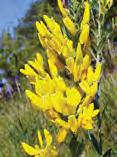
Genista tinctoria, dyer’s broom http://commons.wikimedia.org/wiki/ file:Genista_tinctoria_250807.jpg max size = 4.5” x 6.7”
Credit: Bernd Haynold

Glycyrrhiza glabra, licorice http://commons.wikimedia.org/wiki/ file:01728_-_Glycyrrhiza_glabra_%28De utsches_S%C3%BC%C3%9fholz%29.JPG
2,048 × 1,536 pixels (946 KB)
Credit: Tubifex
Intrigued? You may want to investigate The Plant List
This source is particularly helpful in learning which names have been accepted and which are still under discussion. Previous names are often listed as synonyms that are no longer accepted. You can learn which group is reviewing names.
Single Plants Representing a Family
Some families are represented in the garden by only one species. The Rutaceae family is the citrus family. It’s very hard for a nonexpert to see that rue, Ruta graveolens (left), might be related to an orange tree. The Pedialiaceae family is represented by sesame, Sesamum indicum, which is just a fun plant for people to see. The seed pods hold stacks of seeds.

Ruta graveolens, rue 782 x 526 pixels (1.17 MB)
Credit: Barbara J. Williams
Herbal Leaves
Sometimes leaves are just plain neat to look at even if teaching is focused on flowers. The wooly leaves of Salvia argentea, silver sage, lose much of their pubescence when they change from vegetative to flowering physiology. The pubescent leaves of lady’s mantle, Alchemilla mollis cause water to form beads.
Plant Variations
This is a good place to explain to students that a sport is a part of a plant that is different in form from the rest of the plant. Sports with desirable characteristics are often propagated vegetatively to form new cultivars that retain the characteristics of the new morphology. The Gallica roses are the oldest of the old garden roses, having been grown by the Greeks and Romans. Rosa gallica var. officinalis, the apothecary’s rose, is on the left. Rosa mundi, on the right, is a sport or genetic mutation of apothecary’s rose and is Rosa gallica var. offficinalis ‘Versicolor’. It has been known since the 12th century.

Salvia argentea, silver sage
757 482 pixels (1.04 MB)
Credit: Barbara J Williams

Rosa gallica var. officinalis, apothecary rose http://commons.wikimedia.org/wiki/f le:Rosa_gallica_ officinalis0.jpg
640 × 480 pixels (37 KB)
Credit: Kurt Stüber
The Plant List is a working list of all known plant species. Version 1.1, released in September 2013, aims to be comprehensive for species of Vascular plants (flowering plants, conifers, ferns and their allies) and of Bryophytes (mosses and liverworts). It does not include algae or fungi. Version 1.1 contains 1,293,685 scientific plant names of which 350,699 are accepted species names. It includes no vernacular or common plant names.
Collaboration between the Missouri Botanical Garden and Royal Botanic Gardens, Kew and enabled the creation of The Plant List by combining multiple checklist datasets held by these institutions and other collaborators.

Credit:
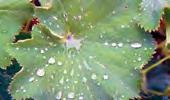
lady’s mantle 776 x 524 pixels (1.16 MB)
Credit: Barbara J. Williams

Rosa gallica var. officinalis versicolor’, rosa mundi http://commons.wikimedia.org/wiki/f le:Rose-_Rosa_Mundi.JPG 1,280 × 960 pixels (347 KB)
Credit: Schnurri
The Plant List provides the accepted Latin name for most species, with links to all synonyms by which that species has been known. It also includes unresolved names for which the contributing data sources did not contain sufficient evidence to decide whether they were accepted or synonyms, or where there were conflicting opinions that could not be readily resolved.
69 Issue 81 2015 68 The H E RBARIST
Salvia farinacea, Mealycup Salvia http://commons.wikimedia.org/wiki/file:Salvia_farinacea_0.2_R.jpg
Sesamum indicum, sesame 578 x 527 pixels (892.4 KB)
Barbara J. Williams
visit:www.theplantlist.org
Alchemilla mollis,
Plants Grown for Fragrance and Form
The Pelargoniums are grown for their fragrant foliage, which differs greatly in appearance and scent between species and cultivars. Here are Pelargonium crispum, lemon-scented geranium with tiny crinkled leaves, P. tomentosum, peppermint-scented geranium with velvety foliage, and P. ‘Snowflake’, variegated rose-scented geranium with white markings. Students can feel and smell the foliage as they learn that plant parts other than flowers aid identification and classification.

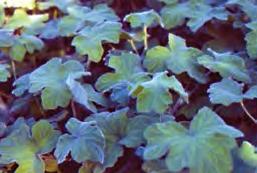
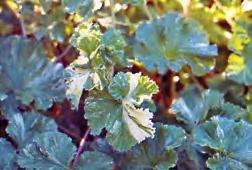

BarbaraJ. Williams
is a member at large and life member in the Great Lakes District of The Herb Society of America, a winner of the Nancy Putnam Howard Award for e xcellence in Horticulture, and a retired public garden director. She drew more than 100 botanical drawings that are included in Manual of Herbaceaous Ornamental Plants by Steven Still. In 1992 she received the Landscape Design Award for the best new facility in a public park in Ohio from the Ohio environmental Beautification Awards Program for her herb garden design which includes the taxonomic gardena described in this article. She has served as HSA secretary and communications committee chair, supervising publications and the website. Barbara has chaired several Great Lakes Herb Symposia and has been chair of the research grants committee and the promising plants committee. She has written for The Herbarist previously.
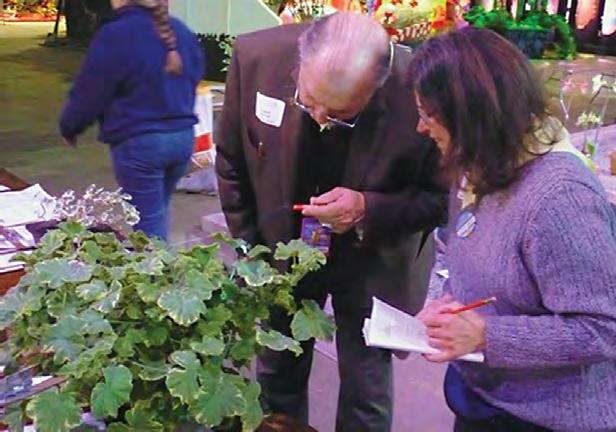
Get Ready, Get Set, Show! GoinG For The Blue AT A Flower Show
Elizabeth Kennel
he Philadelphia Flower Show is beginning in late February and you would like to enter one of your herb plants or a cut herb specimen in the show How to do it? You could stroll around your house or greenhouse and pick out the best-looking plant you see . Or, you could have planned ahead and prepared a plant in anticipation of the show . Pre-planning is the option that will likely bring the best result
70 71 The Herbarist issue 81 2015
Pelargonium crispum, lemon-scented geranium 776 X 522 pixels (1.16 MB) Credit: Barbara J. Williams
Pelargonium tomentosum, peppermint-scented geranium 767 x 526 pixels (1.15 MB)
Credit: Barbara J. Williams
Pelargonium ‘Snowflake’, variegated rose-scented geranium 776 x 524 pixels (1.15 MB)
Credit: Barbara J. Williams
get
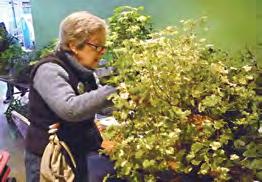
Get Ready
“The section of the country, time of the year, size of the show, or special studies/ interests of participating groups will shape the schedule” (Howard & Spencer, p. 4).
Each flower show has its own rules, schedules, and class requirements that are published well in advance of the show’s opening day. An herb plant might be entered in a horticulture class as a container-grown specimen, as one of several plants in a collection, as part of an arrangement in a window box, or as an accessory in a larger exhibit. Some shows also feature cut specimens, and these must be properly pre-treated to look their best. It is very important to understand the requirements of the class you wish to enter.
Some possible classes involve containergrown herbs. Container-grown plants are usually required to have been in the possession of the exhibitor for a designated amount of time and to have been potted for a minimum length of time before the show.
Classes for container-grown herbs might include culinary, medicinal, aromatic, or other uses (such as dye or industrial); a genus (such as Rosmarinus); a collection (multiple species of a genus or multiple cultivars of a species); strawberry jar; theme garden in a container (such as a dish garden); hanging basket; topiary; espalier; trained plant on a stuffed form; window box; or living wreath. The class might specify that the herb be grown in a container of a specific size, color, or material.
If a show, such as a Garden Club of America or National Garden Clubs show, provides


classes for cut specimens, the possible classes might include culinary, medicinal, aromatic, dye, genus, collection, family, tussie-mussie, or dried wreath.
Garden exhibits are designed according to a theme or topic, such as children’s gardens, dye gardens, colonial gardens, Native American gardens, or medicinal gardens.
Classes that judge herbs for flavor or fragrance provide a special challenge for organizers and judges since most shows do not allow exhibits to be touched after they have been entered. If such a class is created, the rules and guidelines must be explicitly spelled out for exhibitors and judges. The judges must have the necessary expertise to evaluate those herbal qualities.A lways know the show’s general rules and schedules. Be familiar with the rules of the class you wish to enter.
Exhibitors of container plants should use a clean container, free of salt build-up, which conforms to the show’s measurement guidelines and should use appropriate top dressing. You must verify that t he botanical nomenclature is correct and that the information accompanying the exhibit is complete and correct. As you have grown your plant, you have paid special attention to giving it sufficient feeding and light to produce a well-grown plant with lush foliage and/or flowers (especially if flowers are a feature of the class you are entering). Most plants will benefit from being cut back to encourage additional growth and prevent legginess, particularly if you are trying to grow your plant under lights or in a sunny window.
You have pruned dead or fading leaves and flowers and made sure there are no unsightly stem ends visible. You have kept your plant free of insects and disease and grown it in a clean pot that meets the class requirements regarding size and material. Repot it before the show if your pot is less than clean. Top dress, if desired, with a dressing allowed under the show and class rules.
This is the way Howard and Spencer (p. 7) suggest that you prepare a cut herb entry. On the day before the show cut the herbs in the morning or late afternoon, labeling each specimen as it is cut to avoid confusion later and cutting more than you think you will need. Cut stems as long as possible. Then strip the lower leaves, remove all faded or undesirable leaves, buds, or branches close to node, stem, or trunk, and stand in a bucket of tepid water up to the lower leaves. If permitted, add Floralife® to the bucket for hardening off or to the Oasis® soak for arrangements. Leave the cut stems in a cool, shady, protected area. On the day of the show, use only specimens in prime condition and make sure there are no leaves below the water line.
It is important to submit the correct identification for every entry. Every plant has its own individual, scientific/botanical name comprised of genus and specific epithet in Latin and the name, usually a bbreviated, of the botanist who first described the plant. This botanical name is recognized worldwide and, unlike a common name, identifies the plant exactly.
In addition to the genus and specific epithet (i.e., Rosmarinus officinalis or Salvia officinalis), the variety (var.), subspecies (subsp.), or cultivar name should also be listed if they are part of your entry’s botanical name. Some cultivars of uncertain parentage are properly identified only by genus and cultivar name and do not include a specific epithet; (e.g., Salvia ‘Anthony Parker’). If the class requires more than one plant per entry, such as a dish garden, a list and numbered key or chart is helpful, and many shows require one to show the placement a nd identity of the plants. Common or popular names cannot be used alone. Unlike botanical names, they can be different in different parts of the world. They are added only if the show’s rules require or permit them.
You will want your plant to look as nearly perfect as possible. Remove dead or fading flowers or leaves and any withering or dead ends of stems. Use razor-sharp pointed scissors to cut as close as possible to nodes, stems, or trunks. Do the pruning early enough that the plant has time to heal and shows no evidence of cut leaves or stem tips. It is best not to use synthetic or shiny material to support a plant as it may be a distraction if it shows.
Get Set
Make sure you have the appropriate paperwork for entering the show and the correct botanical name for your plant. Most shows provide help with nomenclature if you are unsure of the name. Be optimistic and upbeat about entering.
Everyone else is just as nervous as you are and just as hopeful that their plants will show well.
It is important to know what judges will look for. They will be familiar with the requirements of the class you have entered and will notice if you have not met them. This includes the proper nomenclature and labeling.
They will assure that a collection includes the correct number and style of plants. This might include three or more separate species or cultivars of the same genus planted in the same container, or five or more separate species or cultivars of the same genus as cut specimens. If the entry is based on a particular theme and requires several varieties of a family, genus, or species, or a mixture of them, the choice of plants should reflect the theme’s intent and work together coherently.
In gardens designed according to a theme or topic, such as a children’s garden, the judges will look for an artistic design highlighting form, texture, unity, balance, proportion, and scale; whether the plant material is suitable to the topic; how well the plants are conditioned and demonstrate cultural perfection; whether special features, such as accessories, are appropriate or relevant; if the labeling is complete, understandable, and meets the class requirements.
They will look to see that every plant in any class is in excellent condition and demonstrates cultural perfection overall, that it is well-grown, vigorous, and compact (not leggy), with evidence of new growth; that the form, shape, and symmetry are ideal;
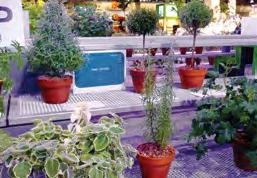
that each plant is healthy and has reached an ideal maturity for its particular genus, species, cultivar, or variety; that is, that the plant looks the way a mature specimen of that type should look.
The judges will take into account the difficulty of cultivating a particular plant. Some container-grown plants demand daily manicuring for ultimate perfection, particularly small-leaved scented geraniums, curry plant (Helichrysum italicum) and fine-leaved lavenders. Low-growing shrubs such as germander, sage, thyme, and lavender cotton (Santolina), require infinite patience and constant attention to develop exhibition quality (Howard & Spencer, p. 8). This is particularly true for plants entered in formal classes (standards, topiaries, and wreaths).
If you have entered a class that requires your plant to be flowering or if your entry happens to be flowering at the time, the judges will look for numerous flowers in prime condition with clear and well-defined color and, in every class, for full foliage in prime condition.
Judges will expect the plant to be carefully groomed as described above. They w ill notice if there are cut stem ends or inappropriate supports showing.
Judges will notice if an entry’s botanical identification is incorrect. If a class contains multiple plants in a single container it may also require a list and numbered key or even a chart showing the location of each plant and its name.

72 73 The Herbarist issue 81 2015
Judges will expect the presentation of the plant/plants to demonstrate suitability, ready, get Set, Show!
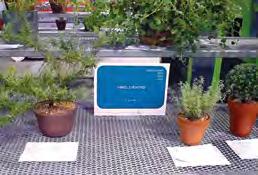

originality, and proper training, including proportion and placement appropriate for the container and attention to fundamental details as described above. All of this will reflect the exhibitor’s herbal horticultural knowledge, experience and expertise. In acknowledgment of its rarity, the judges may give preference to a particularly fine herbal plant not frequently exhibited because of geography, difficulty of culture, or newness of introduction. However, “cultural perfection is always the most heavily weighted factor...; a perfectly grown and presented plant, no matter how common, will always do better than a poorly grown rare or mature plant” (Waterman, p. 2).
Most flower shows use a point system adapted to each show and exhibit class, which the judges use to determine the winners. Although there are point-scoring standards for every species of plants, herbs have special features and the numerical value of the point system may depend on the desired qualities to be showcased. The Garden Club of America (GCA) expects all exhibitors in their shows to “be aware of the need to promote conservation of endangered and threatened plants” (Rye Garden Club, p. 8) and not collect them from the wild. GCA also prohibits locally invasive plants from its shows.
Show
Let’s enter your plant in the Philadelphia Flower Show’s horticultural exhibit (the Horticourt). It is held in late winter (Febr uary–March), so your first challenge is to get your perfectly
groomed and potted plant to the show. Horticulture entries are passed and staged in the three hours before the show opens at 10 am So you and your plant need to be warmly wrapped before you set out for the show. You will need to take with you two
4x 6 cards with your name, contact information, and the club/ organization to which you belong (if appropriate, but not necessary) on one side, the number of the class you wish to enter and t he botanical name of the plant on the other.
There are several classes specifically for herbs that you might enter (Philadelphia Flower Show, p. 42):
• Herb, informal. Pot: 6" or under.
• Herb, informal. Pot: over 6".
• Herb, formal. Pot: 4"– 8".
• Herb, formal. Pot: over 8".
• Medicinal herb. Pot: 8" or under.
Note: you must state the medicinal use on both 4x6 cards that accompany the plant.
Herbs belong to a large variety of genera and may be entered in classes that are not specifically for herbs; such as, Pelargonium, Agave, formal or informal foliage plants, formal or informal flowering plants, terrarium, living wall, hanging basket, container garden, novice or beginner classes.
Let’s assume that you wish to enter the informal herb, 6” or under class and have put the class number and plant name on the front of your two 4x 6 cards. If you pre-entered your plant online or by mail with the Pennsylvania Horticultural Society (PHS), the organizers and sponsors of the Philadelphia Flower Show, you will look for passers and clerks at a passing table closest to your desired class. If you have not pre-entered, you must go to the post-entry table with your two cards and obtain a PHS entry number and a post-entry stamp for your cards. You then find the appropriate passing table for your plant.
A passer will guide you through the next step. Passers have studied the rules of the show and the special requirements of the class you are entering. The passer will be patient, encouraging and helpful, especially with new exhibitors who may be nervous and unfamiliar with the entry procedure. The passer will seek help if the exhibit’s nomenclature seems questionable.
The passing clerk will enter your PHS number and name on the appropriate record sheet. PHS tracks your entry very closely throughout the entry and judging process. Before your plant is entered in the show, a friendly and helpful passer will make sure that you have entered the correct class, that your pot is the correct size and made of acceptable material (undecorated terra-cotta clay or terra-cotta-colored or dark green rigid plastic), and the top dressing is acceptable (natural material in brown, black, grey, or tan). The passer will check your plant to be sure it is free of pests and diseases no one wants to start an epidemic at a flower show and may suggest some grooming tips that will help you to make your entry look the best it possibly can. At no time is anyone other than you allowed to touch your plant. As a final step, you will mark the back of your container with chalk on the side opposite the one the judges will see putting your best face forward. When
everyone (especially you) is satisfied with your entry, the passer will initial your 4x6 cards and you are officially in the show
After your entry has been passed, no one but a stager can touch your plant (including you). The stager will place your entry on the appropriate display shelf for that class and you will feel a surge of pride as you see it in place.
Judging begins at 10 am The clerks accompany the judges to record the judges’ comments and the recipients of the ribbons, and then to place the ribbons.
Entering and judging occurs on three separate occasions during the nine days that the show is open.
Those wonderful, all-purpose herbs may appear in other exhibits within the show. The Philadelphia Flower Show takes place in a large indoor convention center, which is transformed into a wonderland of plants and flowers at a time of year when the appearance of flowers and green growing things is particularly welcome.
In addition to the Horticourt, herbs may appear in the large competitive landscape exhibits, in the smaller room exhibits, in exhibits presented by schools and civic organizations, and in other exhibits designed to reflect the theme of each year’s show – in 2015 it was “Lights, Camera, Bloom”. The PHS Horticourt does not offer a class for cut specimens.
In addition to the ribbons presented by PHS, “special panels” from various plant organizations, such as the Rose Society and the Rock Garden Society, present

ribbons of their own to entries which best reflect the ideals of their organizations.
The Herb Society of America Philadelphia Unit presents as many as nine special ribbons over the course of the show for herbs that are especially well grown and/ or presented, used in creative ways, or are difficult to grow or seldom seen. The judges are members of the unit, but the recipients of the ribbons need not be.
Whether or not you bring home a ribbon, you will have the satisfaction of having shared your plant with everyone who attends the show and perhaps introduced them to a plant they have not seen
There are two major associations of garden clubs in the United States. One is the Garden Club of America and the other organization is National Garden Clubs. You may get information about member clubs of each organization online.
before or appreciated for its many qualities. You will have “hob-nobbed” with other experienced and knowledgeable lovers of herbs and added to your own store of knowledge. You will have challenged yourself to grow an herb to the highest possible standards, and that’s something to write home about.
Literature Cited
Howard, N.P., and D. Spencer. 1985. Judging herbs: an Herb Society of America guide for planners, judges and exhibitors (revised 2005). Kirtland, OH: The Herb Society of America.
Philadelphia flower Show. 2015. Exhibitor’s guide. Philadelphia, PA: Pennsylvania Horticultural Society. Rye Garden Club. May 2015. Kaleidoscope: a GCA annual meeting flower show http://ryegardenclub.org/uploads/954/ Annual_Meeting_2015_ fS_Schedule.pdf (Accessed May 1, 2015)
Waterman, C. 2011. How to win blue ribbons in the horticulture division of a flower show. Dover, MA: Noanett Garden Club. http://noanettgardenclub.org/images/BlueRibbonsHortShowPDfBetter.pdf (Accessed May 1, 2015)
Bibliography
Garden Club of America, River Oaks Garden Club, The Garden Club of Houston, and the Museum of f ne Arts, Houston. Florescence/Illusions: A Garden Club of America Major Flower Show April 2015.
https://www.flohouston.org/site_media/f orescence%20Schedule.pdf Accessed May 1, 2015
Garden Club of v rginia. Exhibiting and Judging Club Horticulture. http://www.gcvirginia.org/userfiles/file/ e xhibitorsHorticultureManual(3).pdf Accessed online: April 21, 2015
National Garden Clubs, Inc. f ower Show Schools. A General Course of Study for Members, Exhibitors and Judges, 2015. http:// www.gardenclub.org/schools/flower-show-schools.aspx. Accessed May 25, 2015.
2015 Philadelphia flower Show – Last Minute Grooming
2015 Philadelphia flower Show – Passer and Recorder at Work
2015 Philadelphia flower Show – Herb Classes Staged
2015 Philadelphia flower Show – Couldn’t have said it better myself
2015 Philadelphia f ower Show – Blue Ribbon Winner Ariocarpus fissuratus (medicinal herb) won PHS and Philadelphia Unit ribbons
Elizabeth Kennel
first began growing herbs for her own amusement in California in about 1976. Having discovered how much fun it was, she continued to use them for use and delight as a co-chair of the Manlius (NY) Herb Society. elizabeth became a member of The Herb Society of America, Northern Illinois Unit, in 1991; the Connecticut Unit in 1993; and has been a member of the Philadelphia Unit since 1998. She has served as HSA’s secretary and botany/ horticulture chair and continues to serve on the promising plants committee. She has chaired the Philadelphia Unit and is currently the unit’s education chair. At the Philadelphia flower Show, she has been a special panel judge for the Philadelphia Unit and has been a passer at the show for several years. elizabeth and her husband are graduates of the University of f orida and have lived in many states in the U.S. and in england and India.
74 75 The Herbarist issue 81 2015
get
get ready,
Set, Show!
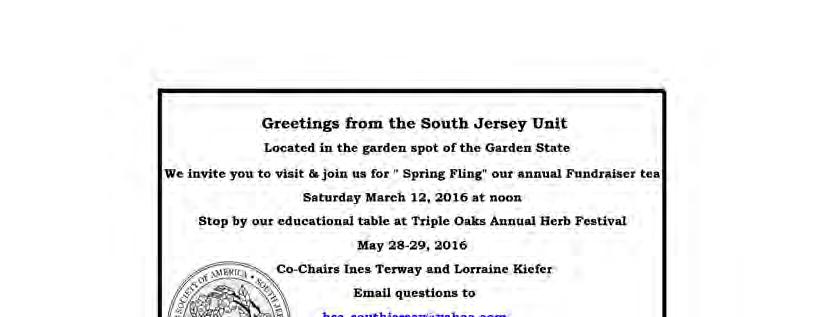
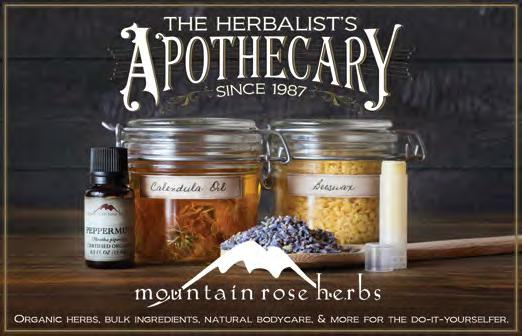
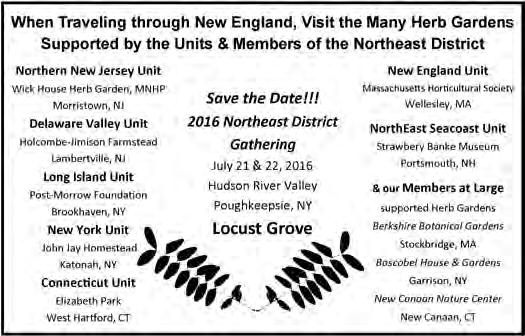

decorate the pages. Go to the website to hear actors reading excerpts from the CD.
$19.95 ($10 per book goes to the Colorado Shakespeare Gardens expansion.)
To order, go to: www.stillroombook.com
CDinside:Fiveactorsread StillRoomBook
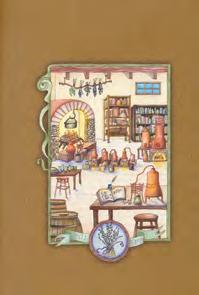
Charlesand Lola Wilcox

WILLKOMMEN TO OUR GARDEN!
The lovely scent of lavender surrounds our garden chimes and enhances the museum murals depicting our town's German heritage.
Contact Info
Email: hsamuthherbunit@yahoo.com
Website: frankenmuthherbsociety.org
76 77 The Herbarist issue 81 2015
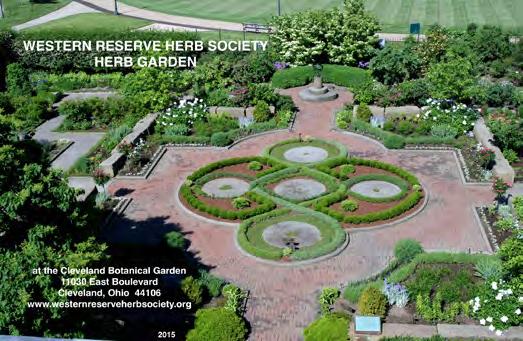



Enjoy our herb study gardens at Cheekwood Botanical Garden and Centennial Park when you visit Nashville, Tennessee.
Enjoy our herb study gardens at Cheekwood Botanical Garden and Centennial Park when you visit Nashville, Tennessee.
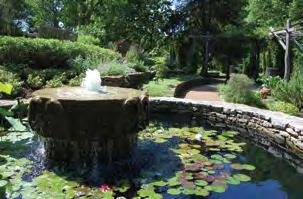
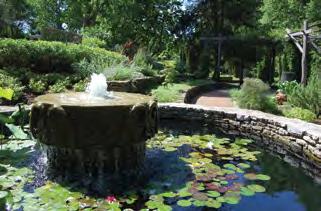
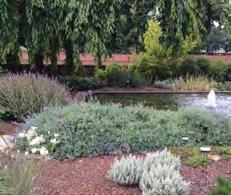
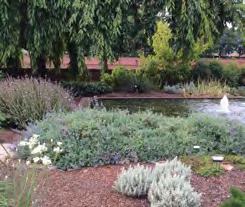
T he h erb S ocieTy of N aShville
T he h erb S ocieTy of N aShville
A Unit of the Herb Society of America
www.herbsocietynashville.org
A Unit of the Herb Society of America
www.herbsocietynashville.org

With the 10th anniversary of Hurricane Katrina, the New Orleans Unit would like to take this opportunity to thank the many people who supported the restoration and rebuilding of our region.
Your thoughts, prayers, financial contributions and volunteer efforts helped us in very meaningful ways.
Come to New Orleans and visit our garden projects: the Walled Herb Garden at Longue Vue House and Gardens and the Salvia Collection at the New Orleans Botanical Garden.
The New Orleans Unit marks its 25th year in 2016 and celebrates its first Rosemary Members!
Congratulations to our Rosemary Members:
AnneAbbott,TupperAllen &JulianneLansing
The New Orleans Unit of
78 79 The Herbarist issue 81 2015
CHEEKWOOD GARDEN PHOTO BY CINDY SHAPTON
CENTENNIAL GARDEN IN AUGUST
CHEEKWOOD GARDEN PHOTO BY CINDY SHAPTON
CENTENNIAL GARDEN IN AUGUST
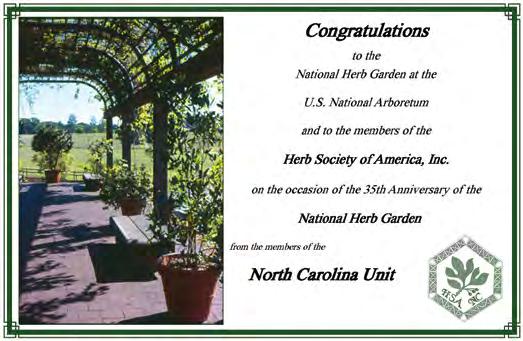

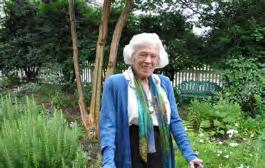
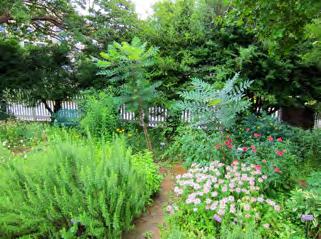

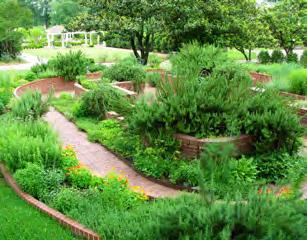

80 81 The Herbarist issue 81 2015 established in 1966 In addition to their mission to further the knowledge and use of herbs, projects of the Arkansas Unit include the design, planting, and continual maintenance of three public gardens: The Mary Fletcher Worthen Medicinal Garden, Historic Arkansas Museum The Garden of Exploration, Arkansas School for the Blind and Visually Impaired The Mansion Herbary, Arkansas Governor’s Mansion Look us up on Facebook as The Herb Society of America Arkansas Unit!
The Herb Society
meetings held at Hillcrest Hall, 1501 Kavanaugh Blvd., Little Rock, Arkansas cfontcu@mac.com
Arkansas Unit of
of America
Happy Anniversary National Herb Garden!
Happy Anniversary to the National Herb Garden!
From your Friends at the Delaware County Unit of HSA!

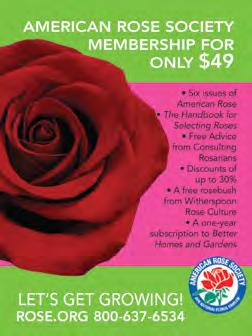


The Conne CT iCuT u ni T
Visit us via click — www.ctuhsa.org or sniff — come to our herb Garden in elizabeth Park hartford, Connecticut

1955-2015 60 years and going strong!

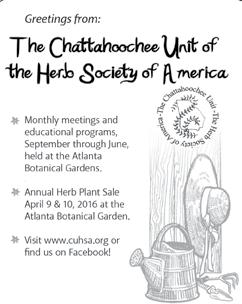
Chicagoua - the herb that gave a great city its name

Greetings from The Northern Illinois Unit of the HSA

We Are Growing, Come Check Us Out!
The Herb Society ofAmerica PhiladelphiaUnit,Inc .
Unit Member Since 1937
✔Updated
Website
www.hsaphiladelphia.org
✔Annual
Herb
Sale
on
Second
Thursday
in
May
✔Visit
our
Historic
Gardens
cared
for
by
our
members:
Fragrant
-‐Tyler
Arboretum,
Media,
PA
Medicinal
-‐
Historic
Yellow
Springs,
Yellow
Springs,
PA
Lavender
Study
-‐
Welkinweir,
PoIstown,
PA
✔Devoted
to
EducaLon
Scholarships
available
to
those
that
qualify
✔Find
us
on
Facebook

82 83 The Herbarist issue 81 2015
tricoccum
Allium
Sharp
*
Capsicum:
2016
Herb
of
the
Year
A.
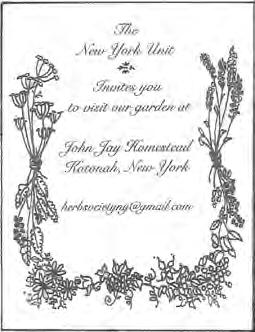
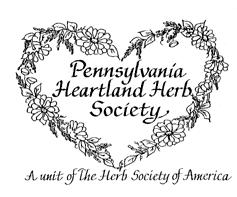

The Long Island Unit maintains the Post-Morrow Herb Garden
Planted with herbs known for their drought tolerance and deer resistance
Located on the south shore of Long Island in the hamlet of Brookhaven, NY

For information about our Unit and Herbal Delights Symposium
Visit our website: paheartlandhsa.org
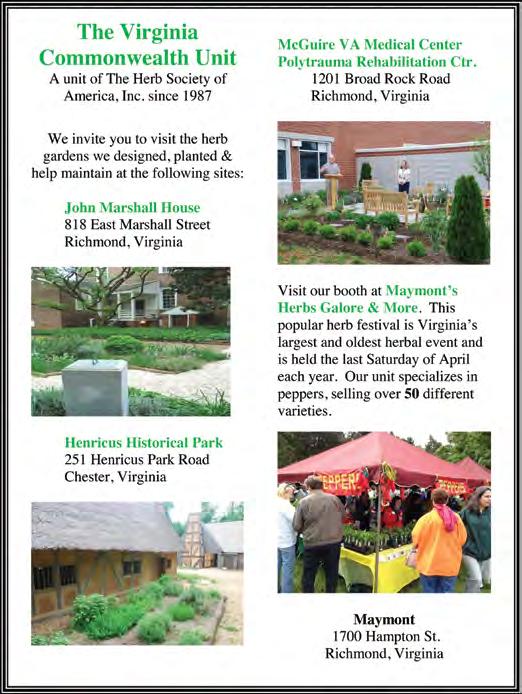
84 85 The Herbarist issue 81 2015
HERBAL DELIGHTS SYMPOSIUM


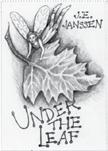

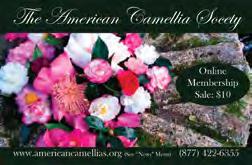
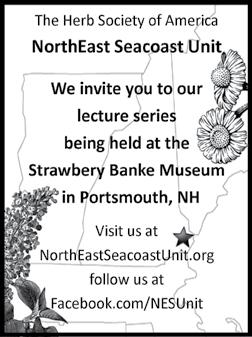
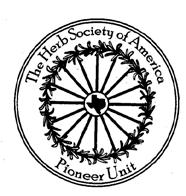
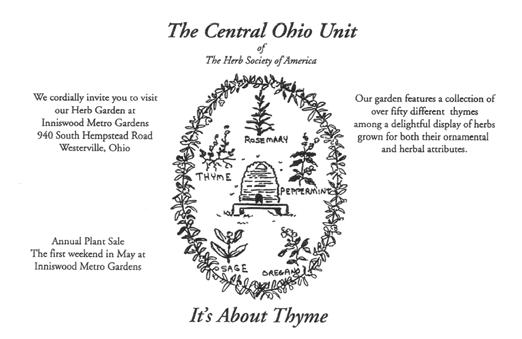
86 87 The Herbarist issue 81 2015 For information on the Herbal Forum please visit herbsocietypioneer.org, festivalhill.org, or call 979 -249-3129 Come Join us at the 21st Annual Herbal Forum at Round Top March 18 & 19, 2016 “Some Like it Hot, Some Not” with a focus on Capsicum, Herb of the Year 2015 Supporting the Herb Gardens at Festival Hill in Round Top and the Brenham Elementary Sensory Garden in the Brenham ISD Outdoor Learning Center The Herb Society of America, Pioneer Unit P.O. Box 23 Round Top, TX 78954 herbsocietypioneer.org Come visit us at our Teaching Herb Garden! If you love herbs, you’ll love our garden! See you soon! The Gardens at Elm Bank are located at 900 Washington Street in Wellesley, MA 02482 ~ For more info, visit neuhsa.org ~ In our Teaching Herb Garden, a beautiful circular bench surrounds the Ginkgo tree, the focal point of our garden. The garden is divided into themed beds, which radiate from the center and highlight: fragrance, dye, culinary, salvia, Native American, medicinal, edible plants and flowers, and door yard themes. Located at the Massachusetts Horticultural Society, Gardens at Elm Bank

DiscoverTheBestSourceFor MedicinalHerbs,Spices,andNaturalRemedies Over400MedicinalHerbs&Spices Capsules,BulkTeas,Powder,Extracts FinestQuality,BestSelection Nature'sWonderlandPremiumVitamins PureEssentialOils,OlbasandMore! BrowseCatalogOnline:Over7,000HealthyRemedies Much PennHerbCompany,Ltd.~www.PennHerb.com~800.523.9971































































































































































 Lois Sutton Ph.D. Editor and Chair of The Herbarist Committee
Lois Sutton Ph.D. Editor and Chair of The Herbarist Committee















































































































